5-Day Tokyo Itinerary for Foodies
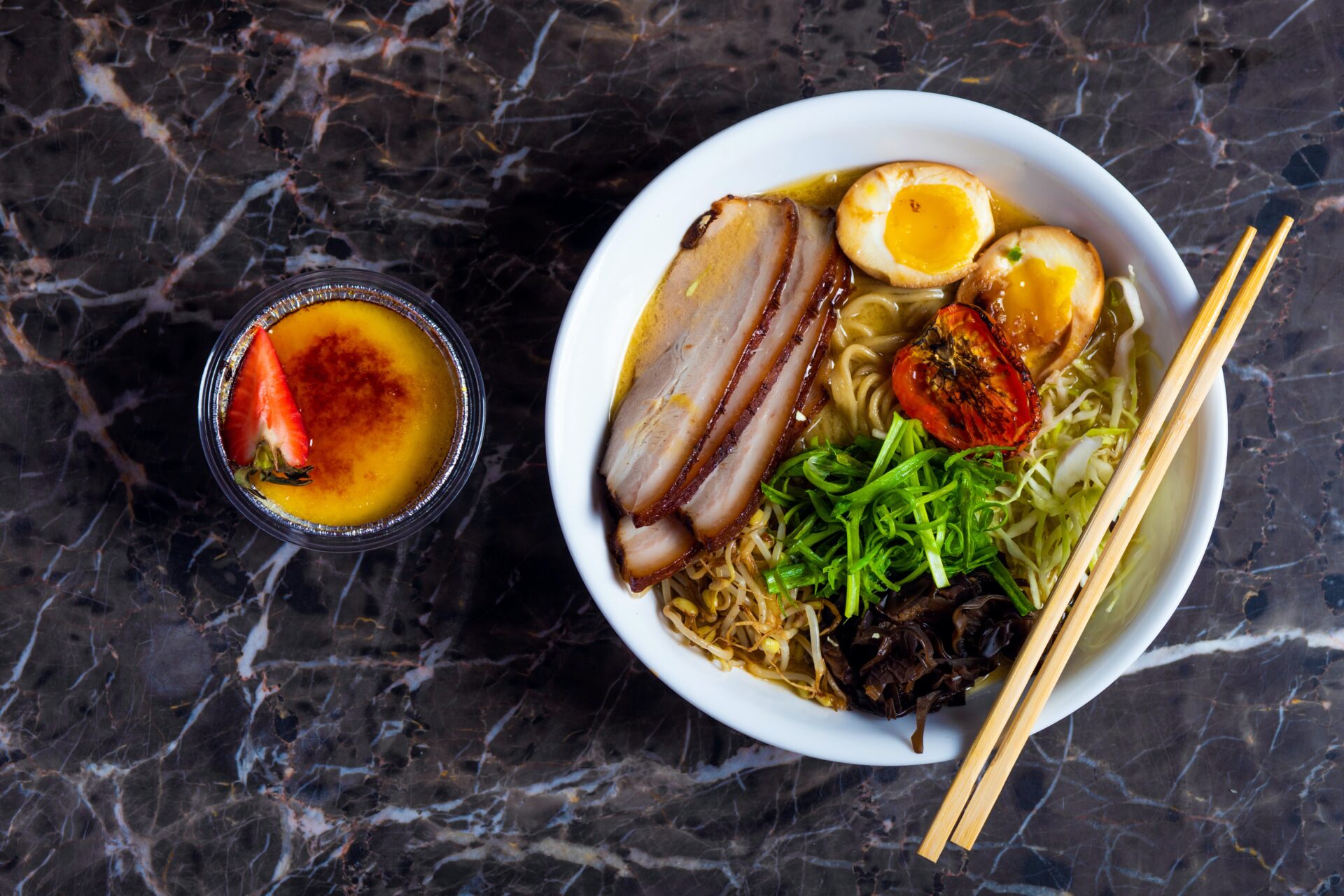
Stefanie Akkerman moved from the Netherlands to Japan in 2013 with her Japanese husband and son. She jumped into the niche of Dutch tour guiding in Tokyo and Kamakura in 2015 and occasionally writes articles about all the great sights and activities Japan has to offer. She loves (Japanese) food, and to work that all off she goes diving, snorkeling, cycling, or hiking.
This post may contain some affiliate links. When you click through and make a purchase we may receive some commission, at no extra cost to you .
One of the best things about being in Tokyo is the city’s food culture. Japanese cuisine is considered one of the world’s most refined and is even designated as intangible cultural heritage by UNESCO, but Japan’s capital is also home to incredible international and fusion restaurants. It’s not for nothing that Tokyo has been the city with the most Michelin-starred restaurants in the world for years. So where to start when you want to make a food-centered itinerary for your visit to Tokyo? Let us help and inspire you with this 5-day plan for foodies who want to go sightseeing while enjoying Tokyo’s diverse food scene to the max!
▼Book our Shinjuku bar hopping tour to make your foodie trip wonderful!


Day 1: Traditional Snacks in Asakusa and Kitchen Utensils in Kappabashi
Day 2: tsukiji fish market & craft beer in yanaka, day 3: sushi making experience & michelin-starred ramen, day 4: fancy lunch in ginza & izakaya hopping in shinjuku, day 5: street food in sunamachi, japan wonder travel tours in tokyo, other articles you might be interested in.
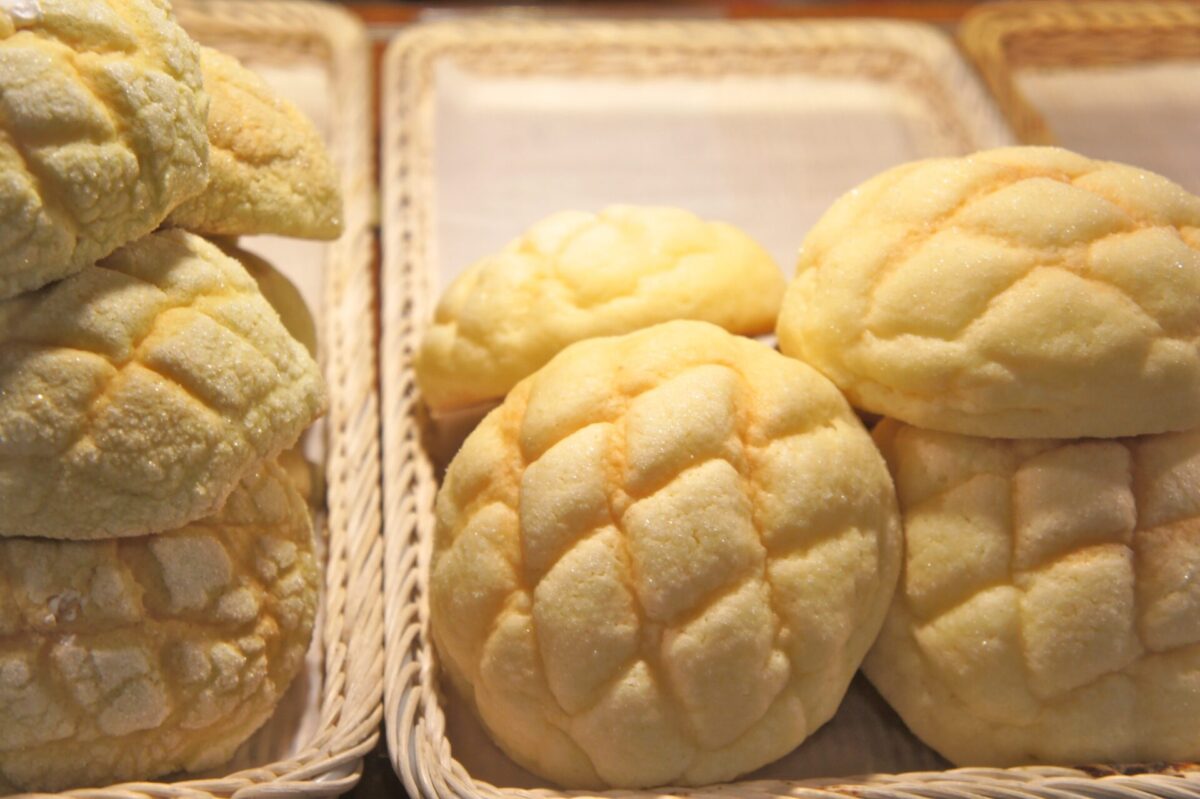
Let’s start our trip with some sightseeing in one of Tokyo’s traditional areas, Asakusa . You can easily spend many hours here looking at the sights, snacking your way through Nakamise and shopping for cute souvenirs. Just strolling through the area’s picturesque streets while browsing the shops for accessories and trinkets, is a lot of fun. Once you start feeling hungry, head over to Nakamise, the area’s central shopping street. There are many vendors here selling all kinds of traditional Japanese snacks and drinks like senbei crackers, amazake , matcha tea, melon pan , and mochi .

After this street food lunch, let’s check out Asakusa’s main attraction: the Sensoji temple. There is so much to see on the grounds of this large Buddhist temple, like the Kaminarimon (also known as the ‘Thunder Gate’), the 5-storied pagoda, the koi pond, the Asakusa-jinja shinto shrine and of course the impressive main hall. And don’t forget to stop by the tourist information center near the Kaminarimon for a great bird’s eye view of the area. Do you love cooking at home? Then you should definitely make a detour through Kappabashi , a street packed with shops catering to restaurant owners as well as hobby cooks, and selling any kind of kitchen utensil you could ever think of.
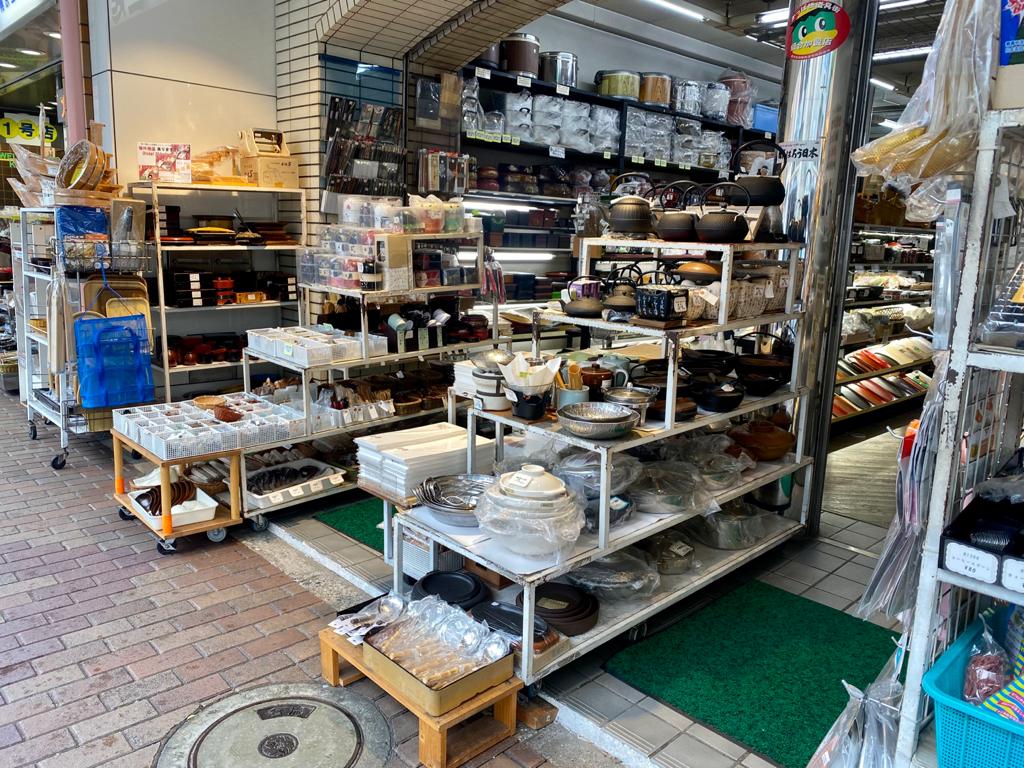
If you’ve walked through Asakusa’s Hoppy Street, you will have noticed the many cozy-looking and semi-outdoor izakaya restaurants. For a real insider’s experience and introduction to these traditional Japanese gastro pubs, you can join our Asakusa local food bar hopping tour for great fun and tasty bites!

A breakfast or early lunch visit to the Tsukiji Fish Market is simply a must-do for any foodie visiting Tokyo. Don’t be fooled by its name, as there is much more for sale here than just super fresh seafood. You might ask: didn’t Tokyo’s famous fish market move to Toyosu a few years ago? Yes, it’s true that the wholesale part including the tuna auction and some of the restaurants have moved from Tsukiji to Toyosu. However, many of Tsukiji’s restaurants and food-related shops chose to stick around, and the so-called “outer market” is still very much a great food destination. The area isn’t that big, but you can easily spend a few hours walking around trying all kinds of snacks, or you can sit down at one of the amazing seafood restaurants. Don’t forget to try the fresh sea urchin, different cuts of tuna, scallops, Japanese-style egg ( tamago ), fried satsuma-age, unagi eel and seasonal fruits with or without mochi. Don’t want to go alone and possibly feel put off by the language barrier? Book our Tsukiji food tour to get the most out of your visit to this superb market!

After this great start to the day, you might feel like moving around for a bit before heading for the next meal, so how about a nice walk in nearby Hamarikyu Gardens ?
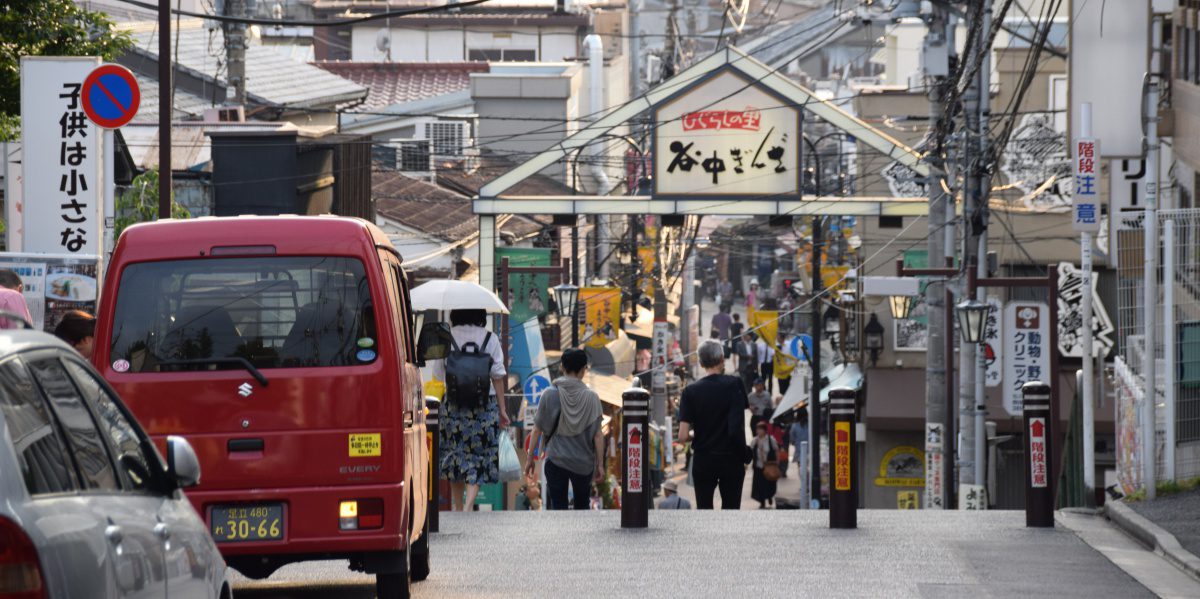
Not far from the garden, you can take the Yamanote line from Shimbashi Station to Nippori Station. On the west side of the station you will find the quaint neighborhood of Yanesen where one can still feel the atmosphere of times gone by as this part of town was spared from most of the WWII firebombings. Once you’ve toured this area you are likely feeling peckish again, so let’s stop by our next foodie spot, Yanaka Beerhall. As the name suggests, this is a great place to try some of Tokyo’s local craft beer, but that’s not all: Yanaka Beerhall serves delectable side dishes which are a fusion of Japanese and international cuisines. If you feel like having a bigger meal, they also have a rotating menu of 5 main dishes that regulars like to come back for time after time.
Yanaka Beerhall : 11am – 8pm (closed on Wednesday mornings and Mondays)

Until now you’ve had the experts cook for you, but how about an expert teaching you how to make your own sushi? During our Sushi Making Workshop & Tsukiji Tour you will first visit the market with your instructor to buy ingredients, then head to the cooking studio to learn how to prepare some mouthwatering sushi. Handy knowledge for when you get home and want to impress your friends or family with homemade sushi. Of course, you get to eat your creations too. In the afternoon we recommend heading to Akihabara to explore some of Tokyo’s many interesting subcultures.
Of course, a foodie trip to Tokyo would not be complete without trying one of the city’s highly acclaimed Michelin-starred ramen spots . Tsuta , the world’s very first restaurant to have received this honor, already lost its star in 2020, but new restaurants took its spot. However, Tsuta is still a very popular restaurant with noodles to die for (and to queue for for a long time). If you want to go to a restaurant that has received a Michelin star more recently, you can visit Soba House Konjiki Hototogisu in Shinjuku where you can enjoy a unique experience that will probably spoil you for life when it comes to noodles. After dinner, there are plenty of opportunities in Shinjuku for nighttime entertainment with the neighborhood being one of Tokyo’s drinking hot spots. Head to Golden Gai for a special experience in one of the tiny bars or just walk around the area to admire its flashing neon signs and throngs of people going about their evening business.
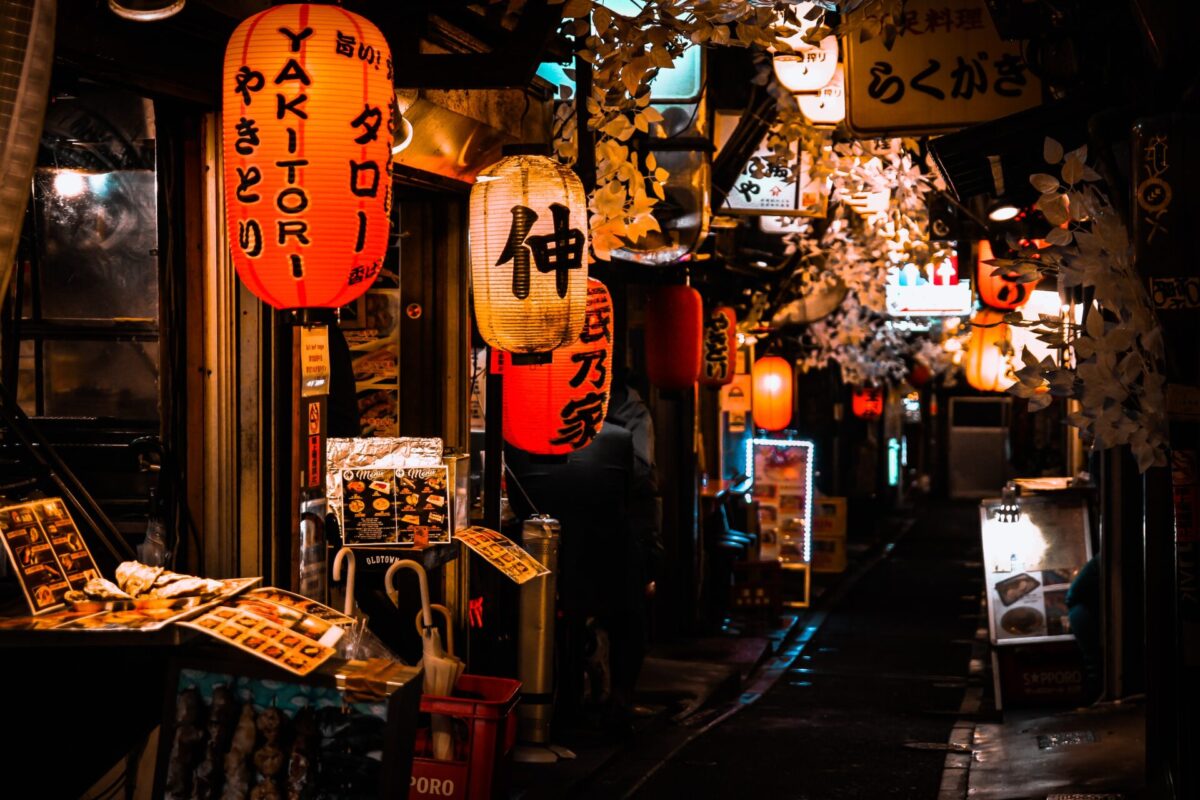
Upscale neighborhood Ginza can be regarded as Tokyo’s version of 5th Avenue in New York or Paris’ Champs-Élysées. Its wide streets are lined with the world’s most famous fashion brands and is a true paradise for high-end shoppers. But this is not all, as Ginza is also home to some of the country’s best restaurants. Having dinner at one of these establishments can definitely be expensive, so what to do if you don’t want to break the bank while still savoring the best of what Ginza has to offer? Going during lunchtime will cut the bill to a fraction of what it would be for dinner, and you will still receive the same high-quality food. Some examples of high-end restaurants with good lunch deals are Ginza Wakuta , Ginza Kushima , and Tateru Yoshino . After lunch, let’s explore Shibuya with its youthful, fashionable atmosphere. One of the world’s most crowded pedestrian intersections is located in Shibuya and is a must-see for anyone visiting Tokyo. If you still have time, you can walk to Harajuku for more youth culture and trendy boutiques. Visit nearby Meiji Shrine and its expansive grounds for some peace and tranquility in the middle of the bustling capital.
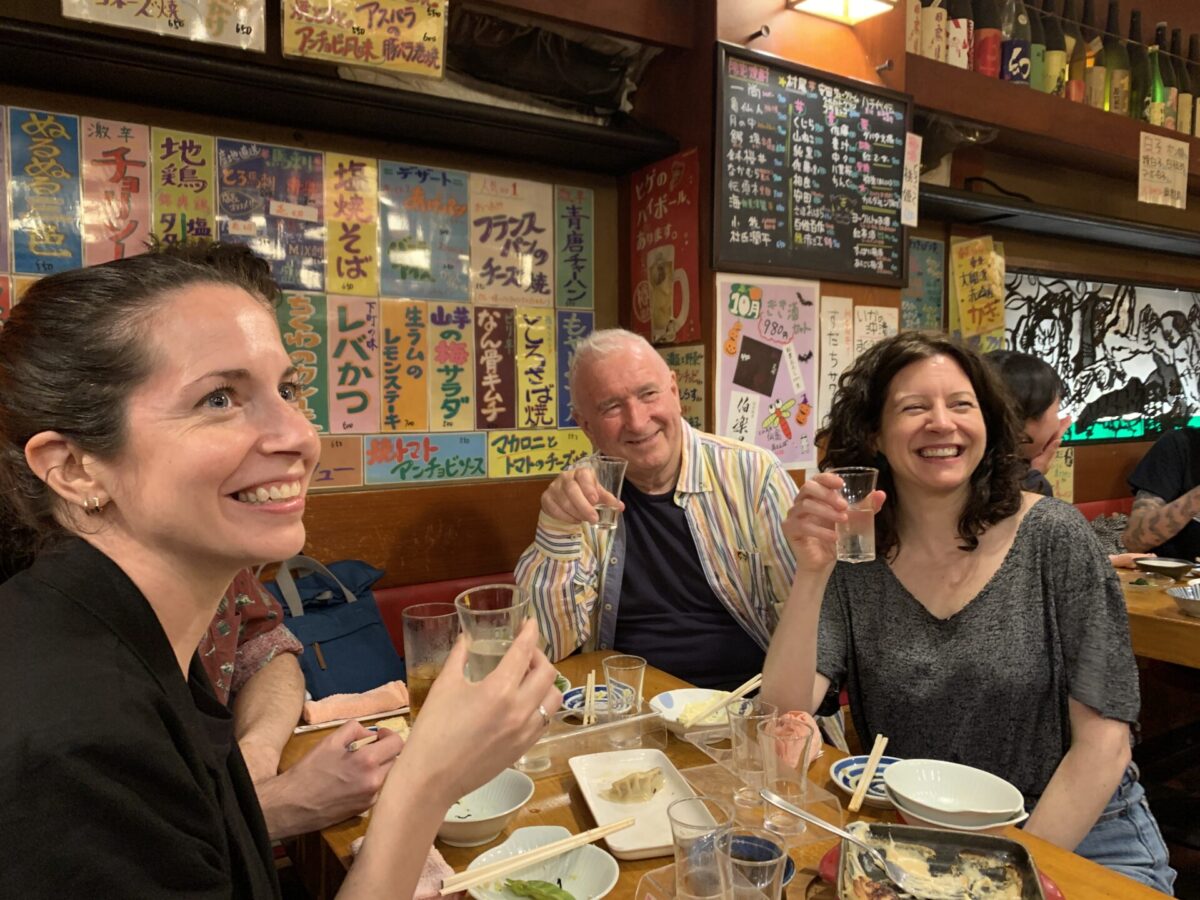
Did yesterday’s walk through nighttime Shinjuku make you want to join in on the fun? Joining an izakaya bar hopping tour together with a local guide is the perfect way to do so! No need to worry about the language barrier, and learning more about what you eat while being in great company of fellow travelers, will make this an evening of long-lasting memories!
On the last day of this foodie’s dream itinerary in Tokyo, let’s go to an old-fashioned local shotengai in the eastern part of the city. Not often visited by large groups of tourists and therefore extra interesting, Sunamachi Ginza is a great destination for savoring some of Japan’s favorite street foods. This street has retained many of its old shops that have been around for decades, and visitors love the retro atmosphere. You can try dishes like oden, yakitori, tempura and unagi eel that have been prepared in a traditional way. There is also an interesting miso store here which is completely dedicated to this Japanese staple condiment.
Would you like to be taken by the hand by a local who is a fellow foodie and will bring you to the best spots in Sunamachi? We offer a Local Street Food and Drink tour in this area that will make your mouth water. While you eat your way through one of Tokyo’s best shitamachi areas, your guide will explain to you everything you want to know about the food, drinks and local culture.
Japan Wonder Travel is a travel agency that offers guided tours throughout Japan. From private walking tours to delicious Food and Drink tours, we can help organize the best tours just for you! If you want to explore Japan and learn more about the history and backstories of each area you are traveling in, our knowledgeable and friendly guides will happily take you to the best spots! In addition, we can provide you with any assistance you may need for your upcoming trip to Japan, so please feel free to contact us if you have any questions or need some help!
▶ Tokyo Tsukiji Fish Market Food and Drink Tour Explore the most lively and popular fish market in Tokyo, where you will have the chance to try some of the local’s favorite street foods and sake along with your friendly English-speaking guide!

▶ Tokyo 1–Day Highlights Private Walking Tour (8 Hours) There’s no better way to explore an area than taking a tour with a knowledgeable local guide. You will have the chance to learn about the history and interesting background stories of Tokyo, as well as discover some hidden gems which can be hard to do without a guide.

▶ Shinjuku Bar Hopping Tour: Experience Tokyo’s Nightlife in Izakaya Check out the best spots in Shinjuku while bar hopping through the lively and vibrant area. Try some delicious local food and drink as you explore the narrow yet photogenic alleys that the town has to offer. Experience Japanese izakaya culture and drink in Shinjuku like the locals!
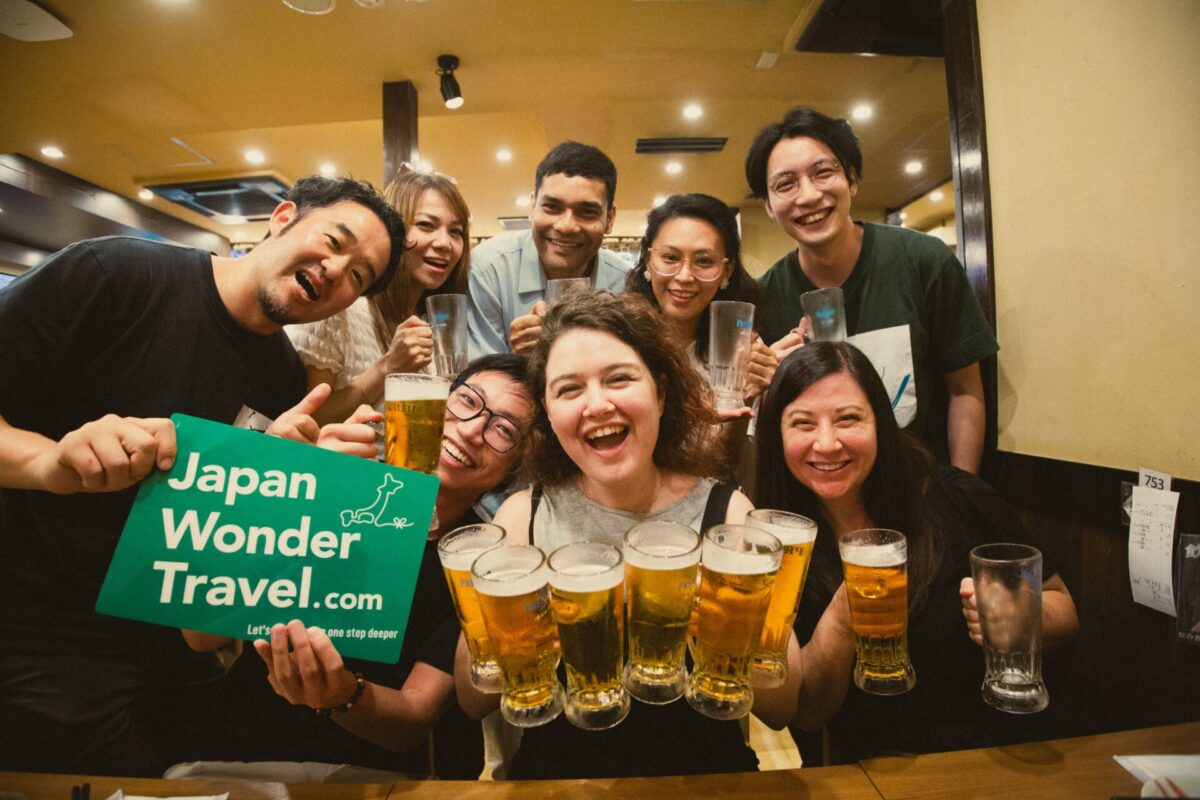
Follow us on Instagram , Facebook , Twitter , and TikTok for more travel inspiration. Or tag us to get featured!
Happy traveling!
Stay informed of the best travel tips to Japan, the most exciting things to do and see, and the top experiences to have with the Japan Wonder Travel Newsletter. Every week we will introduce you to our latest content.
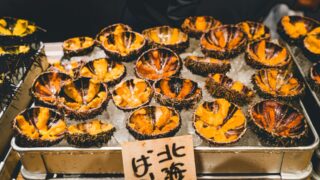
- Popular destinations
- Hidden places in Japan
- Tours and workshop
- Food and drink in Japan
- Itinerary in Japan
- Places to visit in Tokyo
- Food and drink in Tokyo
- Seasonal events
- Tours & workshops
- Tokyo This Week
- Day trip from Tokyo
- Itinerary in Tokyo
- Places to visit in Kyoto
- Food and drink in Kyoto
- Itinerary in Kyoto
- Day trip from Kyoto
- Travel tips
- Accommodation
- Cultural tips
- Transportation
- Tokyo Tours
- Kyoto Tours
- Kimono Rental
- Fukushima Tours
- Mount Fuji Tours
- Tour Package
- Media Kit(English/日本語)
Truly Tokyo
A Tokyo Travel Guide
Tokyo Foodie Itinerary
This one-day Tokyo foodie itinerary takes you through some of the highlights of Tokyo’s vast culinary scene. It includes the famed Tsukiji Market, fabulous snacks, the best pizza in Tokyo, and glorious Japanese beef.

Tokyo Foodie Itinerary: A Few Things to Keep In Mind
- Besides yatai in Fukuoka, or festival food, Japanese street food culture is not at all comparable to, say, Southeast Asia. Besides ice cream and handheld crepes, it’s quite rare to see anyone eating while walking on the street. What you can do, however, is pick up small snacks and find a quiet bench or park to eat.
- Markets here are usually working markets. The shopkeepers cater to locals and regular buyers first and foremost, and while tourists are generally welcome these days, it’s important not to disrupt business. If you do wish to take photographs, ask first, and be discreet and respectful about it. If there’s a sign that says don’t take photographs, respect it! And don’t bring your suitcase into the market - it’ll make already crowded places even harder to navigate for you and for everyone else.
Check Hotel Availability
Destination, check-in date, check-out date.

- Grazing and snacking at many different places is going to generate a lot of plastic waste. Circumvent the plastic wherever possible. Bring your own cutlery and handkerchief, and ask the shop staff not to give you any. Refuse the plastic bags that each and every snack will be put in. Forgo your straws and forget the lid on your takeaway latte. Even better - ask them to put it in a cup and have it in store. Every little bit helps.
- We’ve put directions to each location in this itinerary AFTER the location to avoid cluttering things up.
- Finally, we’ve put all of the places listed here, and the walking routes in each area, on a special map of this itinerary. Scroll down to the end of this itinerary to view the map.

7:45am Tsukiji Market
This is where the raw materials for Tokyo’s culinary dreams come from. If you must queue for a breakfast of sushi, this is the time and place to do it. There’s nothing like beginning your day with fresh, sweet, raw fish.

Although the central wholesale market has been moved to Toyosu as of October 2018, there’s still plenty to see and eat in the Outer Market. Make a beeline forまぐろや黒銀 Maguroya Kurogin , and start queuing. If you’re with a friend, make them stand in line while you run a few stalls down to丸武 Marutake for a tray of tamagoyaki, or Japanese-style omelette. Each slab of omelette is warm and straight from the pan, at once sweet and savoury, eggy with a hint of mirin (sweet rice wine). It is a damned good snack to whet your appetite while you wait.
Maguroya Kurogin is all about the bluefin tuna. There’s all manner of rice bowls and nigiri-style sushi (rice with slices of fish on top) featuring this ocean god. Get their famous magu-roll (tuna hand roll). Think 4 pieces of piscine heaven: goodly amounts of tender, raw, hand-chopped tuna, held together with just the barest amount of rice and seaweed.
But we’re just getting started. Order a rice bowl to follow your magu-roll. You could live large and order the otoro (fatty tuna), but even less oily cuts like chutoro (medium fatty) and akami (lean) will have you swooning. Negitoro is also a fabulous choice: hand-chopping is the key to its luscious texture here.
Finish up here and walk through the market along this street. Sample what you can, and duck into side streets and alleyways if you must, but ultimately, you should keep going. Look for にっしん太助 Nisshin Tasuke , a freshwater eel specialist further up the road on your right.

You could sit down for an entire unagi rice bowl, but if you haven’t the time nor inclination, grab yourself a couple of skewers. The liver is not at all bad, but the prize here is the classic eel skewer. Dipped in marinade and briefly warmed again on the charcoal right before you, its mackerel-like, oily, flaky flesh makes a fantastic snack. It’s also perfect for eel beginners.

Just adjacent to Nisshin Tasuke is a corner shop with a permanent queue in front of it and a display full of candy-colored confections with strawberries on top. Welcome to Soratsuki . It’s hard to go wrong with a snack like freshly pounded mochi (rice cakes). Try the custard-filled mochi - it’s soft and pliant, with thick, oozing custard within.

Once you’re done exploring this street (and the rest of the market, if you’re so inclined), walk out towards the main road and turn left. You’ll find yourself at 伊勢啓 Isekei, an old-school purveyor of katsuobushi - skipjack bonito flakes. It’s time to sample some, and pick up a bag if you’re serious about cooking. These innocuous papery pieces that look like pencil shavings are used to make dashi stock, and they are at the heart and soul of Japanese cuisine. There are a few shops around Tsukiji Market, but the freshly-shaved handfuls of honkare katsuobushi here have an especially smoky, meaty soul to them, as though they’ve been sprayed with some fabulous soy sauce. It’s a far cry from the papery plastic-wrapped stuff at the supermarkets.
If you'd like to explore this area with an expert guide, check out Chris Rowthorn Tours' Tsukiji Fish Market Tour .
Tsukiji Market Directions:
Take the Hibiya line to Tsukiji Market. Exits 1 and 2 are the nearest to the Outer Market. From Exit 1 [coming from Ginza], turn left once above ground, and follow the signs to Tsukiji Market, walking along the main road. A good indication is also to follow everyone else. Eventually, you should see a Jonathan’s family restaurant on the opposite corner. Cross the road to reach the covered shopping arcade marking the perimeter of the Outer Market. To find Maguroya Kurogin, walk under this arcade until you reach the corner of the junction. Turn left and it’s on the corner of the next street parallel to the main road. Marutake is a few stalls down in the direction you’ll be walking in. Nisshin Tasuke is towards the top of the narrow road lined with shops and restaurants, also parallel to the main road.

9:00am Turret Coffee, Tsukiji
It’s time for a post-prandial digestif. Luckily, the espresso-based pours at nearby Turret Coffee are some of the best in the metropolis. A short latte was wonderfully full-bodied and smoky - if cigarettes tasted like this I’d be hooked. The classic Turret iced latte, equally delicious and smoky, will do you good on a hot summer day. Have your drinks inside to avoid generating more paper cup wastage.
Turret Coffee Directions:
From the Outer Market, cross the road diagonally, walking back towards Exit 2 of Tsukiji Station. Keep walking past it until you see a Starbucks on your left. Turn into the road; Turret Coffee is a few doors down. Opening near Starbucks - what a bold move!

10:00am Ginza Kimuraya, Ginza
Coffee is a fantastic digestive. By now, you’ll have digested breakfast - right? Make your way to Ginza for your next snack at Ginza Kimuraya . Their melon bread, or melon pan, is some of the best Tokyo has - wonderfully fluffy bread with an addictive sugary crust. Even better is their melon pan filled with melon-flavored cream.
Don’t forget to also pick up one or two of their best-selling anbata-pan (azuki bean butter bread) and put it in your bag for later. Trust me on this.
Ginza Kimuraya Directions:
Return to Tsukiji Station and take the Hibiya Line to Ginza Station. Take Exit A9 and you’ll see Kimuraya right outside. Alternatively, if you’re not hungry, skip Ginza and head straight to Nakameguro - see below.

10:30am Mitsukoshi Food Hall, Ginza
By now, Ginza’s famous department stores are starting to open their doors to the public. Head to Mitsukoshi Ginza right opposite for your next culinary adventure. Like any department store worth its salt, it has a food hall and a separate supermarket floor, and are they ever impressive. The sheer range of offerings is mind-boggling: truffles, honey tarts, wine-stewed chicken liver, eclairs, mounds of salad, freshly-fried croquettes, boxes upon boxes of individually-wrapped confections, a cornucopia of pickles, gorgeous fruits, rice crackers, far more bottles of sauces and seasonings than there are corrupt politicians in the White House. You’re on holiday. Eat it all.
New York’s Dominique Ansel Bakery has an outpost here, with almond croissants the size of your face, coffee bread in the shape of coffee beans, and the all-important giant cronuts. No one’s that crazy about cronuts anymore, but if you didn’t get one years ago when the hype was huge, this is as good a time as any to try one. Weekly or fortnightly pop-ups at department stores are also common, meaning that there’s always something new to look forward to on each visit.

A super fun snack I came across: shiitake mushrooms stuffed with minced prawn, deep-fried until just cooked and still juicy, sprinkled with salt. Fabulous straight out of the fryer, strictly for those without mushroom phobia.
I also love food halls for the range of salads. R1F Sozai has outposts at many food halls in department stores, specializing in consistently fresh, inventive, and delicious salads sold by the 100g. Think, for instance, slippery, delightfully crunchy seaweed salads with baby fish and ginger juice dressing, or creamy avocado, chicken and basil salads.
But my favorite thing by far to eat at Mitsukoshi Ginza is the 月見つくね tsukimi tsukune, or moon-viewing meatball, at 和四五郎 Washigoro . (How romantic!) This is Japan’s answer to the Scotch egg. Think a golf ball-sized hunk of minced chicken, grilled and liberally glazed with a sweet-salty sauce, a whole egg inside. The yolk always, always, oozes perfectly. Step aside, Scotch egg – Japan just does it better.
Mitsukoshi Ginza Directions:
From Kimuraya, cross the road and enter Mitsukoshi Ginza, which opens at 10:30am. Head down to B2 for the food hall. Any food purchased can be consumed on the 9th floor, home to a lovely open rooftop patio and field for chilling out.

11:30am Seirinkan, Nakameguro
Nakameguro is Tokyo hipster heaven. It has a ridiculously high concentration of quirky, arty bookstores, independent craft shops, and clothes labels that all look like they belong in Kinfolk. It is also the home of the pizza gods. You might be in Tokyo, but pizzerias here give Italy a damned good run for its money. Enter Seirinkan , an entirely unassuming restaurant in the backstreets of Nakameguro that serves up one of the best pizzas you will ever eat in your life .
There are side dishes and snacks, sure, but you know Seirinkan is serious because they have just two choices of pizza - the margherita and the marinara. Both are ferociously good. The wood-fired crust is gorgeously charred, with a perfect, lightly springy pull when you tear at it with your incisors, with fine flecks of sea salt in every bite. On average, I never eat pizza crusts without the topping; here, nothing is left on the plate. Here, it is all about the crust.
The margherita is one of the finest examples I’ve ever eaten, with perfectly fresh and creamy mozzarella. The marinara pizza is liberally drenched with a puddle of sweet roasted tomato sauce and slivers of garlic, all of it singing summer in your mouth, transporting you to Italy with a single bite. No element of the pie is overlooked.
If you have to choose, don’t. Eat both. You’re witnessing the pinnacle of pizza craftsmanship, and it is your duty to consume its fruits.
Seirinkan, Nakameguro Directions:
Head down to Ginza Station, accessible from B1 of the department store. Take the Hibiya Line from Ginza Station all the way to the end of the line at Nakameguro Station. Take the South Exit. Seirinkan opens at 11:30am, and there may be a short queue by the time you arrive. Arriving before noon is generally a good idea to be seated sooner. Once you’re in, ordering is simple.

2:00pm Onibus Coffee, Nakameguro
More coffee? But of course. A favourite with coffee fanatics in the city, this charming coffee stand in Nakameguro keeps it simple with coffee, coffee, and more coffee on the menu.
When we visited, the iced coffee was a deeply smoky yet juicy roast that tasted like late nights in an underground blues bar, complete with ragged baritone songs and cigarette smoke clinging to your hair. Perfect for a warm spring day.

To go with your coffee, it’s time to bust out the snack from Kimuraya you’ve been saving for this moment - the anbata pan. A dollop of creamy whipped butter alongside and inside the fluffy bread adds that requisite lightness, making a beautiful counterpoint to the sweet red bean paste, preventing it from being too cloying. It is one of those genius East-West fusion confections that just work. Consider red bean haters like me sold.
Onibus Coffee Directions:
Onibus Coffee, near the train tracks, is a quick 2-minute walk from Seirinkan.

3:00pm Japanese Ice Ouca, Ebisu
3 o'clock in the afternoon is oyatsu no jikan in Japan - otherwise known as snack time. What better way to mark this hour than ice cream? Get thee to Japanese Ice Ouca , a stylish ice cream parlor a short walk away from Ebisu Station.
The style of scoop here is lighter and decidedly creamy, each flavour quietly asserting itself. I love the kinako (roasted soy bean flour) ice cream here - it's deeply, delightfully nutty. But the real genius is in the way the ice cream is served. At Ouca, each serving of ice cream comes with strands of salted kelp, which act as palate cleansers between each sweet, blissful mouthful.
Japanese Ice Ouca Directions:
Ouca is 20-25 minutes’ walk from Nakameguro, or a short train ride from Nakameguro Station. To get there by train, take the Hibiya line one stop to Ebisu Station. It’s a short 2-minute stroll from the west exit of JR Ebisu Station. They’re happy for you to sample some of the flavours if you can’t make up your mind.

4:00pm Nanaya Aoyama, Shibuya
One ice cream is not enough - a productive day of eating demands at least two. Your next stop is Nanaya .
A purveyor of primarily tea-based gelatos, Nanaya is most famous for their 7 different matcha-flavoured scoops, labelled 1 through 7. The higher the number, the higher the proportion of matcha powder - and the concentration of flavor. You are, of course, here for No. 7. Nothing else comes close. (Okay, the black sesame is pretty good.)
If tea can be thrilling, No. 7 certainly is. I felt like I was back at a tea ceremony in Kyoto all over again drinking koicha, the thick matcha tea that marks the climax of the entire ritual. It’s so viscous it has the consistency of rapidly-cooling lava. Nanaya’s No. 7 is koicha in gelato form - an intense blast of matcha that will ruin all other green tea ice creams for you.
Nanaya Aoyama Directions:
Return to Ebisu Station and take the 田87 bus bound for Shibuya Station. Alight at the Namikibashi stop. From here, it’s an approximately 10-minute walk away. Or, live large and hop into a taxi. So far, no sampling is possible at Nanaya.

6:00pm Ningyocho Imahan, Shinjuku
After an afternoon of snacking, you’ll need something simple, satisfying, and luxurious enough to make further eating worth it. And there are few better meals that fit the bill than sukiyaki.
Sukyaki is uncomplicated: thin slices of beef are slowly simmered in a blend of soy sauce, sugar, and sweet rice wine in a shallow pot, alongside fresh vegetables, tofu, and tangles of konnyaku noodles (devil’s tongue noodles). But all that means is that there's little to hide behind. Everything hinges on the quality of each ingredient.
One of the best, most accessible places for great sukiyaki in Tokyo is the old-school Ningyocho Imahan , which has multiple branches across the city. Their sukiyaki is consistently and uniformly excellent. The ‘quality’ beef selection is good; but the ‘high quality’ sukiyaki will send you into paroxysms of pleasure. Think palm-sized slices of lavishly marbled Japanese beef simmered in a sweet-salty sauce until just cooked, dragged through a puddle of raw egg yolk. It is as glorious as it sounds.

Ningyocho Imahan Directions:
Walk to Shibuya Station and take the Yamanote Line to Shinjuku Station. Find the Takashimaya branch of Imahan on the 14th floor of Takashimaya Times Square nearest the Southeast Exit. At 6pm, there is not particularly likely to be a queue. Reservations are possible - ask your concierge.

8:00pm New York Bar, Shinjuku
It’s time to finish your day in style. Head to the Park Hyatt and re-enact your very own Lost in Translation moment with cocktails at the sky-high New York Bar .
Classic drinks abound, as well as plenty of non-alcoholic options, but you’ll want some space to try the Japanese cocktails. The Rin, made with white wine, yuzu shrub, soda water, and the gorgeously flowery ‘Roku’ craft gin, is something real special.
New York Bar Directions:
Take a taxi from Takashimaya Times Square to New York Bar. Otherwise, it is a 20-minute walk.
About the author: Florentyna Leow is a writer and photographer based in Tokyo. When she's not eating or roaming the streets for food, she can be found with a book and pen in hand. Her work has appeared in Lucky Peach, Roads & Kingdoms, and Kyoto Journal. Her photographs can be found at @furochan_eats , @doorwaysofasia , and @lovemeleafme on Instagram.
Many thanks to Kat Chetram for hand modeling and photography assistance.
Tokyo Foodie Itinerary Map
The Foodie Itinerary map shows the location of each of the places mentioned - you can view a full screen version too.
Tokyo Vacation Checklist
- For all the essentials in a brief overview, see my First Time In Tokyo guide
- Check Tokyo accommodation availability and pricing on Booking.com and Agoda.com - often you can book with no upfront payment and free cancellation
- Need tips on where to stay? See my one page guide Where To Stay In Tokyo
- You can buy shinkansen (bullet train) tickets online from Klook - popular routes include Tokyo to Kyoto , Tokyo to Osaka and Tokyo to Hiroshima
- You can buy a Japan SIM card online for collection on arrival at Tokyo Narita or Haneda airports. Or rent an unlimited data pocket wifi router
- See my comprehensive Packing List For Japan
- Compare airline flight prices and timings for the best Japan flight deals . Check my guides to arriving at Narita Airport and at Haneda Airport .
- If you're visiting more than one city, you might save money with a Japan Rail Pass – see if it's worth it for you
- A prepaid Welcome Suica card makes travelling around Tokyo much easier - here's how
- World Nomads offers simple and flexible travel insurance. Buy at home or while traveling and claim online from anywhere in the world
Tokyo District Map

- Imperial Palace Area
- Tokyo Station
- Shimbashi Shiodome Hamamatsucho Shinagawa
- Akihabara Kanda
- Roppongi Akasaka
- Harajuku Aoyama
- Ebisu Daikanyama Meguro
Disclosure: trulytokyo.com is a participant in the Amazon Services LLC Associates Program, an affiliate advertising program designed to provide a means for sites to earn advertising fees by advertising and linking to amazon.com and amazon.co.uk. World Nomads provides travel insurance for travellers in over 100 countries. As an affiliate, we receive a fee when you get a quote from World Nomads using this link. We do not represent World Nomads. This is information only and not a recommendation to buy travel insurance.
- Tokyo Cheapo (繁體中文)
12 Best Tokyo Food Tours
Tokyo is full of amazing food, but when you have limited time to try everything, you want to be sure you’re making the most of it. That’s why we’ve put together this list of the best food tours in Tokyo.
Although food tours can seem pricey, you’ll save time looking up the best spots to eat, you’ll get a ton of food to make up for it, and you’ll even learn some cultural and historic background to make the experience more meaningful.
From a tour of the original Tsukiji Fish Market to bar-hopping and family-friendly and vegan tours, here are 12 great ways to explore Tokyo’s food scene.
1. Tsukiji Fish Market Food and Culture Walking Tour
Price: From ¥ 15,276 Area: Tsukiji Duration: 3 hours Book online

It’s not just fish that’s on offer at Tsukiji Market in Tokyo . Walk through the lively market food stalls of the Outer Market, and taste everything from freshly-seared wagyu beef to premium tuna sashimi on this insightful tour.
Along the way, you’ll learn about the history and culture of the Tsukiji area. Bring your walking shoes, and be prepared for a bit of day drinking, too!
Note: The actual wholesale fish market, or Inner Market, with its world-famous tuna auction, relocated to the nearby Toyosu Market in 2018.
2. Kawaii Food Tour in Harajuku
Price: From ¥ 20,000 Area: Harajuku Duration: 3.5 hours Book online

The cute pinks and pastel colors are everywhere in Harajuku, and that includes the food. Think pastel-colored cotton candy, animal cake pops, dessert crepes — anything and everything cute, Harajuku has it.
Though this fun Tokyo food tour is geared towards those with a sweet tooth, there are also savory dishes, too, complete with an okonomiyaki (savory pancake) lunch in an artsy restaurant.
3. Tokyo Bar Hopping Night Tour in Shinjuku
Price: From ¥ 16,900 Area: Shinjuku Duration: 3 hours Book online

Visiting Japanese izakaya (local bars or pubs) is a must for any Tokyo traveler, but it can be tricky to find a good one on your own. Many of them are hidden in alleyways or areas you might not think to visit, so this intimate tour takes out the guesswork.
Small izakaya are a great way to experience Japanese food and drink you won’t get elsewhere. This tour ensures you get a seat at the best spots in Shinjuku.
4. Ramen Tasting: Mini Bowl Ramen Tour
Price: From ¥ 17,000 Area: Multiple areas, starting in Shibuya Duration: 2-3 hours Book online

Ready for ramen ? This soupy noodle dish can be very filling, so a ramen tour might seem somewhat ambitious. But Tokyo Ramen Tours has found a way around that, with six mini bowls of award-winning ramen.
On this Tokyo food tour, you’ll walk between three different ramen spots in three different neighborhoods, while learning about both the history and modern world of ramen. You’ll realize just how different each bowl can be, and maybe find your new favorite style. The walks in between will make you feel like you’ve earned each one, too!
5. Tokyo West-Side Walking and Street Food Tour
Price: From ¥ 15,000 Area: Nakano and Koenji Duration: 2 hours Book online

While Tokyo has some great street food areas, the best spots can seem strangely hard to find. This tour takes you out of the crowded streets of Tokyo’s main tourist areas to Nakano and Koenji, for some more traditional tastes.
From fluffy imagawayaki (traditional filled cakes) to freshly made shumai dumplings, get ready to walk up an appetite in these lesser-known spots.
6. Mochi and Traditional Sweets Making with Tea Ceremony
Price: From ¥ 12,000 Area: Meguro Duration: 2.5 hours Book online

If you want a more hands-on experience, this family-friendly Japanese sweets class is a great way to let out your creative side.
The instructor will guide you through every step of the process, from making the perfect rice dough to the fine techniques of decoration. Round off the day by tucking into your creation with a steaming bowl of matcha tea.
7. Asakusa Family-Friendly Tour: Sensoji, Nakamise, and Food
Price: From ¥ 21,208 (children are free) Area: Asakusa Duration: 4 hours Book online

The downtown area of Asakusa is a popular place to get a taste of traditional Tokyo, in this case, literally. On this tour you’ll get to try a whole range of foods, from beef and tempura to snacks and desserts.
During this family-friendly walking tour, you’ll also visit various important cultural and historic spots, including the iconic Kaminarimon Gate of Sensoji Temple . And if you have picky kids, there’s good news for you, because children can join for free.
8. Sumo Tournament, Chanko Nabe, and Culture in Ryogoku (Seasonal)
Price: From ¥ 30,705 (different seat packages available) Area: Ryogoku Duration: 8 hours Book online

Although this full-day tour is a bit pricier than the others on our list, it’s not without good reason. The ticket includes seats to a live sumo match, with an expert guide.
The tour starts with a stroll around the nearby shrines and sumo training stables, before filling you up with a traditional sumo hotpot known as chanko nabe . After that, it’s time to sit back and watch some live sumo wrestling.
Note: This tour is only available during the Grand Sumo Tournament season. Read more about how to see sumo in Tokyo .
9. Tokyo Ninja Food Experience
Price: From ¥ 6,200 Area: Asakusa Duration: 2 hours Book online
Go on a secret mission to the Ninja House restaurant in Asakusa, on this family-friendly food experience.
At the Ninja House, you’ll put on a ninja outfit and learn the ways of these ancient Japanese spies through ninja training and sword skills, before refuelling with a ninja-themed meal. You’ll also find options for various dietary requirements, such as vegan and halal meals.
10. Make Your Own Ramen and Gyoza in Asakusa
Price: From ¥ 13,200 Area: Asakusa Duration: 3 hours Book online

There’s so much great ramen in Tokyo, it’s a shame you can’t take it all home. But this tour allows you to take home the skills to make it for yourself.
The three-hour class is held at a venue on the historic Kappabashi Kitchen Street in Asakusa, and your cooking instructor will show you how to make everything from the ramen noodles themselves to a side dish of perfectly folded gyoza dumplings.
11. Vegan / Vegetarian Ramen Tour in Tokyo
Price: From ¥ 13,000 Area: Shibuya Duration: 2 hours Book online

Although vegan and vegetarian options are growing in Tokyo, it can still be difficult to find a good bowl of plant-based ramen without going to a chain restaurant. But on this tour, you get to try four (bowls, that is)!
The speciality food tour was created by Frank, a local ramen expert who eats an insane 300-400 bowls of ramen per year. His tour features two Hokkaido-style bowls of ramen and two modern fusions, and can also be made non-vegan for other friends to tag along.
12. Vegan and Gluten-free Trendy Walking Tour in Tokyo
Price: From ¥ 11,000 Area: Shibuya and Harajuku Duration: 5 hours Book online
Explore the streets of Shibuya and Harajuku to try out some of the latest vegan treats in the capital.
You’ll start off with a visit to a vegan bistro, before hydrating with some fresh juice. Then walk around to explore the town, visiting some of the famous parks and working up an appetite for steaming vegan ramen. Finish it all off with a drink and a bite or two at a specialized vegan izakaya . Don’t worry, there will be sweets and snacks along the way, too!
While we do our best to ensure it’s correct, information is subject to change.
- Family friendly
- Fish market
- Gluten-free
- Japanese food
- Tsukiji Fish Market
- Walking tours
Get our Tokyo Cheapo Hacks direct to your inbox

TOP 20 Things to Do in Shinjuku, Tokyo

Beginner's Guide: Where to Buy Anime Merch in Tokyo

The Best eSIMs for Visiting Japan

Hidden Gems: 4 Unique Tokyo Bars You MUST Try!

Tokyo's Best Airport: Flying into Narita vs. Haneda

Top Things to do in Odaiba: Gundam, Museums & Tokyo Bay

Renting a Pocket Wifi Router in Japan: The Best Options

Tokyo Events This Week: Bon Odori, Ghibli Exhibition, and Drag
Tokyo events for Monday, June 24 to Sunday, June 30, 2024.

Complete Guide to the Akita Shinkansen
Routes, rail passes, recommended stops — and more.

Mount Fuji's New Rules: What You Need To Know
All the new fees, regulations — and reservations.

New Video! Hidden Gems: Where to Buy Unique Souvenirs in Tokyo
Looking for something different to take home to friends and family?

7 Accessible Places To Visit in Tokyo
Temples, museums, robot cafés and more.

New Video! What to do on a Rainy Day in Tokyo
If it rains in Tokyo during your holiday, don't stress, take a look at these things to do indoors.

Choosing Travel Insurance for Japan
A quick look at the options.

Ultimate Guide to the Yamagata Shinkansen
The only thing you need to read about this bullet train.

New Video! Where to Buy Anime Merch in Tokyo
From vintage anime goods in Nakano Broadway to official merch and secondhand stores.

Close without accepting

10 BEST Food Tours in Tokyo, Japan
This post contains product affiliate links. These are mainly on items/hotels/tours that I personally endorse & love. I may earn a small commission if you make a purchase, but at no extra cost to you.
Looking for the best food tours in Tokyo? From exploring Tsukiji Fish Market to a ramen tasting tour, it’s time to experience Japanese food!
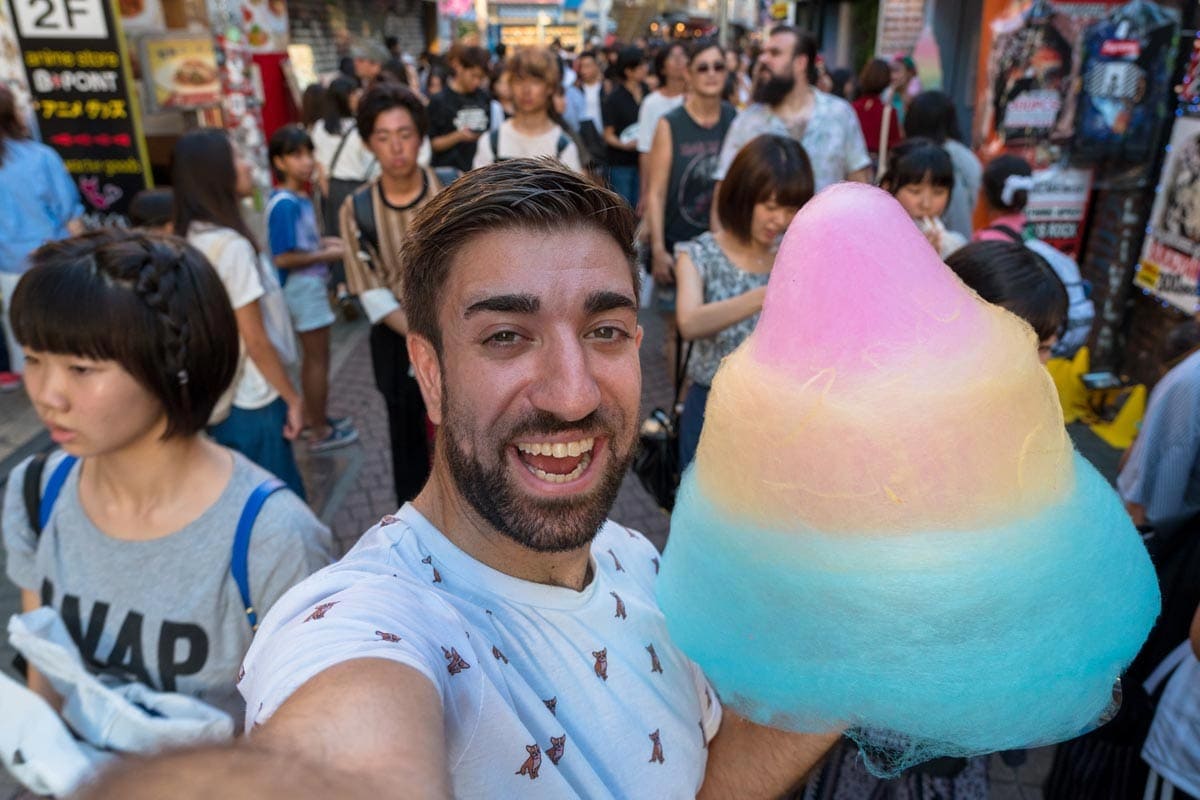
Tokyo , the world’s largest city with 38 million people calling it home, is an eclectic, electric city full of culture and customs.
With its bright lights and cacophony of sounds, Tokyo is a city like no other and you can almost feel the buzzing atmosphere.
However, the city can be more than a little intimidating for first-time visitors (that’s how I felt!) That’s why I really recommend going on a food tour in Tokyo to get a feel for the city.
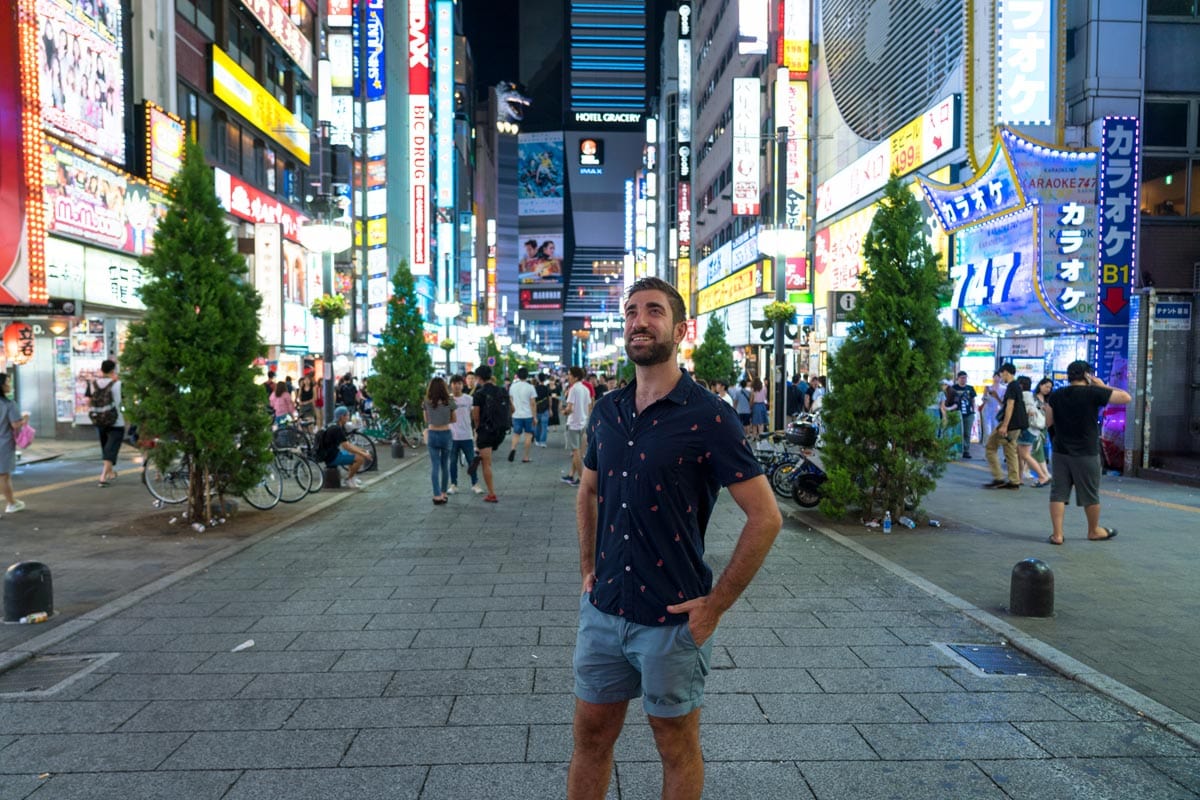
Whenever I get somewhere I’ve never been before, I always go on a food tour. I find they’re the best way to learn about a city through its food – if there’s a better way I don’t want to know about it!
And Tokyo is the perfect place for a food tour. Not only do you get to try dishes like sushi, ramen, and other delicacies, but you get to learn all about Japanese food culture and the customs that come with it.
On my Tokyo food tour, I learned about 72 things just to do with chop-sticks, and that was just chop-sticks. For me, this was the perfect way to prepare for my two weeks in Japan – I really learned that much.
So, if you want to eat your way through the city and find out where some of the best restaurants are along the way, then check out some of the best food tours in Tokyo.
Oh, and make sure you turn up hungry because you’re going to eat a lot!
Are you a fellow foodie who likes to get to know a place by their taste buds? Check out my food guides of Bangkok , Hanoi , Istanbul , Rome and M arrakesh !
Tokyo Food Tours
Tsukiji fish market tour.
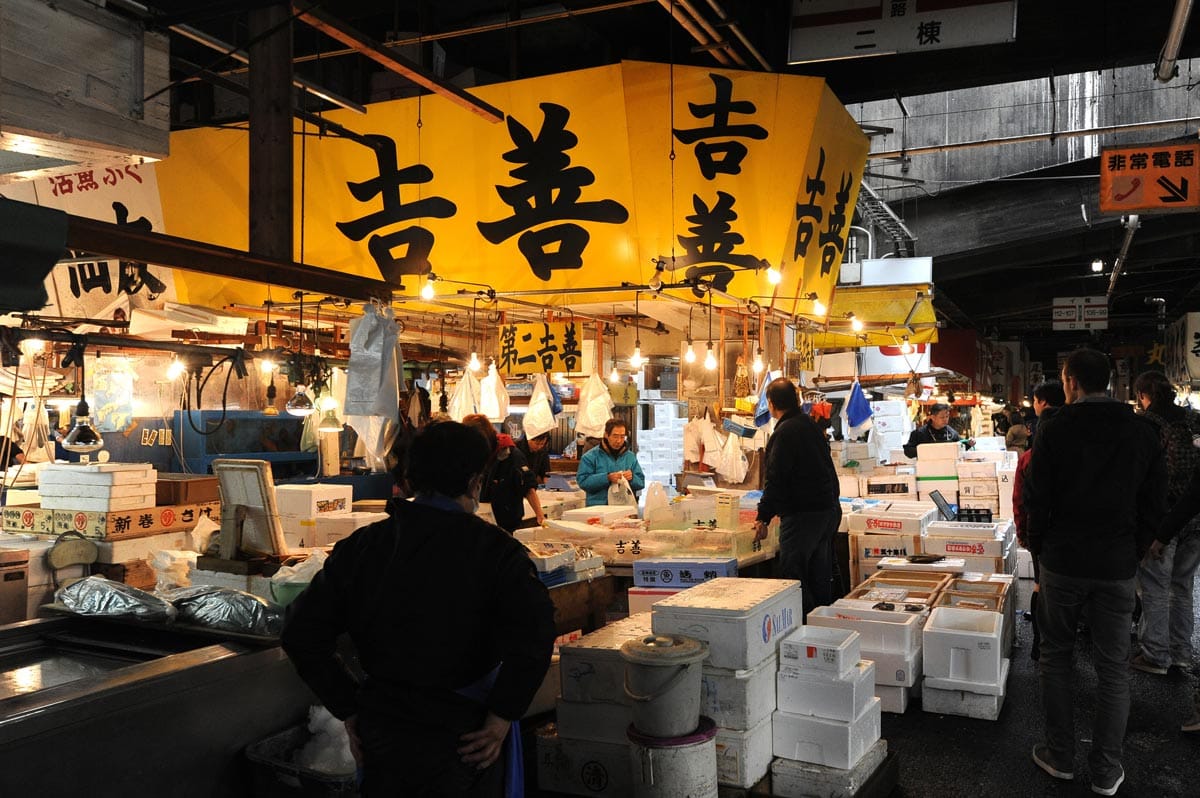
This is a 3-hour Tokyo food tour will really give you an insight into Japanese food. Just get ready to be dropped in at the deep end at the bustling Tsukiji Fish Market. Thankfully, there’s an amazing tour guide on hand to help you through this maze of fish stalls and people.
At Tsukiji Fish Market you can try all the fruits of the sea. Expect delicacies like bonito, sushi, fresh tuna, and local omelets cooked with fish. You’ll also learn all about the history of the market and the cultural significance of seafood in Japan.
Start the day by dining and shopping just like a local at Tokyo’s famous Tsukiji Market. You’ll quickly see why the best Japanese chefs shop here for the freshest ingredients.
Explore the plethora of seafood stalls while flitting between boxes packed with sea urchins. Observe busy vendors carving huge bluefin tuna and spot nervous pufferfish floating in tanks.
The tour ends with a visit to a genuine sushi restaurant for a serving of the best fresh sushi before heading back to Tsukiji Station. This is one of the most popular food tours in Tokyo, and it’s perfect for those who adore seafood!
Tokyo: Sushi Making Class

Obviously you can’t come to Tokyo without eating sushi. Better yet, eat it after you learn how to make it!
One of the things I really love about making sushi is you can go wild with different flavour combinations. For me, that means lots of spice an chilli.
After learning the basics of sushi making, the sky is the limit for creatively inventing new sushi recipes with local ingredients. At the completion of this class, you will enjoy the excellent sushi that you made along with miso soup.
In this class you will get step-by-step instructions on how to make delicious and attractive sushi. And trust me when I say this, it’s a lot easier than it looks.
During this hands-on cooking lesson you’ll learn how to make eight or nine different kinds of sushi while spending an afternoon with friendly locals in an informal atmosphere. You’ll also learn proper techniques on how to make tasty sushi rice.
This class is taught by local female instructors, all of whom speak English. A number of different common types of sushi will be covered in the class, including inari, nigiri, and sushi rolls.
As this is always a small group tour, you’re guaranteed one-on-one assistance from the instructors. That means you’ll have plenty of opportunities to ask questions too.
Shinjuku After Dark Izakaya Tour
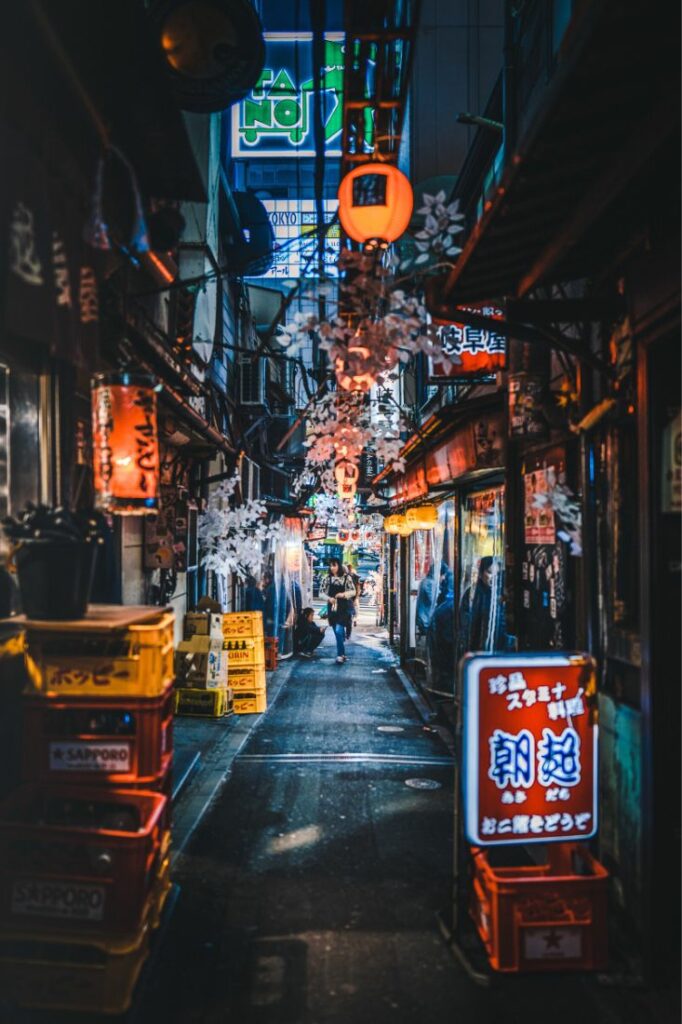
Tour guide Yoshi has experienced a lot of “tourist traps” in Japan and started his tour company to provide visitors a unique experience. He’s picked some of the best spots to enjoy Shinjuku nightlife on the Shinjuku After Dark Izakaya Tour.
He’ll take you to the best late-night food and drinking spots in Tokyo, including izakaya (Japanese gastropubs) in the notorious Kabukicho and classic Omoide Yokocho street. Enjoy yakitori and drinks while bar-hoping with a fun group!
This is one of those Tokyo excursions that you’ll remember for a long time (depending on how much sake you have of course!). It’s a bit like a Tokyo street food tour, but with bar hopping including too.
Tokyo Kaiseki Cusine Cooking Class
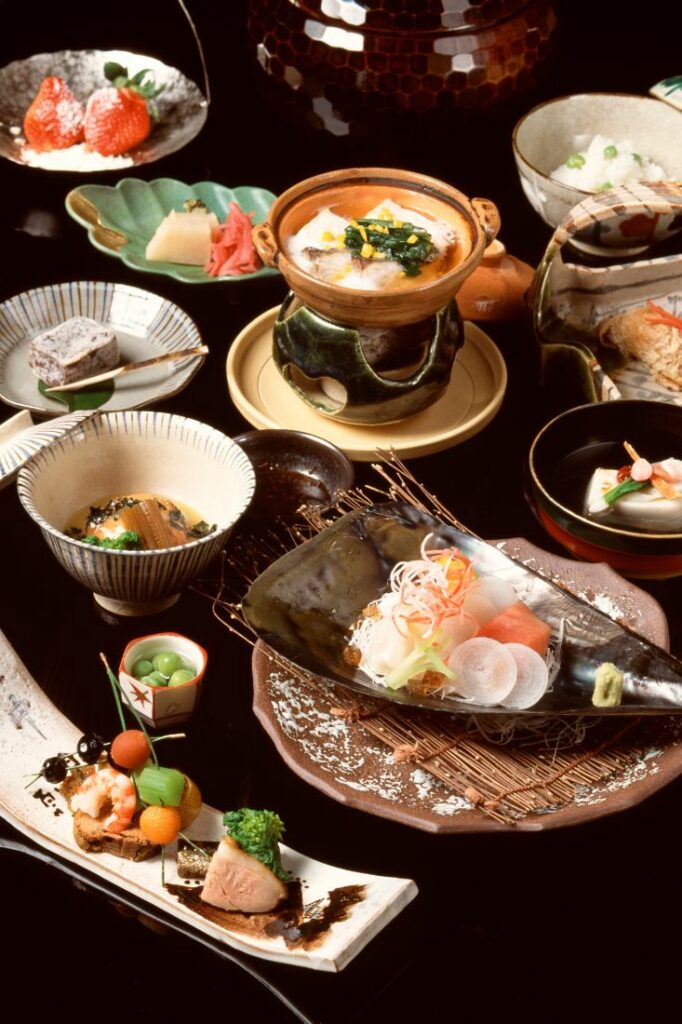
One of the best ways to experience local food is to learn how to make it in a local cooking class! Kaiseki is a traditional multi-course meal in Japan. It features individual dishes made from seasonal ingredients, and is both aesthetic and delicious!
With English step-by-step instructions, the chef breaks down the process of making kaiseki dishes, making them accessible for beginners and families. Once everything is prepared, you’ll get to enjoy a full kaiseki feast!
If you really want to learn all about Japanese food, then this is one of the best food tours in Tokyo for that.
Traditional Japanese Sweets, Wagashi & Mochi Class
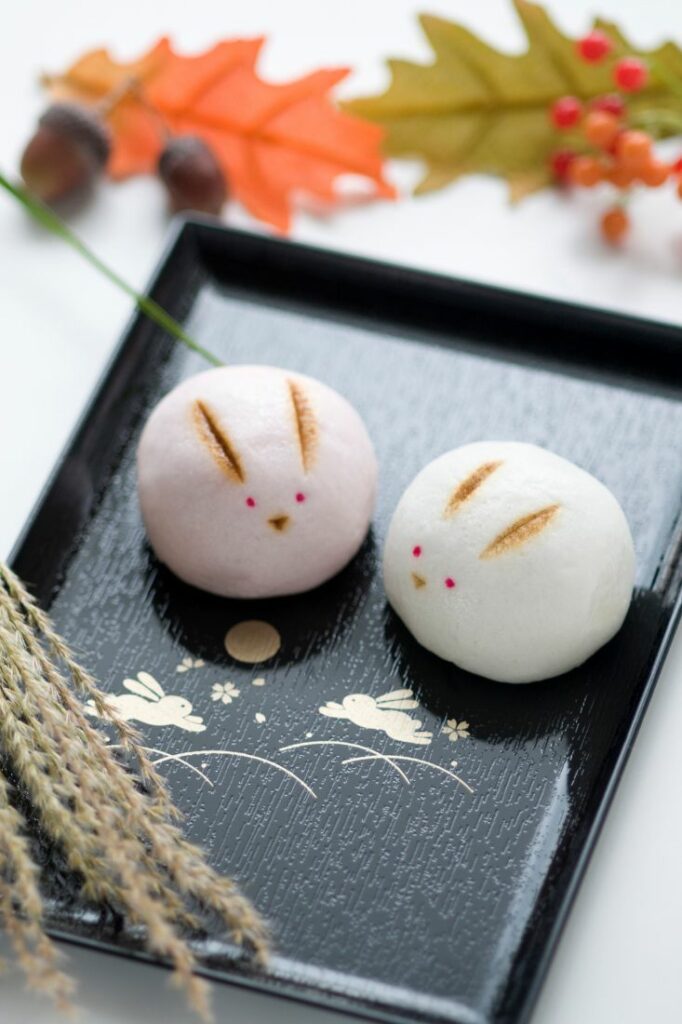
Wagashi are traditional Japanese sweets that are naturally vegan and gluten-free. You’ll make three different types of Japanese sweets, including mochi, the classic chewy rice cake. The sweets are shaped to reflect different seasonal motifs, and are as beautiful as they are tasty.
After making the sweets, you’ll learn how to make a bowl of matcha green tea. The matcha goes perfectly with the wagashi, and you’ll enjoy both after the class.
Tokyo Ramen Tasting Tour
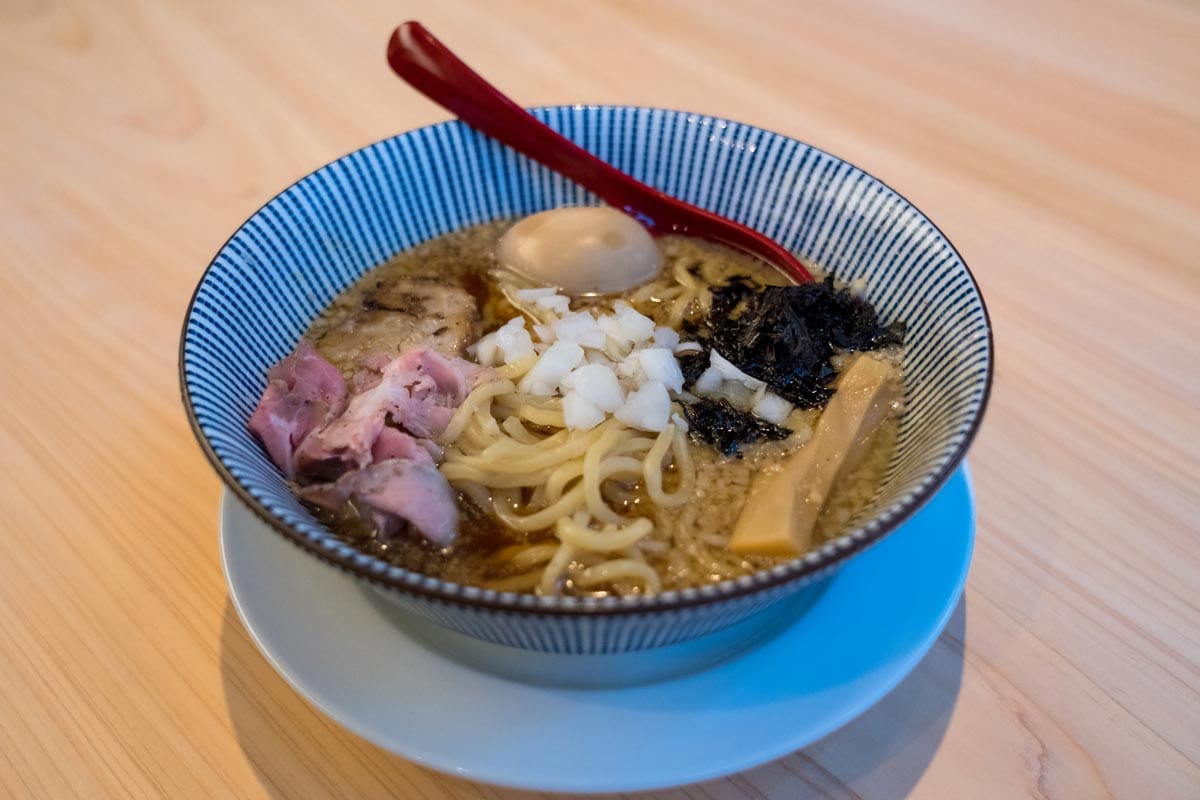
When it comes to the best food in Tokyo, ramen is always at the top of the list. Well, this is your chance for you to enjoy and experience ramen like a Tokyo native during this 3-hour group tour.
You will learn about the history and culture of this exciting dish, and then eat your way through six bowls of ramen. Yes, you read that right – six bowls of ramen!
The tour will take place in three unique Tokyo neighborhoods, including Shibuya. As part of this experience you will be given insider tips on the best ramen restaurants and tips to increase your enjoyment of ramen, learn about the history and different types of ramen, as well as how it is prepared, be exposed to how ramen is enjoyed locally, learn what makes good ramen, and select and enjoy a delicious bowl of ramen at a local restaurant suggested by a ramen expert.
I think this is one of my favourite food tours in Tokyo, so I really hope you check it out.
Tokyo’s #1 Family Food Tour Around Asakusa
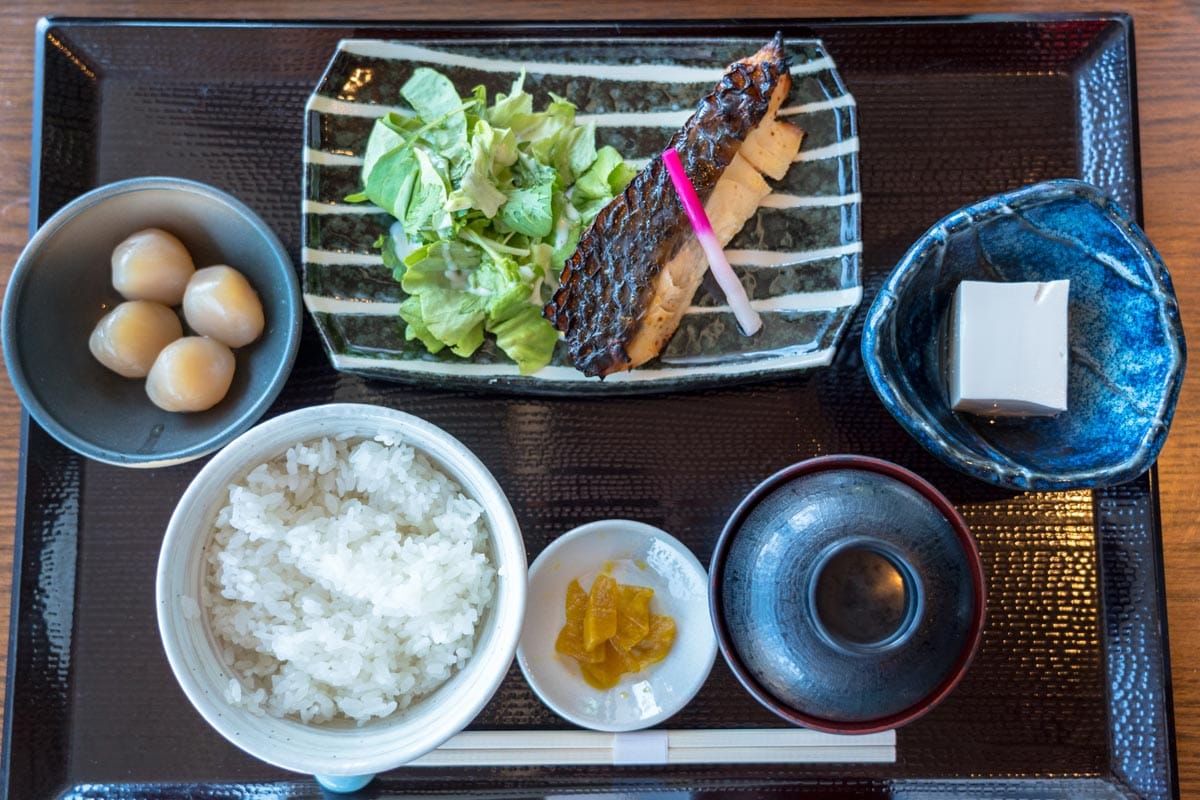
Asakusa, with its Sensō-Ji Buddhist temple and popular May Sanja Matsuri festival, is an area that positively vibrates with excitement. This is one of the most popular places to visit in Tokyo so expect it to be busy busy busy.
This was the Tokyo food tour I went on when I first arrived in the city and I LOVED it! I found it so useful and our local Tokyo food guide was incredible. I can’t tell you how many questions I asked him over the 3 hour tour.
We went though the history of Asakusa and why food is so important to Japanese culture. He was the one who taught me all about chop-sticks too. For example, you should never stick your chopsticks upright in a bowl of food as it’s means death and is very disrespectful.
This tour begins with an overview to Asakusa. This means you get to explore Namise Street while tasting popular Japanese delicacies like pickles, rice crackers, Japanese plums, and melon bread (made with a secret recipe!) along the way. You’ll also learn about pilgrims who have visited this area for over a thousand years.
The highlight of this Asakusa food tour is lunch. One thing I quickly learned was the Japanese love eating and lunch was a proper feast.
Depending on the time of year, lunch is often at the Tsukiji fish market. This is where you can try the freshest sashimi you’ll ever in your life. You’ll also learn about food customs with top tips on how to order food.
Other stops on the 3-hour tour include a visit to the theater, the side streets, and sampling specialties of Japan. Enjoy a popular pastry that has been made by a dessert shop since 1945 using a traditional candy making method. Oh, and obviously there’s lots of matcha tea too!
Shinjuku Golden Gai Night Tour
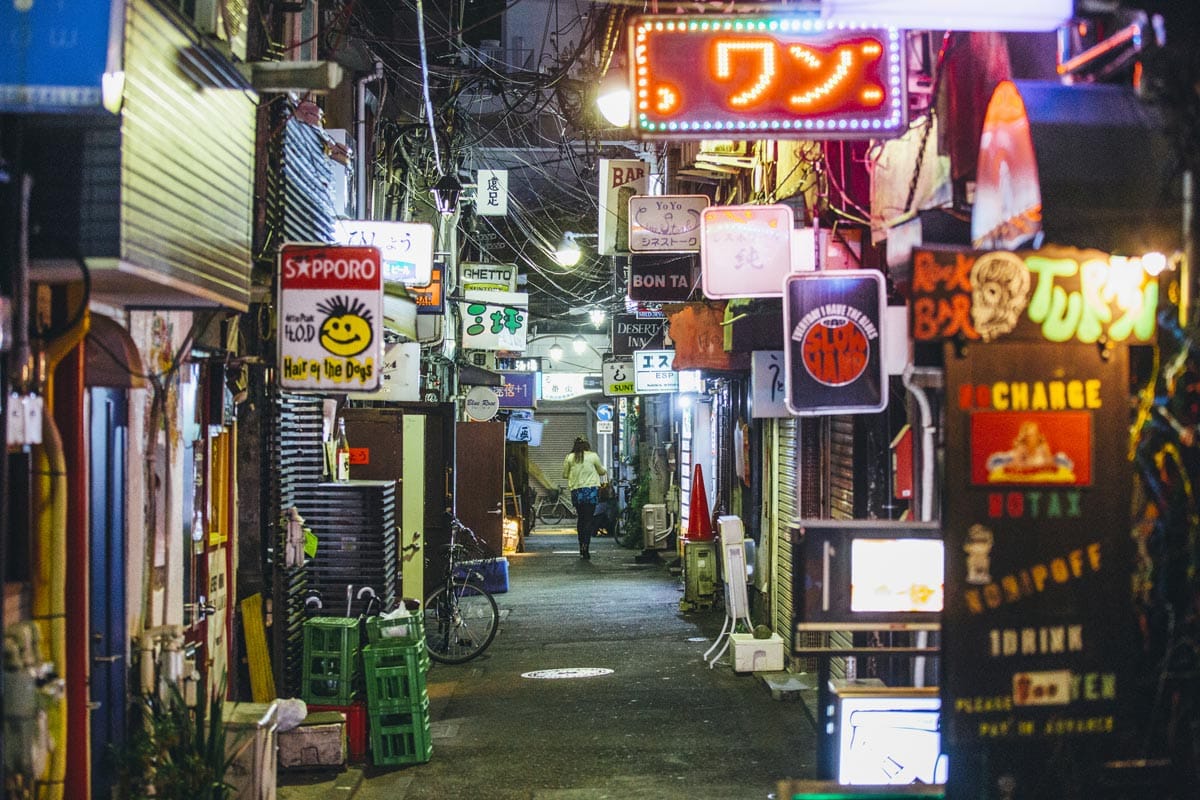
Those looking for a wilder ride can take a night walk with an established guide in two of Tokyo’s most notorious areas – Kabukicho and Shinjuku Golden Gai. For those looking for a beer and a bit of a party, this is the one for you.
Tokyo nightlife is like few places on the planet, and the heart of the experience can be found in Kabukicho. This is an area comparable with the red light districts of Europe but you know, different. However, Kabukicho is much cleaner and safer than its given credit for, and you’ll soon be enjoying the Tokyo nightlife like a local.
On your Tokyo street food tour you discover some of the best Japanese dishes – delicious ramen, okonomiyaki, yakitori, udon, takoyaki, soba, sashimi, tempura, and a load of others too. By the end of the night, you’ll be an expert.
Afterward, you’ll zoom through the streets to Shinjuku Golden Gai. This was one of my favourite areas in Tokyo and it’s always buzzing.
Golden Gai is a full of narrow, winding alleys and mysterious taverns and pubs. This is where a guide becomes essential – you’ll quickly find the best hidden gems in Golden Gai.
Sake Tasting Experience
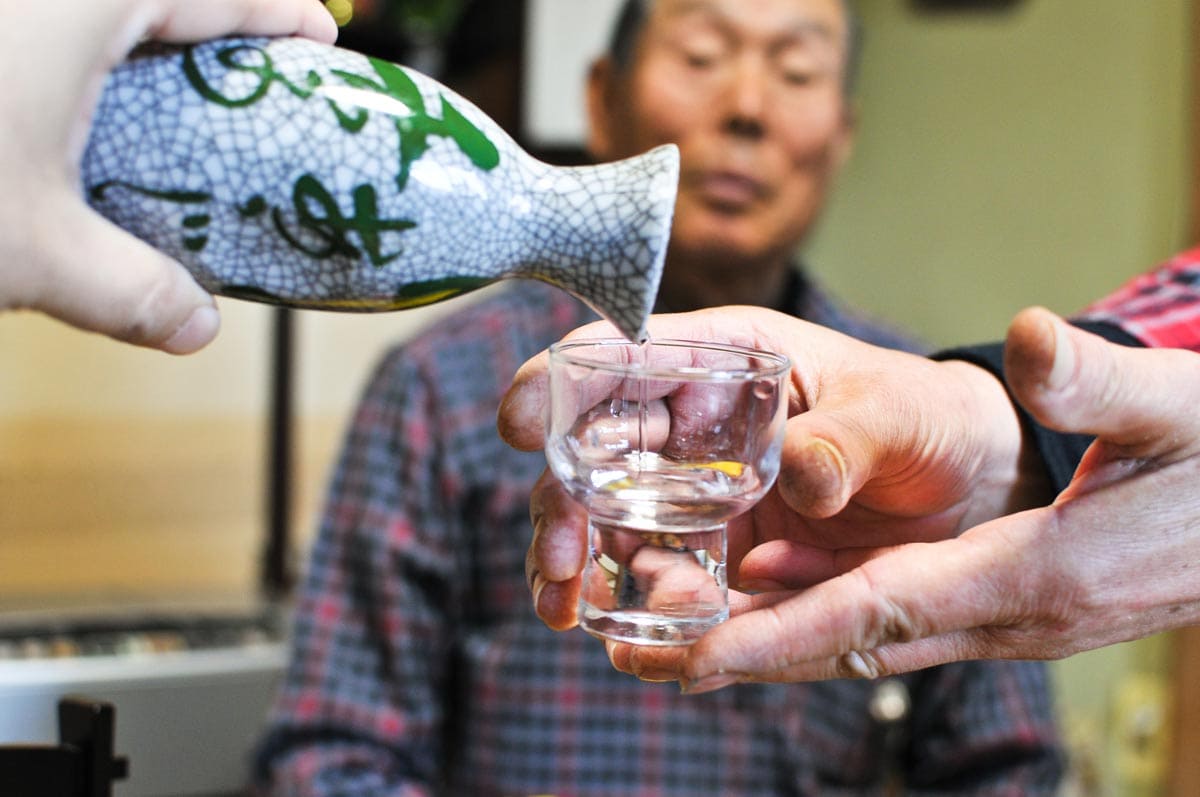
Now it’s time for some sake! I have to admit, I developed a bit of a taste for sake while travelling around Japan. I can’t say I know too much about it though which is why a sake tour is perfect.
This tour is all about experiencing Kikizake. This is the process of judging the color, aroma, and taste of sake in a similar manner to how sommeliers taste wine. While blindfolded, you’ll sample different brands of sake and attempt to identify them – and yes it is hard!
During the tasting you’ll select 7 different types of sake from 20-30 different varieties for sampling. If you enjoy a particular type of sake that you have tasted, you can order it at the end.
Sake comes in many varieties, amount of alcohol, and degrees of dryness. It can also be served warm or cold (warm was my fav).
If you already have a particular inclination for the types of sake you would like to sample, you can let the guide know ahead of time so that we can select sake that matches your taste.
Learn to Cook Japanese Vegetarian Food
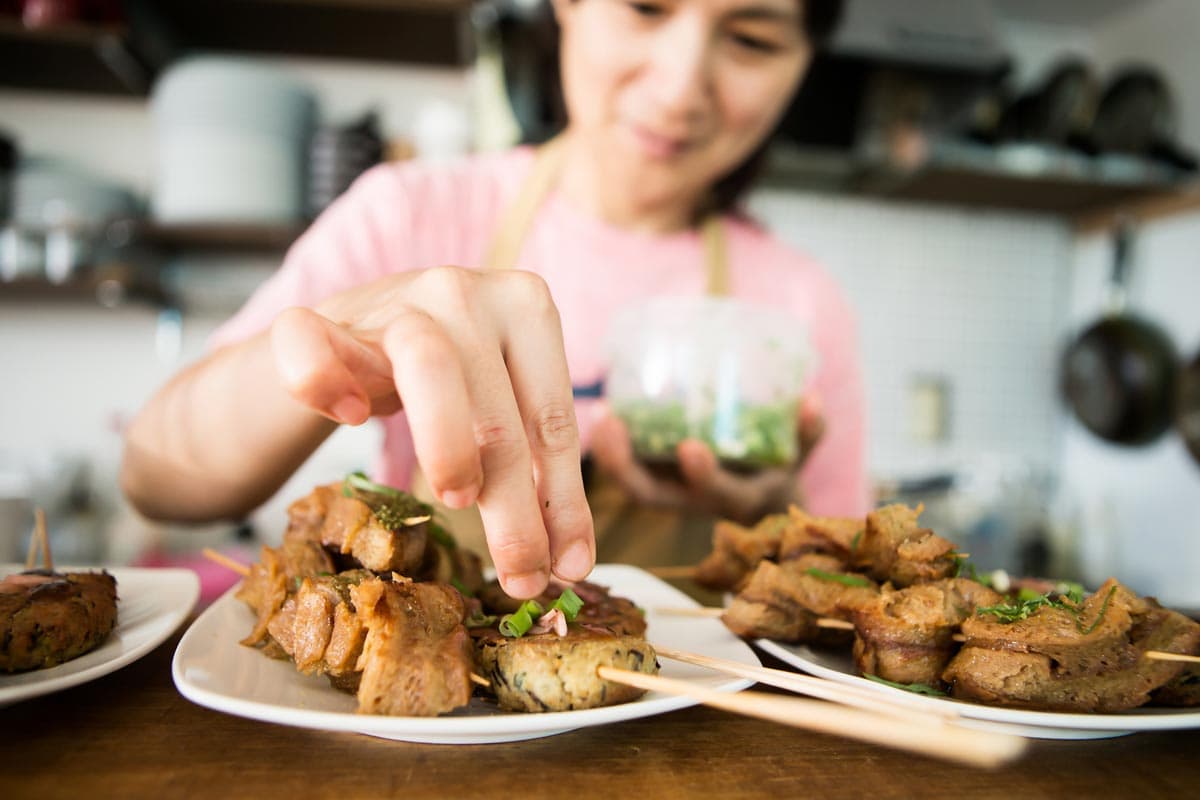
This is without a doubt one of the best Tokyo food tours. If you’re interested in learning more about the Japanese vegetarian lifestyle, this experience offers the opportunity to learn how to cook a Japanese vegetarian course menu of four or five different dishes.
The dishes include hijiki with creamy citrus sauce, brown rice with mizuna, persimmon gelee, steamed azuki and pumpkin, and lotus root fried ball. All the recipes featured in this course follow macrobiotic theory and include no meat, fish, white sugar, chemical products, or eggs. Basically, this is perfect for vegans and vegetarians!
Included in this class are also lessons offering instructions on how to arrange different types of vegetables and bread to make them more aesthetically pleasing. The table will be arranged with Japanese pottery or white porcelain with beautiful bouquets and tasteful table linens.
Classes are available on Saturdays and Sundays. They last three hours and there are two each day, one from 10:30-1:30 and one running from 4:30-7:30.
These classes are for women only and any males interested should bring a female such as a spouse, friend, or family member. That’s just the way it is I’m afraid!
To learn more about the cuisine before your trip, check out this amazing podcast all about Japanese food . They talk through some of the most popular dishes you’ll find in Japan, and it’s a great overview.
So, out of the best food tours in Tokyo, which one catches your eye? I would love to know which one you’d go on so let me know in the comments below!
Like this blog post? Then make sure you Pin it!
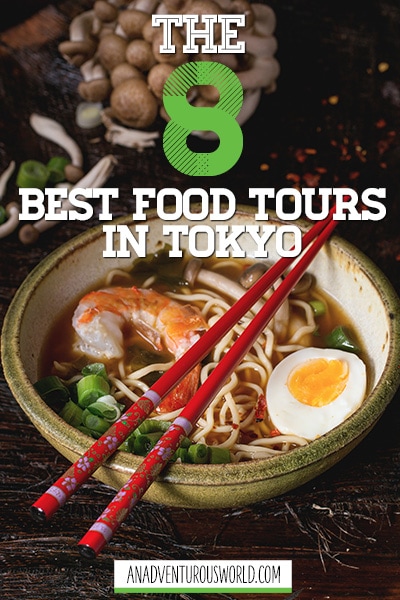
About the Author

Macca Sherifi is the founder of the multiple award-winning blogs An Adventurous World and the Great British Bucket List. Every month he inspires over 200,000 avid readers to travel the world.
2 thoughts on “10 BEST Food Tours in Tokyo, Japan”
Oh man I am DROOLING reading this! I’m going to be in Tokyo in March.. but sadly only for 2 days. Think I can do all eight of these tours in 48 hours?
Ha ha ha. I’m sure you can give it a good go if you try! Maybe just start off with one though? Let me know how you get on!
Leave a comment Cancel reply

- Destinations
- Private Tours
- Historical Tours
- South Korea
- United Arab Emirates
- Czech Republic
- Brussels NEW
- Belfast NEW
- Copenhagen NEW
- Palermo NEW
- Netherlands
- Stockholm NEW
- San Sebastián NEW
- Valencia NEW
- United Kingdom
- United States of America
- Los Angeles
- Philadelphia
- Portland, Oregon
- Washington D.C.
- San Francisco
- Houston NEW
- Mexico City
- Rio De Janerio
- Food Tour Drinks Upgrade

Tokyo Food Tour - Secret Food Tours

We're wildly passionate about classic Japanese cuisine and we'd be delighted to share our love of food and culture with you.
By booking our Secret Food Tours: Tokyo, you'll have the opportunity to experience our passion and enjoy quality food and discover why eating and drinking are a "way of life" here in Tokyo.
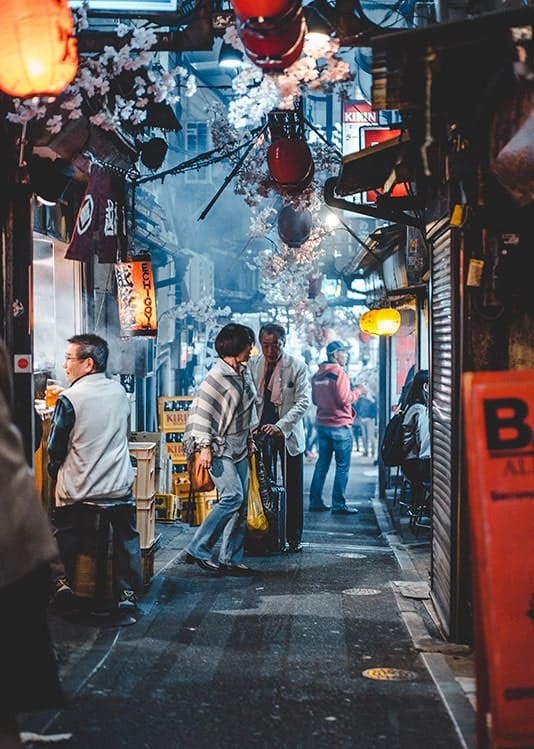
Our Secret Food Tour: Tokyo will introduce you to the best of Japanese cuisine. You'll learn from our guides about all the delicate nuances of flavor as they change with the seasons and how our appreciation for Japanese customs and traditions plays into the preparation and enjoyment of our local food.
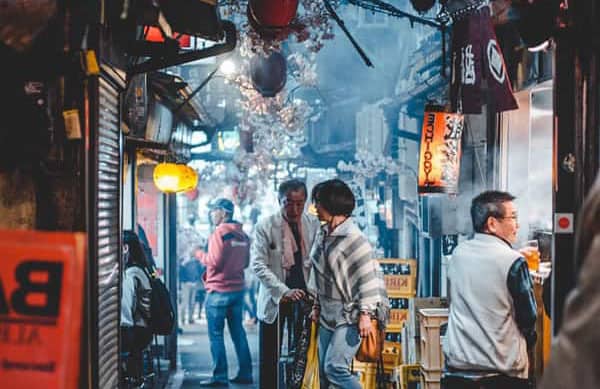
At Secret Food Tours: Tokyo, we're all extremely passionate about authentic Japanese cuisine and we can't wait to share our love of food and culture with visitors who have made the journey to our amazing city. On our tour, you'll have the opportunity to enjoy high quality food and discover why eating and drinking are a "way of life" here in Tokyo. Our city is the perfect balance between old and new, and Tokyo's fascinating history will be woven into our tour as you discover why the city is one of the food capitals of the world.
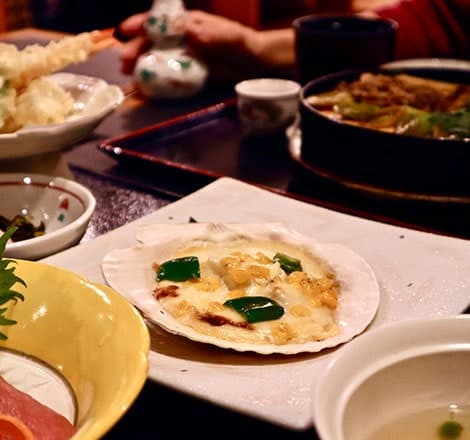
- Book Your Tour
- Our Tokyo Tours:
- Food Tours Tokyo
- Photos/Video
- Destinations
- Group & Private Tours
- Read About Us
- San Sebastián
- New York City
- Rio de Janerio

The 7 Best Tokyo Food Tours [2024 Reviews]
Tokyo is famous for its technology, Anime, and video games, but it’s also one of the best foodie cities in the world.
From fresh seafood and ramen, the food scene has a healthy respect for tradition while still honoring experimentation and the fact that it has such a multicultural population. However, there are SO many eateries that it’s hard to find some of the best ones outside of touristy locations.
That’s why I’ve decided to carefully select the 7 top Tokyo food fours – all the food tours in Tokyo that are well worth your time and money! Let’s jump right in!
Be sure to see our reviews of Mt Fuji Day Trips , Mario Cart Tours and Sumo Experiences .
Best Food Tours in Tokyo
Quick answer: the 7 best tokyo food tours for 2024.
- Best of Shibuya Food Tour
- Izakaya Food Tour in Shinjuku
- Shibuya Bar Hopping Night Food Walking Tour in Tokyo
- Shibuya All You Can Eat Food Tour Best Experience By Local Guide
- Shinjuku Omoide Yokocho, Kabukicho and Golden Gai Food Tour
- Tsukiji Fish Market Food and Culture Walking Tour
- Tokyo by Night: Japanese Food and Drinks Experience
Best Tokyo Food Tour Reviews
1. best of shibuya food tour.
- Duration: 3 hours
- Departure: 2 Chome-1 Dogenzaka, Shibuya City, Tokyo 150-0043
- Departure Time: 4:00 PM
- Includes: Local guide, One drink included, 5 Food Stops, Dessert included
My first time in Tokyo was such a whirlwind, with seemingly endless activities to partake in, and so much to see! Pair that with the fact that I speak very limited Japanese, and I was grateful that this next tour existed.
The Best of Shibuya Food Tour took us on an adventure right through one of the city’s most lively, popular neighborhoods and taught us all about Japanese cuisine!
We met our guide right in the middle of Shibuya, and they instantly put me at ease with their calm and friendly personality along with their clear expertise on the subject.
I’d seen a bit of Shibuya before, but this was a much more immersive experience that felt like I had a friend leading the way.
Through the bustling streets and hidden alleyways, the vibe from the people and smell of delicious food wafting through the air was enough to make me completely enamored with this area.
We went to 5 different food stops, we were able to enjoy a nice selection of national dishes, from Hiroshima-style okonomiyaki, to various fresh sushi, yakitori skewers, and more!
Expand To See More See Less
We went through a maze of eateries at an underground food hall, which made it feel like we were in some sort of movie!
Of course, no visit to Shibuya is complete without seeing the famous crossing, which reminded me a lot of New York City’s Time Square!
As we ended around 7 pm, it was the perfect time to enjoy the local nightlife afterward, with plenty of cool recommendations from our guide! It was a fantastic way to acquire a solid understanding of national cuisine, as he told us all about the different regions.
I highly recommend it if you’re looking for some background on Japan, tons of fun, and even more good food!
More Information & Tour Booking
100% refund for cancellations within 24 hours of tour experience, other experiences you may enjoy:, 2. izakaya food tour in shinjuku.
- Duration: 3.5 hours
- Departure: 1-chōme-2-1 Kabukichō, Shinjuku City, Tokyo 160-0021
- Departure Time: 5:00 PM
- Includes: Guide, 7 different dishes at 3 izakayas, alcoholic beverages, small-group tour
When it comes to food tours, I feel like the only way to really enjoy the full experience is for it to be in a small-group setting.
That’s the case with the Izakaya Food Tour in Shinjuku , where your group is limited to a maximum of 20 participants for a customized, intimate experience.
Known for its entertainment district, there are tons of restaurants and bars within Shinjuku worth visiting, and your guide will take you to the best of the best.
Shinjuku is a place I hadn’t yet really seen yet, but I was very interested and intimidated by the nightlife scene there.
Our guide instantly made me feel more comfortable exploring the area, taking us to many cool, neon-lit locales that made me feel like I knew exactly what I was doing.
We had a pretty small group, but that was also the perfect opportunity to chat and get to know other travelers who were new to the area.
After our initial meeting, we then went to a few different local izakayas in the neighborhood, which is essentially skewers and small cuts of meat, fresh seafood, and veggies, along with bigger “signature” dishes.
Our guide explained it all to us, as well as plenty of sashimi, gyozas, sake, beer, and even some “special” cocktail drinks that were so delicious and refreshing.
Our guide did a fantastic job answering any and all questions that we had in a patient and friendly way.
I had a fantastic time walking through the downtown area known as “Kabukicho”, which is all of Tokyo’s biggest and most vibrant district for entertainment.
You’ll find everything from prehistoric reptiles to neon samurai shows, so expect the unexpected! If you’re looking for a fun time all while learning about and trying new food, this is definitely the tour for you!
3. Shibuya Bar Hopping Night Food Walking Tour in Tokyo
- Departure: Japan, 150-0042 Tokyo, Shibuya City, Udagawachō, 216, Q Front, 1F
- Departure Time: 6:00 or 7:00 PM
- Includes: 4 drinks & 3 dishes or 3 drinks & 4 dishes, enough for a full dinner meal. (Vegan menu available), Hopping 3 local izakaya bars with a local guide, Photos during the tour
I always recommend this tour to those who are visiting Tokyo for the first time or those who are short on time and want to maximize their sightseeing and eating!
After all, I was able to try tons of bars I would’ve otherwise never even experienced without this tour! The Shibuya Bar Hopping Night Food Walking Tour in Tokyo is perfect for everyone with just about any type of diet, including vegetarian and vegan!
This thrilling adventure is a few hours full of cultural immersion and discovery of new foods, led by a knowledgeable guide who is a local to the area.
Ours was very passionate and full of fun facts about the different areas and dishes, and clearly knew the best places to go to!
I had no idea just how dynamic the food culture was here, and we were able to try everything from savory yakitori skewers and rich bowls of hot ramen to crispy tempura and fresh sushi.
This was so much fun, being able to go through all kinds of cool eateries highlighted with neon signs, and some of them were even in a kind of underground labyrinth!
Most of the bars were izakaya-style, which are basically devoid of tourists and served some of the most amazing food and drinks I’d ever tried in my life. My favorite part may have been the entire floor of a massive building that is filled with various bars and pubs – no tourist traps in sight.
Our guide was so sweet and made sure we made plenty of stops for photos and videos, including a stop at the world-famous Shibuya crossing!
If you’re looking for a fun way to fill up your schedule or want an exciting alternative to dinner at just one restaurant, this is it! Our guide even included plenty of recommendations for us to try over the next couple of days, completely transforming our trip!
4. Shibuya All You Can Eat Food Tour Best Experience By Local Guide
- Duration: 4 hours
- Departure Time: 11:00 AM or 5:00 PM
- Includes: Sushi, yakiniku, chicken karage , takoyaki, 2 soft drinks and water, Desserts, City walking & culture tour, Professional guide.
The busy streets of Shibuya can be a bit intimidating to navigate, even if you’re native to the area! As tourists, it can be a bit stressful if you don’t know what you’re doing, so it’s a huge relief having a local guide lead the way.
With the Shibuya All You Can Eat Food Tour Best Experience by Local Guide , you’ll get to appreciate every corner of the iconic neighborhood in a way where you don’t have to worry about where you’re going.
This is the longest tour of all of those I’ve curated for this guide, as it does offer a bit more in regards to the walking and culture tour.
With that being said, be prepared for quite a bit of eating and walking, so put on a pair of comfy walking shoes and bring a jacket as it can get chilly at night!
With a small-group tour setting of no more than 10 participants allowed, this intimate tour makes it feel like you’re just cruising around with a little group of friends.
We met up with our guide right in Shibuya, which was luckily easy to find and we set off onto Shibuya 109 which is a local street known for its amazing food!
Not only that, but many fashion trends start here so you can count on many young fashionistas cruising the streets for the newest trends.
It’s all very interesting and unique to Tokyo, with our guide offering us educational commentary about the area to understand the culture a bit better.
We also headed into a hidden alley that many locals frequent thanks to the cool bars and restaurants found here, though I realized very few tourists actually knew about it! We then took photos at Shibuya crossing, which is the busiest crossing in the entire country!
All of this and we got to try delicious food while chatting about Japanese culture – not a bad way to spend an evening!
5. Shinjuku Omoide Yokocho, Kabukicho and Golden Gai Food Tour
- Departure: 1-chōme-2-6 Nishishinjuku, Shinjuku City, Tokyo 160-0023
- Includes: Local guide, two drinks included, 4 food stops
Shinjuku Golden Gai is a legendary district made up of various passageways lined with hundreds of little shanty-type bars, clubs, and restaurants packed together.
It’s a place unlike any other in the entire world, with ramshackle buildings and dimly-lit walking areas that look a bit “scruffy” but are absolutely amazing! The Shinjuku Omoide Yokocho, Kabukicho and Golden Gai Food Tour cover all that and much more!
This tour offers one of the most unique opportunities to see Golden Gai, which for some reason I’ve noticed is not commonly covered in Tokyo food tours.
With its cozy bars and narrow alleyways, it is like a journey back in time to the “old” Tokyo, which is really cool to see. After all, you can’t truly appreciate the present-day until you know where its culinary heritage begins!
After meeting up with our guide, we made our first stop at Omoide Yokocho which features bars that have stayed essentially the same for nearly 100 years!
We then made our way to Kabukicho, which is not only the biggest Red Light District in Asia, but is also known as the safest. In Kabukicho, we took a break to try two different dishes – my favorite being a bowl full of savory ramen!
Once in Golden Gai I was completely in love with the lively environment, with locals who were surprisingly very friendly and welcoming to our group.
We sipped on some tasty drinks and tried a few different dishes before we stopped at a karaoke bar and had a ton of fun! This is one of my favorite tours I’ve ever taken anywhere, so if you want my advice, just sign up now!
6. Tsukiji Fish Market Food and Culture Walking Tour
- Departure: 3-chōme-15-1 Tsukiji, Chuo City, Tokyo 104-8435
- Departure Time: 8:30 AM
- Includes: Local professional guide, food, snacks
This next tour is quite a bit different than any other on this guide, starting with the fact that it departs in the morning! The Tsukiji Fish Market Food and Culture Walking Tour is an adventure that highlights all kinds of fascinating finds!
Tsukiji market had been operating for nearly 100 years and was built to replace the older market before it that was destroyed by a massive earthquake.
While the inner market has since been moved, the outer market is still around in the same location and is right next to the opulent Ginza area that’s also fun to explore.
This is a great opportunity to see inside the famous site, where you’ll get to learn about its history and why so many of the country’s top chefs come here daily to purchase the highest-quality ingredients around.
I’ve seen some seriously eye-opening things here – things that you probably won’t be able to find anywhere else in the world!
We started by meeting our guide in from of the Tsukiji Honganji Temple gate early in the morning, heading to the biggest fish market in the country.
We learned how many Michelin-star restaurants in Tokyo source their ingredients from here, and it’s easy to see why. We walked around, sampling all kinds of traditional Japanese foods, like fried fish cakes and Katsuobushi, as well as some drinks.
There are so many little food stands and shops to purchase from, that if you haven’t gotten souvenirs already, this is the perfect place to snap some up.
Our guide was so knowledgeable about the market itself, as well as the local food, that you’ll gain a whole new appreciation for Japanese culture. With tons of good eats, lots of learning, and lots of laughing, this is a truly special experience I feel everyone should have!
7. Tokyo by Night: Japanese Food and Drinks Experience
- Departure: 4-chōme-6-16 Ginza, Chuo City, Tokyo 104-8212
- Includes: Local guide, 3 local food tastings and 2 drinks, 2 subway tickets
Last but certainly not least, is the Tokyo by Night: Japanese Food and Drinks Experience tour ! It’s one of the more affordable experiences of its kind, immersing you into the mesmerizing allure of the city at night.
Led by expert guides who are passionate about their city and its cuisine, it will take you through bustling streets from Shinjuku to the sophisticated neighborhood of Ginza with a delicious array of delicacies!
We met up with our guide at Yurakucho Station which was easy to find, answering our questions and offering a briefing of what to expect before we got started.
We strolled through Yakitori Alley, which is filled with more casual restaurants offering savory yakitori skewers. You have to try it in the housemade sauce for maximum tastiness with a sake to wash it all down with!
After that, we explored around some more, taking in all the sights and sounds of Tokyo’s exciting nightlife scene before arriving in Monja Street.
Here, we tried the famous type of fried pancake called “monjayaki”, which I instantly fell in love with. I’m a huge fan of pancakes and French toast, and I would love to have something like this for brunch (or really, any hour of the day).
When we got to Ginza, I was super excited as it was filled with so much going on, from top-notch clubs to more local restaurants and fun shops to grab souvenirs at.
Our tour guide did a great job at telling us about the history behind the different places, though I did wish we would’ve visited a stop or two more for food. Overall, it was a wonderful night out with a local who knew the city like the back of his hand!
Foods Tasted
Tour guides.
The Best of Shibuya Food Tour is our Editors Choice for the best Tokyo food tour.
Robert Baker
Related articles, the 5 best mt fuji day trips from tokyo [2024 reviews], 🏯 the 5 best private guided tours of tokyo [2024 reviews], the 5 best mario kart tours in tokyo [2024 reviews], the 5 best tokyo sumo tournament experiences [2024 reviews].
What better way to experience Japan’s culinary art of sushi than at the former largest fish market in the world. The Tsukiji Fish Market and Sushi Making Tour introduces Tokyo’s iconic market, none other than the Tsukiji Fish Market! Not only will you learn about its long history and bask in the lively ambiance of the area, but you’ll also leave this special Tokyo food tour with new sushi-crafting skills. Get excited about making sushi from scratch, using the finest ingredients the land of sushi can provide!
Book the Tsukiji Fish Market and Sushi Making Tour >>
2. Shibuya Food Tour
Nothing beats the liveliness of one of Tokyo’s busiest city centers. Any Japan trip is not complete without a visit to Shibuya. Experience the city to the fullest by joining the Ultimate Food in Shibuya Tour — it’s not only great for nightlife and shopping but also for the authentic Japanese food , and this Tokyo food tour will prove it to you! Go from munching on sushi bites and piping hot takoyaki to grilling our own wagyu beef at an izakaya. Don’t worry, it’s not all hefty meals — this Shibuya food tour takes a pit stop at a local arcade so you can digest those meals while playing some insane Japanese games!
Book the Ultimate Food in Shibuya Tour >>
3. Ramen Tour
Ramen is the heart and soul of the people of Japan. It’s not only a convenient and quick dish but it's also insanely delicious! One of the best culinary tours to go on to relish in mouthwatering bowls of Japanese ramen is the Tasting 6 Mini Bowls of Ramen at 3 Award Winning Shops tour. Roam around the streets of Shibuya, Nakameguro, and Ebisu to visit award-winning ramen restaurants and learn everything about this incredible dish — from the history to the customizable options. You'd better come with an empty stomach and a huge appetite because you’ll be tasting not just one but six mini bowls of various types of ramen!
Book the "Tasting 6 Mini Bowls of Ramen at 3 Award Winning Shops" Tour >>
4. Sensoji and Asakusa Food Tour
Get a local’s insight with a tour guide while you explore one of Tokyo’s most culturally and historically rich areas, Asakusa. On this tour, Back to Edo: Sensoji and Asakusa Food Tour , you’ll experience the coexistence of traditional and modern Japanese culture in one spot. Not only will you get to discover the hidden gems of this popular area while munching on snacks that can only be found in Asakusa, but this tour is also a fun learning opportunity as it introduces you to the Japanese culture — from etiquette and table manners to historical storytelling.
Book the "Back to Edo: Sensoji and Asakusa Food Tour" >>
5. Eating and Drinking Tour in Shinbashi
Shinbashi is not your everyday tourist area of Tokyo — it’s quite the opposite. Yet, that’s what makes it all the more interesting to explore. This area is the heart and soul of Tokyo’s business district where Japanese salarymen and women spill out onto the streets when the sun starts to set. Ditch the tourist title for a day and live like a local during this Tokyo food tour, Eat and Drink Like a Tokyo Salaryman in Shinbashi . Navigate through the winding streets of food stalls, making pit stops along the way to get your fill of traditional Japanese oden and the authentic local drinking experience at izakaya bars.
Book the "Eat and Drink Like a Tokyo Salaryman in Shinbashi" Food Tour >>
6. Shinjuku Food Tour
Shinjuku is not only known as a business district but it’s also famous for nightlife. With an abundance of local bars like izakaya and t achinomiya (standing bars), it’s hard to know which ones are worth spending time in. Not to fret, that’s when the Shinjuku After Dark Izakaya Tour comes in. On this Tokyo food tour, trust the local guide to bring you to not only authentic local bars but also ensure the best Shinjuku nightlife experience. Try every local alcoholic beverage like Japanese sake , paired with ideal snack foods like yakitori.
Book the Shinjuku After Dark Izakaya Tour >>
7. Japanese Sake Brewery Tour
Regardless of whether or not you’re a big drinker, you ought to know about Japanese sake. This local rice wine takes a significant part of the Japanese food culture and the sake breweries in Japan are immensely dedicated to their craft. The Toshimaya Shuzo Sake Brewery Tour brings you to one of Tokyo’s oldest breweries, established in 1596. The Toshimaya Shuzo still uses Mt. Fuji spring water for their sake varieties. Learn the history and process of this fine beverage, and end the experience with an all-you-can-drink sake tasting where you’re able to explore the various flavors of sake.
Book the Toshimaya Shuzo Sake Brewery Tour >>
8. Bar Hopping Tour
Most would know Kichijoji for being one of the top spots for cherry blossoms, but what they don’t know is that this neighborhood is home to countless quaint, themed bars residing in a former flea market established after World War II. Join The Midnight Diners: Tokyo Experience and go on a bar-hopping expedition in Harmonica Yokocho. Don’t be afraid to strike up a conversation with the locals in these bars — the local tour guide will come to the rescue to interpret if you can’t speak Japanese. All you need to know is the word “kampai” as you raise your glass to clink theirs.
Book The Midnight Diners: Tokyo Experience >>
9. Hidden Gems of Shibuya Food Tour
Tokyo’s bustling ward Shibuya is more than just the Shibuya Scramble Crossing and Hachiko Statue. It’s the birthplace of countless fashion trends and home of multiple local and international boutiques. Not to mention the array of various types of local cuisine restaurants. The Retro Shibuya Food Tour is one of the unique Tokyo food tours that brings you off the beaten path and into the unique local eateries rather than tourist-invaded ones. Some of these restaurants have been around since the Showa Era — you definitely don’t want to miss that!
Book the Retro Shibuya Food Tour >>
10. Tokyo Vegan Food Tour
Japan is known for its significant consumption of seafood, so one would assume that looking for vegan food is like a scavenger hunt in Tokyo. The Vegan Food Tour in Shibuya will let you in on the hidden plant-based vegan restaurants that are hiding in plain sight, as you explore the wonderful streets of Shibuya. Discovering the best vegan food in Tokyo, from imitation Japanese fried "chicken" to traditionally vegan snacks and delicious vegan donuts, you’ll be in safe hands with the local tour guide who’s an expert on all things vegan.
Every booking on byFood contributes to the Food for Happiness program, and in addition to byFood's donation, the host has the option of donating. When you book this vegan food tour in Tokyo, the host will donate 150 yen in addition to byFood's 250 yen!
Book the Vegan Food Tour in Shibuya >>
There's nothing like a Japanese food tour to complete your Japan trip! Eat authentic Japanese cuisine and uncover rare eateries and dishes, all while picking up cultural tidbits and mingling with Japanese food lovers — it doesn’t get any better than that! What are you waiting for? Go ahead and book a Tokyo food tour!
Looking for more food experiences in Tokyo ? Check out our cooking classes , dining experiences , and tastings in Tokyo !
I’ll be straight with you. Planning a trip Japan always gives me a bit of an anxiety attack. I don’t know if it’s just me but this is coming from someone that’s been before too. Not to worry though, there are definitely ways to make that trip planning easier. Let me share with a few of my secrets.
What’s so tricky about Tokyo?
Essentially it boils down to the fact that there’s a mix of not having enough information and having too much information. How does that work you ask?
Well on the not enough front, there are is a lot of local content that is in Japanese-only which makes it challenge. Typically I try to seek out local content because you know it’s updated and fresh but you soon learn you’re out of luck.
There’s also too much information because everybody’s got their own take of where to go and it’s all so fragmented that you have to assemble it yourself. If we’re just talking about food, it’s probably worse because places we’re so used to relying on such as TripAdvisor and Yelp become pretty useless if you’re wanting non-touristy recommendations.
Language just plays a big part of why I feel like I have to work that much harder to figure out my trip plans. It could be as simple as trying to get from the subway to a connected building. From experience, I know it’s not as simple as you think because English signage will often be lacking or misleading.
Don’t even get me started on all the subway companies. Lines, I’d be totally okay with but when you have 48 operators in the world’s most extensive urban rail network, most of which don’t work with each other unless you have a special chip card, it’s bound to make your head spin.
I’ve gotten into so many brain cramping moments in Tokyo where I thought we could drop underground at a station only to realize that it’s a different company’s station.
Being prepared for Japan
Hopefully that doesn’t scare anyone off. Our second time around wasn’t without it’s own adventures and mishaps but knowing what to expect this time around and equipping myself with the right tech definitely saved us a number of times. Here are our top 5 tips .
- Get data – Life saver to be able to search things on the fly and use Google Maps to figure out which direction to walk once you pop out of the underground and to find all the restaurants we had marked. For those interested in pocket wifis, NinjaWifi is your best bet especially with the AWESOME15 code for 15% off. For a more global solution, we’ve also used Pokefi or Solis in the past., but these days eSIMs are just undeniably convenient. Airalo’s Japan eSIM is very reliable and we’ve also tested Ubigi which offers a 5G eSIM. Use code WILLIA9500 to get a $3 USD credit with Airalo or AWESOME10 to save 10% off your first order with Ubigi. Best part about Tokyo is that you don’t lose any signal in the subway.
- Plan on a Google sheet – I talk about this in the Art of Planning A Trip but I always have my entire itinerary ready for offline-use in case I ever need to refer back to it. This is where you’ll want to put in all your research especially directions and screenshots of things. If you need a little inspiration, make sure to read our full 12 day Japan itinerary .
- Tokyo subway map app – We ended up using Tokyo Metro Subway by Mapway Limited , when we didn’t have my paper map handy and needed a quick reference.
- Mark your places on the map ahead of time – Google Map’s custom maps is extremely handy ( find out how you can get it too ) where you can essentially mark every single restaurant and attraction you’re interested in. With data, you can access this map through the Google Map app, allowing you to navigate to them via GPS at any time. Alternatively, you can also just save points of interest on Google Maps and into a specific list. This is easier to access as you don’t have to go through the extra step of opening a custom map.
- Wear comfortable shoes – Have a step counter? You’re going to absolutely crush your targets. It goes without saying that there’s a TON of walking in Tokyo so make sure you bring comfy shoes. I like these boots and these shoes for the warmer weather.
Want to make money while doing all the insane walking you’re going to do? Download Sweatcoin where steps turn into goodies.
Table of Contents
Japan Trip Planning Essentials and Discounts
If you’re in the middle of booking your trip to Japan, here are the most important places you need to go to book:

- JR Pass – The two most reliable places we always check are JRailPass and JRPass . If you are taking long distance Shinkansen across multiple region, get the full JR Pass . If you’re focusing on one specific area, you only need a JR regional pass .
- Shinkansen – The JR Pass prices have gone up and for many of you, it’ll make more sense to book tickets individually. The secret is that when you buy your Shinkansen tickets through Klook offers special vouchers for Don Quijote and BIC when booking. Their tickets are super easy to redeem as well. Right now, use code SKS10OFF to save $10 USD off.
- Hotels/Ryokans – In Japan, the best website for accommodations, hands down is Agoda . When we’ve compared them against Booking , Agoda consistently came out cheaper.
- Tours – While Viator and GetYourGuide are our go-to’s, Klook and KKDay are much popular in Asia so it’s always worth comparing across all of them to make sure you get the best price.
- Pocket Wifi – While we do love eSIMs, having a pocket wifi is great for sharing data with a large group. The most popular is NinjaWifi which is easy to pick up at the airport. Use code AWESOME15 to save 15% (automatically applied). Alternatives are offered by JRPass and JRailPass but they aren’t as cheap. For a more global solution, consider Solis and PokeFi .
- eSIM – The best one is Airalo . Save money by getting the Japan region eSIM and use referral code WILLIA9500 to get $3 USD credit on your first purchase. From now to Feb 29, the 10GB package is half price as well! Ubigi is another one that we’ve had success with where they uniquely offer 5G coverage. Use code AWESOME10 to save 10% on your first order.
- Car Rental – Big companies like Budget , Avis , and Enterprise operate in Japan but they’re usually the most expensive. The best companies are the local Japanese ones such as Toyota Rentacar, Nippon Rentacar, Orix Rentacar, Nissan Rentacar, and Times Car Rental. To make things easier, use Rentalcars and Klook to compare prices all in one place. Don’t forget, you need an IDP to drive in Japan so get one before you leave your home country.
- Learn Japanese – It helps to know even a bit of the language before you go. Start your learning with Rosetta Stone Japanese .
- Cash or credit – Cash is still very important to have in Japan but when you use credit cards, make sure you’re not getting charged those extra exchange rate fees. The best card right now is the Wise Multi-Currency Card which is actually a debit card where you can convert at favorable rates beforehand. This cuts out any sneaky transaction fees.
- Travel Insurance – Make sure you’re covered in case something happens. Get quotes from Insured Nomads and if you’re from Canada, get quotes from RATESDOTCA .
- Shopping – Discovering Don Quijote is a quintessential part of the Japan experience. The secret for tax-free shopping is that they have a coupon that can help you save 10% off + additional 5% off if you spend ¥10,000 or more.
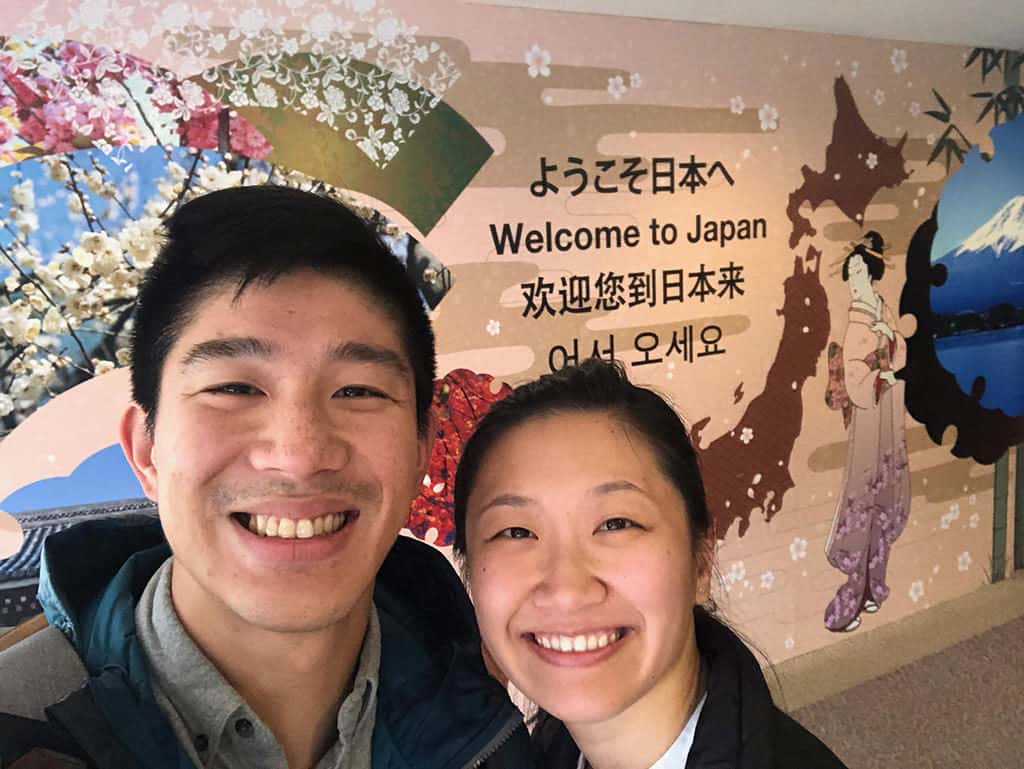
There are two main airports that service the city – Narita International Airport and Haneda Airport . Both cater to international arrivals and honestly if you had the choice, I would recommend flying into Haneda over Narita because it’s closer to the city and it has cheaper transit options compared to the alternative.
When you come out to the arrivals hall, you’re going to be overwhelmed with all the people waiting there and all the various stalls lining the wall. Your research ahead of time should help you figure out where you need to go as it really depends on where you’re going to in the city.
For some, the stalls right at the arrival hall floor will be what you’re looking for. Otherwise, you’re going to need to take the escalator down and that’s where you’ll find the huge JR storefront. This is also where you’ll find Keisei line.
We weren’t sure where to go at first so we asked the staff and they were very helpful in directing where we should go
For us, since we needed to be at Mizue Station, we caught a Keisei Main Line (Limited Express) train where we would eventually get off at Yawata. This cost 1,720 JPY.
Alternative options:
- Narita Express a.k.a. N’EX – 4,000 JPY but free with JR Pass
- Keisei’s Skyliner to Nippori and Ueno – 2,470 JPY
- Tokyo Shuttle bus to Tokyo Station – 1,000 JPY
- Taxi – Just don’t do it
Like I said, Haneda is a convenient airport to fly into because it’s that much closer to the city and even closer if you’re staying in Yokohama.
The easiest way to get in and out of the airport is through either the Monorail for 490 JPY or the Keikyu Line 580 JPY to Tokyo Station.
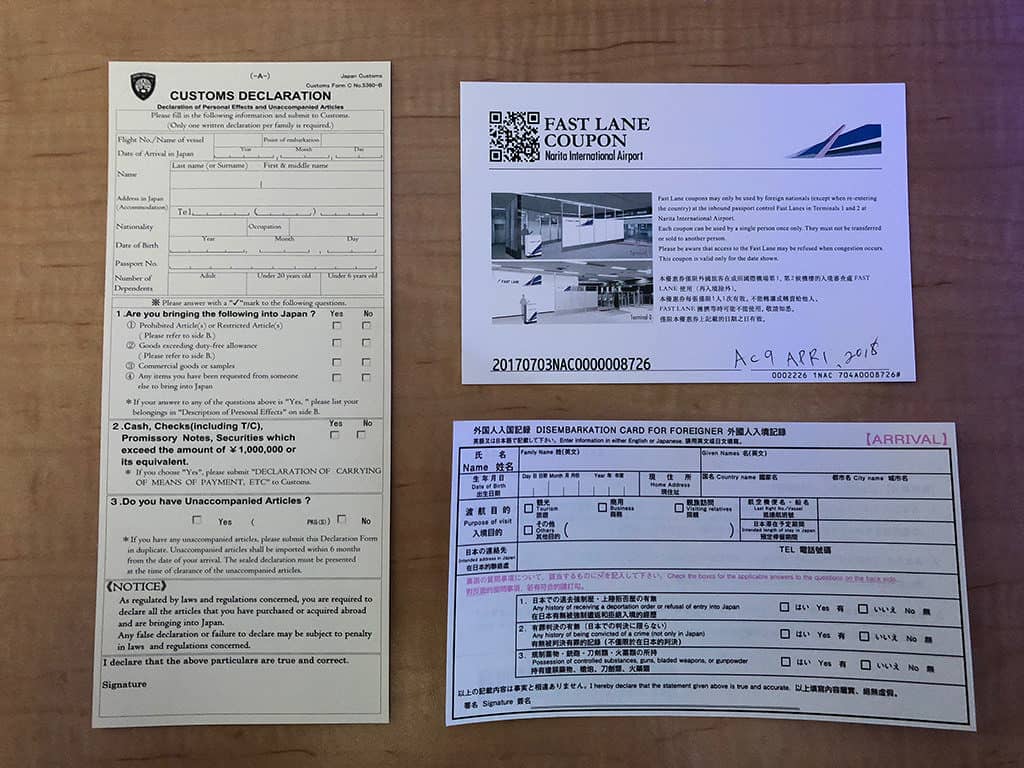
Did you know? Both airports have free wifi which is handy.
Keep in mind – Officially, there are accessibility options in the underground but they aren’t the friendliest in convenience. We brought only carry-on luggage with us but there were a ton of times we had to carry them up steps.
Where to stay in Tokyo?
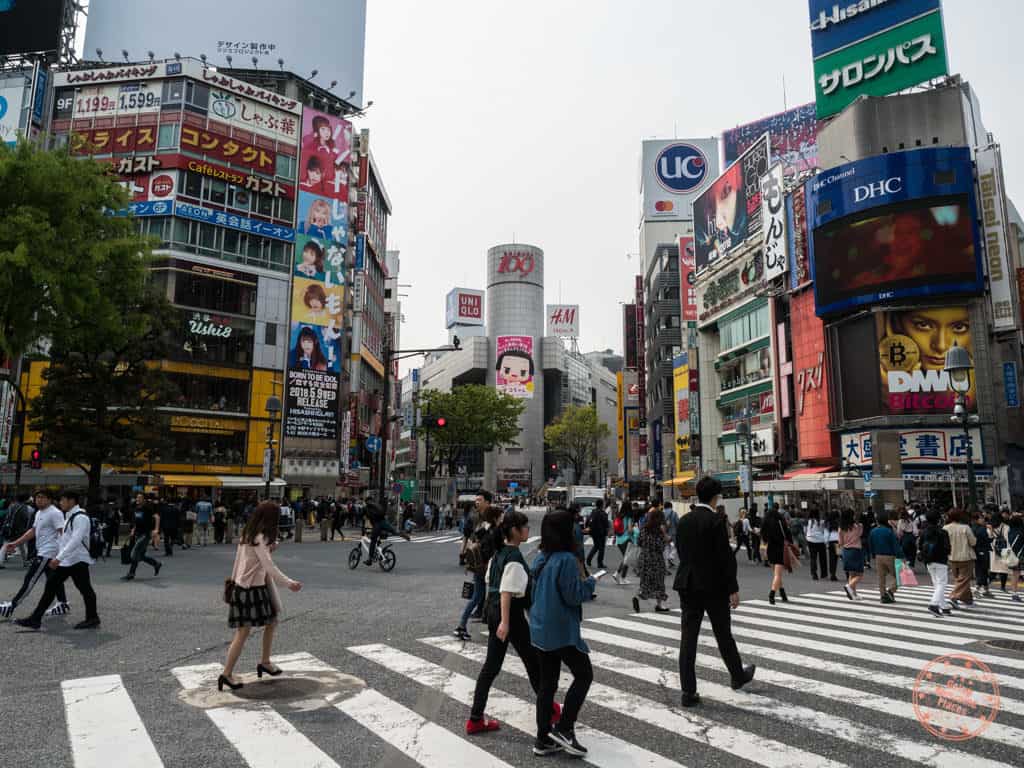
Talk about some serious contrast. Between our two trips to Tokyo, one was an ultra luxurious stay on points and the most recent one, an Airbnb at the fringes of the city.
There is a lot of choice of accommodations in Tokyo but to help you make your decision, the few things that you want to think about are:
- What is your budget?
- What neighbourhood do you want to be in?
- Do you want to do a pod hotel?
- How close do you want to be to a subway station (the answer is “very close”)
Where did we stay?
Like I said, truly a tale of two properties. The below are two of the places we’ve personally stayed at. Let me go into why you should one of those would be a good choice for you and if those don’t float your boat, I have a solid recommendation you can think about.
Remember, for additional savings, my Booking.com offer to get $25 CAD back is still on.
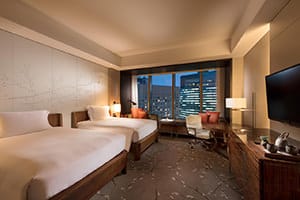
CONRAD TOKYO
This property is well deserved of Hilton’s top brand. Located near Shimbashi and Shiodome, this is located in a financial area which means there isn’t too much around directly in its vicinity but Shimbashi certainly makes up for it. We stayed here on points back in 2012 and were very impressed with the room, executive lounge, the lobby, and impeccable service.
TripAdvisor
Booking.com

AIRBNB IN EDOGAWA-KU
Since we booked our most recent trip to Tokyo very last minute and during the Cherry Blossom season, we elected to stay somewhere a little further away from the city to save money. Browsing through Airbnb’s supply, we encountered this particular room at $22 CAD a night. While cheap, this was definitely a no-frills kind of place (we even had to bring our own pillows). Bathrooms were communal as well in this 5 room house so in a lot of ways it was like a hostel. The walk to the Mizue station on the Toei line was roughly 13 minutes and another 30 minutes into the city. Can’t beat the price though.
If I were to do it again, I’d probably recommend a place like this.
CONSIDER THIS
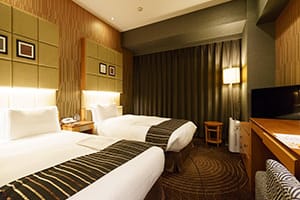
HOTEL SUNROUTE HIGASHI SHINJUKU
Located near Shinjuku, this hotel is conveniently located 10 minutes walk from the Isetan department store and more importantly right by the train station. The rooms are spacious, clean, and comfortable and up to standards as a mid-level hotel.
Neighbourhoods you want to be near
So as you can see, two drastically different accommodation experiences in Tokyo.
Having done both, I can confidently say that, staying in the city is much better. I say that because of convenience. When staying in the suburbs of Tokyo, we wasted a good 2 hours each day just commuting back and forth. Another thing you want to take into consideration when picking a neighbourhood is whether you want to go to the Toyosu Fish Market. It’s in an awkward part of the city and to make the 5:30AM meeting, you will either have to take a cab or stay right by Toyosu. I have a full new guide on the Toyosu Fish Market tuna auction experience .
Here are a few neighbourhoods that you want to consider being close to especially with their high concentration of things to do and restaurants.
- Shibuya – Famous for the crossing but also awesome for shopping, restaurants, and bars
- Shinjuku – A place that is super lively at night. This is where you’ll find Piss Alley but also the amazing Shin Udon.
- Akihabara – Nerd central here and a must-do for anyone that loves anime and electronics. Conveniently located and with tons shopping and restaurants nearby.
- Tokyo Station/Ginza – One of the more expensive areas to stay but if you can swing it, you’re right in the heart of some of the best food, shopping, and attractions like the Imperial Palace.
- Harajuku/Omotesando – One of my favourite areas as it’s a clash of the fancy shops along the main strip of Omotesando and then you have the quirky and grungy Harajuku. Meiji Shrine is also right there.
- Asakusa – Asakusa is one of the most popular destinations among tourists coming to Tokyo for the famous Kaminarimon gate and Sensoji temple. However, if you want to learn something about Asakusa or Japanese culture and explore less “touristy” places, it’ll be better if you have a local guide. This Asakusa Cultural & Street-food Walking Tour is offered by Magical Trip and you’ll have a informative and friendly guide who will give you a lot of new knowledge. For lunch you’ll cook Okonomiyaki or Monjayaki for yourself with an instruction from your guide and taste it!
- Ikebekuro – We didn’t get to visit here but I know this is a popular place for many restaurants.
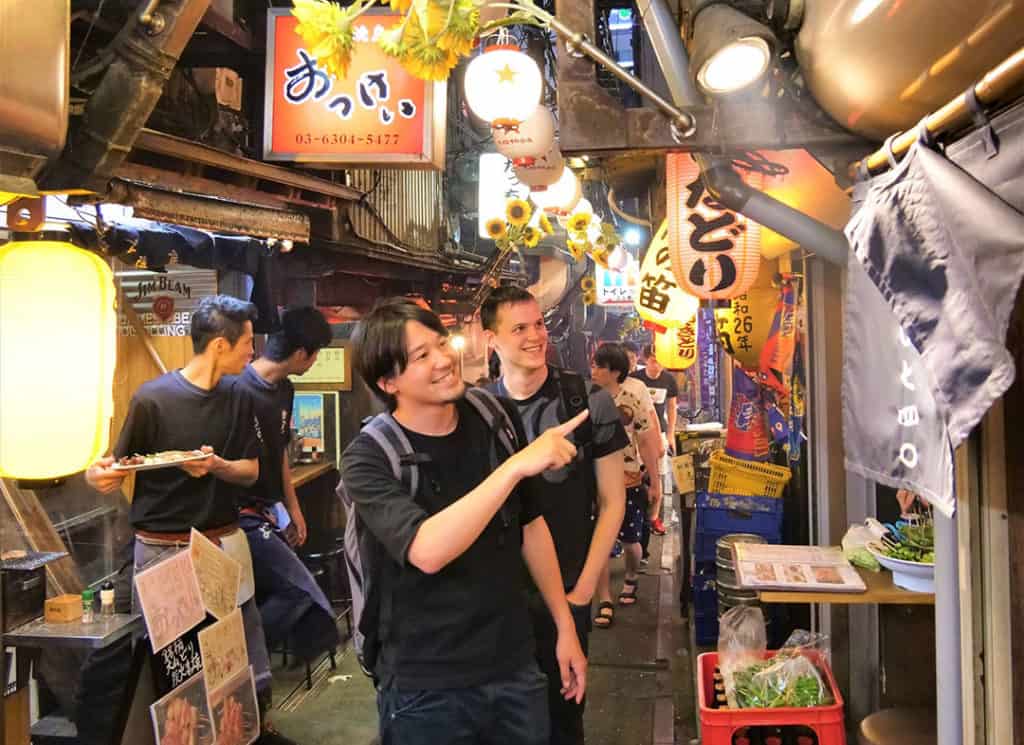
Tip: If you want to enjoy the nightlife, especially local drinking and dining culture in Shibuya and Shinjuku with awesome local people, Tokyo Bar Hopping Food Tours by MagicalTrip is your best choice
Did you know? Coming from North America? Good news! You don’t need any outlet adapters. It’s the same plug and almost all electronics you have now have no issues with Japan’s 100V vs 120V.
Getting around Tokyo

Alright one more thing before we get into the meat of what you care about. This is a super important topic in my opinion because this is what’s going to give you the most headache.
As I mentioned, there are a lot of options when you’re in Tokyo and that’s a great thing because it can take you anywhere you want to go. What’s not-so-great is the fact that there are so many companies. It almost feels like you need to be choose sides when you’re in the city. Do you align yourself with Tokyo Subway? Toei? JR? Keikyu? Tokyu? Odakyu? Keio?…you get the idea.
Which is the best line?
If you’re looking for the most comprehensive lines, Tokyo Metro is going to be your best bet. They also work closely with Toei which creates a very wide network.
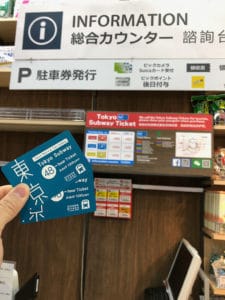
What pass should you get? Luckily, there’s are very affordable Tokyo Metro + Toei day pass options which in my opinion offers the best value .
- 24 hours – 800 JPY
- 48 hours – 1,200 JPY
- 72 hours – 1,500 JPY
These passes are great if you think you can make it work with one line and you know you’re going to be taking it quite a bit.
The tricky thing you have to consider though is where to buy it. When you land in Narita or Haneda, you should buy it right away and that’s a no-brainer but if you’re trying to buy one in the middle of your trip, it’ll be a bit more work. You can either buy them at designated Tokyo Metro Pass Offices in specific stations or you can try to find a nearby BIC Camera or LAOX electronic stores. There were several times where we weren’t able to link up one pass with another because 1) they don’t allow you to buy multiple passes and 2) we lived by a station that didn’t sell these passes.
When buying the pass, make sure you have a passport with you. For all the locations where you can buy the pass head here .
What about the JR line?
Love the JR line but unless you somehow have excess hours from your JR Pass , I don’t think it’s worth it to get special day passes with them.
That being said, the JR Line can come in handy for some routes especially with their Yamanote and Chuo Lines. That’s where the IC cards come in handy.
Be company agnostic with IC Cards
For years I relied on the special day passes but what you should be looking for is an IC (tappable) card once you land. The main reason is because these cards work on any and all systems. All you have to do load money into it and you tap-and-go. There is also a small discount offered on the fare to promote the use of these cards.
The one I’d recommend getting is PASMO which you can buy from a machine without having to go to a special location.
The deposit for a PASMO card is 500 JPY. All you have to do is load money onto the card and then that allows you to tap the card when you take any line in Tokyo. There’s a small discount for using the card and you won’t be restricted to any specific company.
A competitor to PASMO is Suica but they are essentially the same thing especially in Tokyo. Japan Rail Pass explains the difference very well in its FAQ .
Tip: If you want to be super organized and have everything ready before you arrive, you can get a Suica card online and pick it up at the airport , or even have it shipped internationally , although it might cost a bit more.
What gotcha’s should you look out for
From personal experience, I have two examples of when I was a little frustrated with the subway.
- We wanted to get from Shibuya to Ebisu . Look on the map and you’ll see that there’s no direct way to do that with Tokyo Metro. While it would’ve been one stop with JR’s Yamanote Line, we were committed to Tokyo Metro with their 48 hour pass. We looked at the transfers we’d need to do and decided that walking it was a better choice instead. That said, you could totally take the Tokyo Metro where you can refer to their subway map to find out the best way to get from stop to stop.
- We were in Asakusa and we were looking for a way to get home. We followed signs to the Asakusa station but when we went underground, we realized the station was run by a company called “Tsukuba”. This is when we realized we went the wrong direction completely. In frustration, we double backed to head to the Tokyo Metro and Toei’s Asakusa station.
Lesson learned: Look more closely at the map and go with a PASMO card next time so you’re not locked into a specific train company like we were.
Are you read to eat?? You better be!
FINALLY, we got all of the boring stuff out of the way. Don’t worry, it was part of the strategy. Just like waiting in line for food, my theory is that the food always tastes 10x better because you’re so hungry at that point.
The one thing that you notice immediately with food in Japan is how meticulously prepared and presented everything is. It’s not just the beautifully displayed plastic models of food but it’s also the the careful selection of Japanese ingredients that are paired together, and the freshness of what’s used to really bring out the flavours.
Whether you do a Tokyo Night Foodie Tour in Shinjuku or go out on your own, there are so many things you have to know about food in Tokyo but let’s start with the basics.
General things you need to know for feasting in Tokyo:
Best value for meals: As Mark Weins recommends , lunch menus are indeed that much cheaper than dinner. Now this doesn’t apply across the board as there are a number of places that are only opening for dinner. From my experience, this only applied to fancier restaurants like Tempura Shinjuku that we visited. If you plan on doing omakase, lunch is always cheaper than dinner if offered. As Mark did, we often had 2-3 lunches a day and did something much more casual for dinner.
Places don’t open that early: One thing you learn pretty quickly is that most restaurants don’t open until 11AM so as much as you’d like to start your eating earlier so you can spread things out across the morning and afternoon, it’s quite hard to do because of the starting hour. The only exception is of course Toyusu Fish Market. As a result, use the mornings to either make sure you’re first in line at a place, do Toyosu, or sleep in.
Tipping: I love that tipping is not part of Japanese culture. What you see is what you pay and nothing more. There’s no expectation to tip and some will in fact reject it even if you try.
Cash vs. Card: How card friendly is Japan? It’s actually quite easy to use credit card throughout the country. I was half expecting American Express to be rejected in many places but I almost used my awesome point earning cards with ease. That being said, it’s good to have cash on hand because there will be lots of places that won’t accept it or it just wouldn’t be convenient to. Street food, Tsukiji outer market vendors, and Piss Alley are good examples.
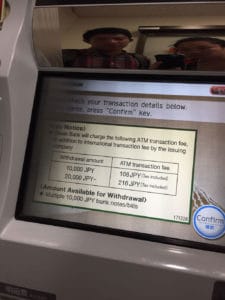
Withdrawing from ATM: During our two trips to Japan, we never found an ATM that didn’t have any fees. In fact, most of the “official-looking” would reject our Canadian debit card. The one place which would take our card was the ATM inside the 7-Eleven. The fees are unavoidable and at the time of writing, it cost 216 JPY for withdrawals > 20,000 JPY and 108 JPY for a 10,000 JPY withdrawal. The machines also only dish out denominations of 10,000 JPY.
Tax: One thing I’ve gotten used to in Asia is not having to deal with tax but Japan does have tax (sometimes) and the current rate is 8%. What wasn’t clear though is that there were definitely places that didn’t seem to charge tax but those tended to be the more local cash places and it’s possible tax was included in the price.
Depachika: These are the basement floors of big department stores. If you din’t know, you might hesitate to go to a fancy looking luxury mega-plex but then you’d be missing out on all the amazing food. From hot foods to desserts, Depachika’s are a feast for the eyes. Most of the times you won’t know the items are but this is a great place to randomly try things. Ginza is a prime example of this where high-fashion Matsuya, Ginza Six, and Mitsukoshi are hiding a vault of deliciousness.
Finding restaurants: Honestly, without data, we would’ve had 10x more trouble finding some of these restaurants. What you’ll find is that many restaurant names are only in Japanese characters. While it may have a translated English phonetic name, you’ll see no such name at the storefront. There were many times where we had to search for images of restaurant to see what the entrance looked like. If you don’t have data, I highly recommend you taking screenshots of the restaurant before heading out. Another thing to keep in mind is that there are a lot of restaurants hidden in multi-story buildings so you have to look for their name on the sign outside to figure out what floor they’re on.
Etiquette: We learned this from our time with Arigato Japan Food Tours , here are 3 taboos for chopsticks that are worth knowing:
- Don’t pass food to another person from chopstick to chopstick
- Don’t stick your chopsticks vertically in your bowl of rice
- Don’t pull your plate or bowl with your chopsticks
Eating on a budget: Tokyo isn’t a cheap place to travel nor is the food friendly for those on a serious budget but there are a few ways to do it if you’re looking to save money in between the splurging you might do :D

- 7-Eleven and other convenient stores – Like what we experienced in Taiwan , there is a ton of awesome food to pick up here. My favourite are the rice triangles called Onigiri especially with tuna or salmon. Anything you find here is usually pretty cheap.
- Bento boxes in Depachika – While food in depachika’s aren’t always cheap, there are great gems here. Seek out the bento boxes as they’re pretty tasty without being overpriced.
- Bakeries – Similar to Chinese bakeries, buns, breads, cakes, and pastries of all sorts can be found here. These typically make great breakfasts or if you need a quick meal on say a train ride.
- Fast food – You’ll see chains such as Yoshinoya and Sukiya all around the city. While we tried our best to avoid these, they’re good for a quick cheap bite in a pinch.
- Vending machine restaurants – On our food walking tour , we passed by a number of ramen shops frequented by salarymen (what they call the homogenous men in suits) that had vending machines where you’d pay for your noodles up front and be served in minutes. They’re not going to be the best quality but I’m sure they could beat many restaurants back home any day and still be affordable.
You can’t really share food: Originally we thought we could try to share dishes in an attempt to try more restaurants during lunch but we learned quickly that this strategy doesn’t really work in Japan because of the limited space. Some have explicit rules and others you just didn’t want to be THAT tourist.
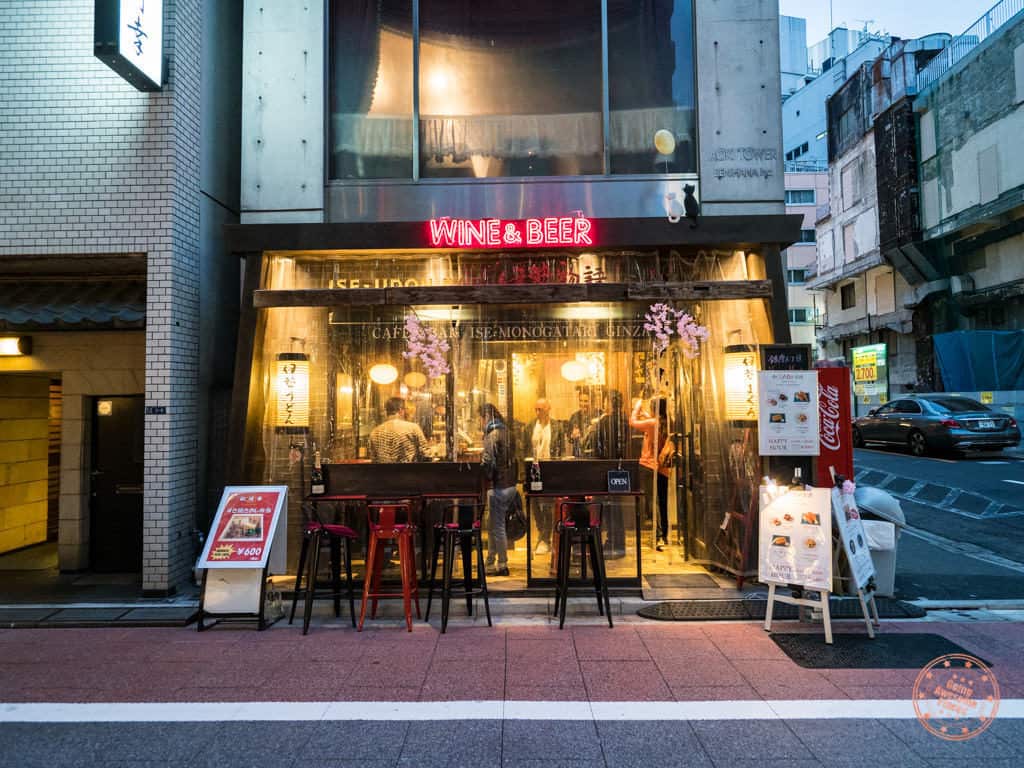
Think about doing a food tour: As much as you’re going to want to eat often and always, the size of your stomach and metabolism are going to smack you in the face. An awesome discovery we made was how good the food tours run by Arigato Japan Food Tours are. Instead of being limited to a dish per person when going out for dinner, sample an assortment foods in one night across a number of hidden gem restaurants in the company of a super knowledgable guide and fellow travellers. The particular tour we did covered Yurakucho, Ginza, and Shimbashi and is called their Allstar tour .
Wait so what happened to Tsukiji Fish Market?: That’s a great question. As of October 11, 2018, Tsukiji’s inner market shut down and everything shifted over to the brand new massive grounds of Toyosu Market. The good news is that Tsukiji’s outer market is still fully intact so I think it’s still worth going there because there’s a lot of food to try there and a ton of vendors that stayed. The bad news is that all the top restaurants (Daiwa, Sushi Dai, Nakaya etc.) and the tuna auction have moved to Toyosu which is further away and slightly more inconvenient to get to. I’m not going to go through how Toyosu Market works but I visited again in 2019 and I share everything I learned including the lottery system.
Explore Tsukiji with Magical Trip . On this Tsukiji Fish Market Tour by Magical Trip, you’ll walk around the famous Tsukiji fish market with a local guide, getting some new insights into the Tsukiji area and Japanese culture. You will also visit the Japanese Buddhism Temple and Shinto Shrine to find what our religious culture is like. And, most importantly, you will have a gorgeous seafood DONBURI (bowl) for lunch.
9 Best Restaurants You Have To Try
My mindset of these restaurant selections was that I was looking for places that weren’t going to blow up the bank, didn’t require reservation, but were highly recommended and ranked by other influential food blogs. I also took the advice of a number of friends that I consider to be foodie experts in Japan. What I didn’t use was anything like TripAdvisor or Yelp.
Let me be clear though, we were in the city for 6 days , and really less if you factor in our time in Tochigi, so we were quite aggressive in working out our stomachs and our feet. You can do it too but carefully plan out how you’re going to break down your days and your spread of Japanese food you’re going to try. What I mean is, if you already have a good tempura place in the plans, that means that you should probably cut out any other good tempura restaurant you also have in your list. If only you could do it all right?…or could you?
Here are my picks for top restaurants you’re going to want to add to your Tokyo itinerary whether you only have 1 day or 2 weeks. They range from small stalls, dessert shops, and fancier establishments. They are in no particular order but the ones near the top are the ones I have a little more attachment to but honestly all are worth going to. Here we go!
1. Uoriki Kaisen Sushi (海鮮 魚力 渋谷東急東横店)
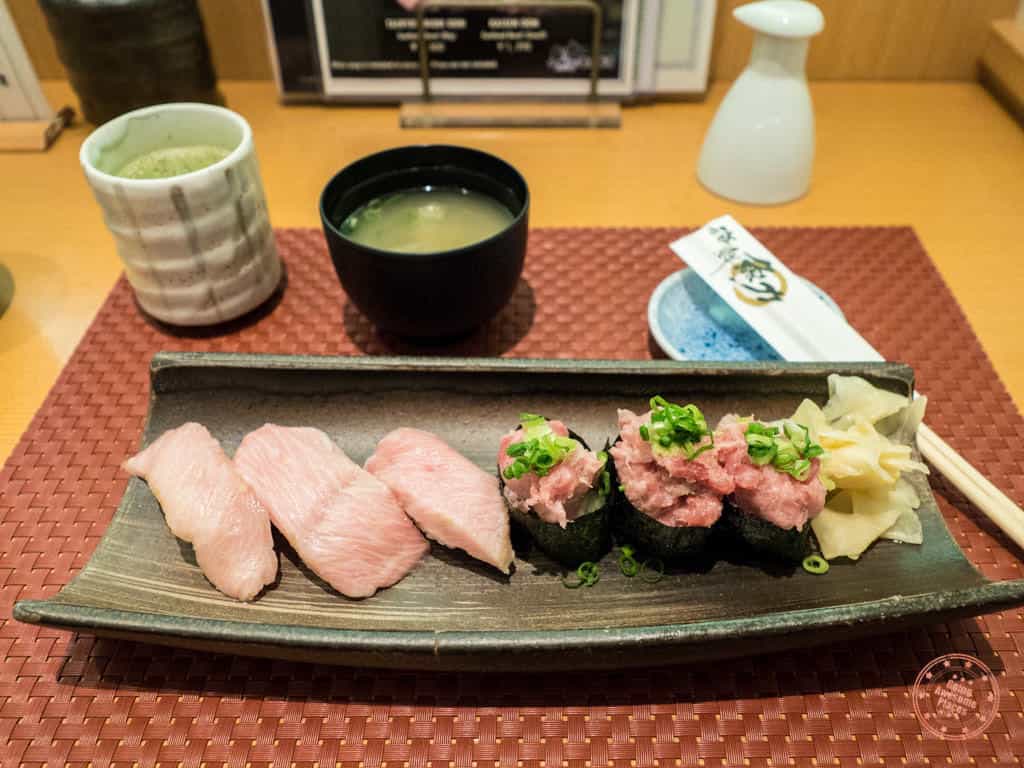
Tucked away and hidden next to a giant supermarket is this nondescript sushi restaurant that we never would’ve gone to if it wasn’t recommended to us. You could tell that it was super local too when we wrote our name down on the piece of paper and sat beside two grandmas that were also waiting for a spot.
The sushi here was fabulous especially the fatty tuna which was seriously melt-in-your-mouth good. Out of all the toro that we had in Tokyo, Uoriki was definitely the most memorable and most fatty. For the tuna set, I preferred the nigiri because you could really taste the textures and flavours of the fish while Chantelle liked the maki more because of the combination of diced tuna with scallion.
The seasonal sushi set we had was GOOD but the uni that day disappointed a little as it didn’t have quite the creamy texture we were expecting.
When ordering they asked us if we wanted wasabi but what they really meant was whether we were okay to have wasabi in our sushi which we did. All you have to do is dip in soy sauce and enjoy.

Neighbourhood: Shibuya Open hours : 10AM – 9PM M-Su Address : Basement floor (B1) of the Tokyu Department Store at Shibuya station ( see map ) Price : Fatty tuna set (1,500 JPY – $14 USD), Seasonal sushi set (2,000 JPY – $19 USD) English menu?: Yes
2. Shin Udon (慎)
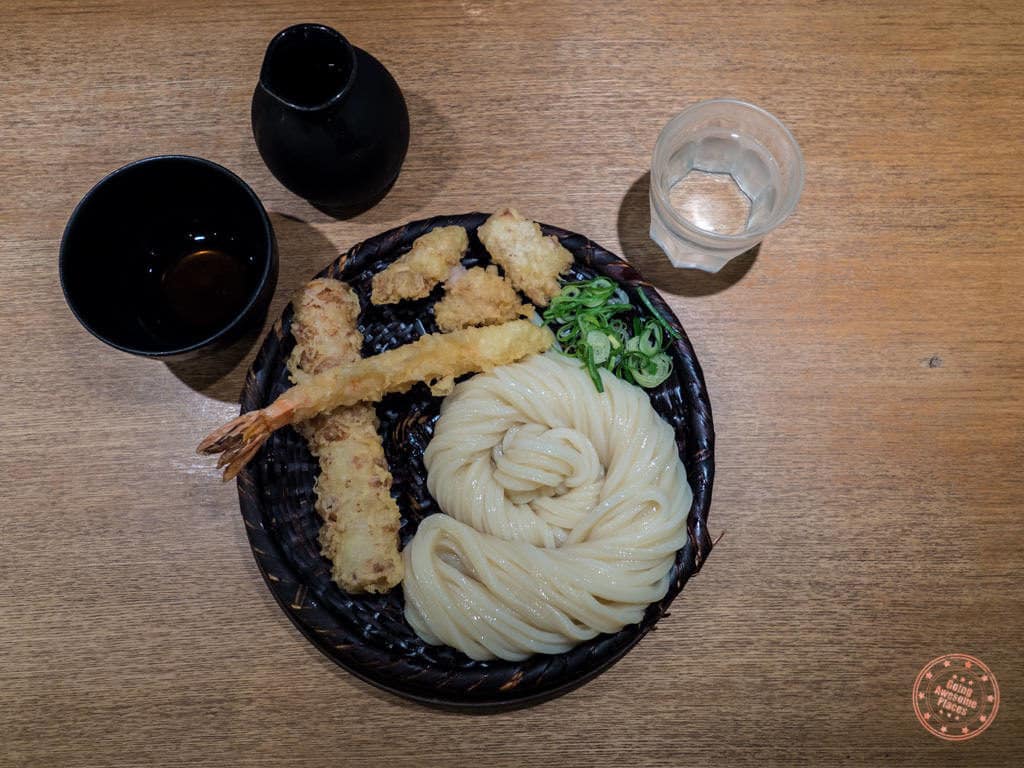
Ramen gets all the hype these days but what about its friendly, slightly chubbier cousin udon? Well friends, not to worry because udon is making a comeback here at one of the few restaurants we actually waited in line for.
We didn’t know what to expect when our friend jotted this place down in a Whatsapp message a few days before leaving but the timing of our hunger worked out when we ended up in Shinjuku. Arriving just past 7:30PM, we had to navigate a quiet dark alley before turning into another alley, but this time with a crazy line of tourists.
When we finally got inside, we could see why it took so long. With a maximum of 12 seats, it’s tight quarters inside which is pretty common in Tokyo. True to Japanese efficiency, we put in our order while we were in line so it only took 10 minutes for us to receive our udon.
I ordered the soy sauce udon noodles with yuzu pepper jelly, grated daikon radish, and chikuwa (bamboo shaped fish cake). Chantelle ordered the cold bamboo tray of noodles with shrimp tempura, chikuwa, and kashiwa (chicken) tempura.
Verdict? This is hands down the most amazing udon we’ve ever had. Thanks for our line mates who were Tokyo locals, they said the best way to truly appreciate the handmade udon is with a cold udon dish and boy were we glad we did. The al dente noodles had the perfect amount of bounce that you never get from the frozen udon we buy at home. The flavour combination was also excellently done especially with how the yuzu was used to delicately balance the grated radish. I normally don’t like radish but when you put it all together, it’s some kind of amazing.
Chantelle’s tempura was also perfectly battered – crispy on the outside while tender inside. While they looked somewhat similar, hers came with a soba-like sauce.

Water is included at no cost. We sat at the bar table and there was a big jug in front of us.
Other recommended items: There’s a cold udon with waygu chuck eye roll with chopped yuzu for 1,950 JPY but it was sold out by the time we ordered.
Neighbourhood: Shinjuku Open hours : 11AM – 10PM M-F, 11AM – 11PM Sa-Su Address : ( See map ) Price : Soy sauce cold udon with yuzu (1,250 JPY – $12 USD), cold udon with tempura (1,300 JPY – $13 USD) English menu?: Yes
Read TripAdvisor Reviews
3. Yakitori Ton Ton (登運とん)
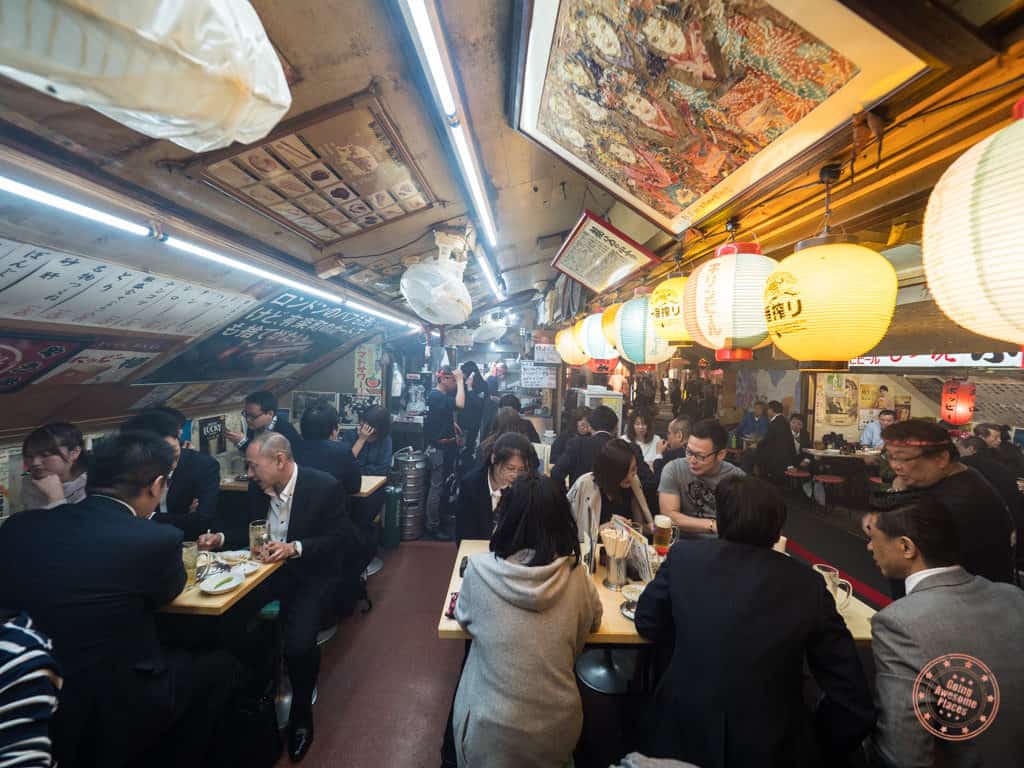
If eating meat on sticks and drowning them in beer sounds like your thing then you have to add this spot to your list of restaurants. There’s no livelier and more local place than this hole in the wall, under the train tracks, yakitori restaurant.
When we came out of Shimbashi station to look for this place, we weren’t sure if we were heading the right direction but we continued to follow the raised train tracks and all the restaurants below them till we started hearing more noise. When we found this busy throughway and matched the characters, we knew were at the right spot.
With small tables stretching out onto the walkway, smoke billowing and desperate to reach open air, the clanging of glasses, salarymen roaring in conversation, and sizzle from the grill, we anxiously waited in anticipation for our table.
Luckily for us, it wasn’t long until two other tourists finished and we got our spot. Overall I’d say the crowd was mainly local but the word has definitely gotten out to travellers so you’ll see them scattered around. That said, the place isn’t big at all. If you watch the video, I don’t think it could fit more than 25 people.
Thanks to the English menu we were able to put our order in pretty quickly and one by one, succulent skewers of chicken, pork, meatball, gizzard, green pepper, alongside takowasabi (diced octopus in wasabi – omg the best), and beer on tap came to our table. It was heavenly.
What made it such an awesome experience was that we were eating with all of the other salarymen and women that had just gotten work, there was a kinetic energy that we could feed off of, and of course all of the skewers we had were grilled just right. Nothing was overcooked. The chicken was so good that we ordered a second serving.
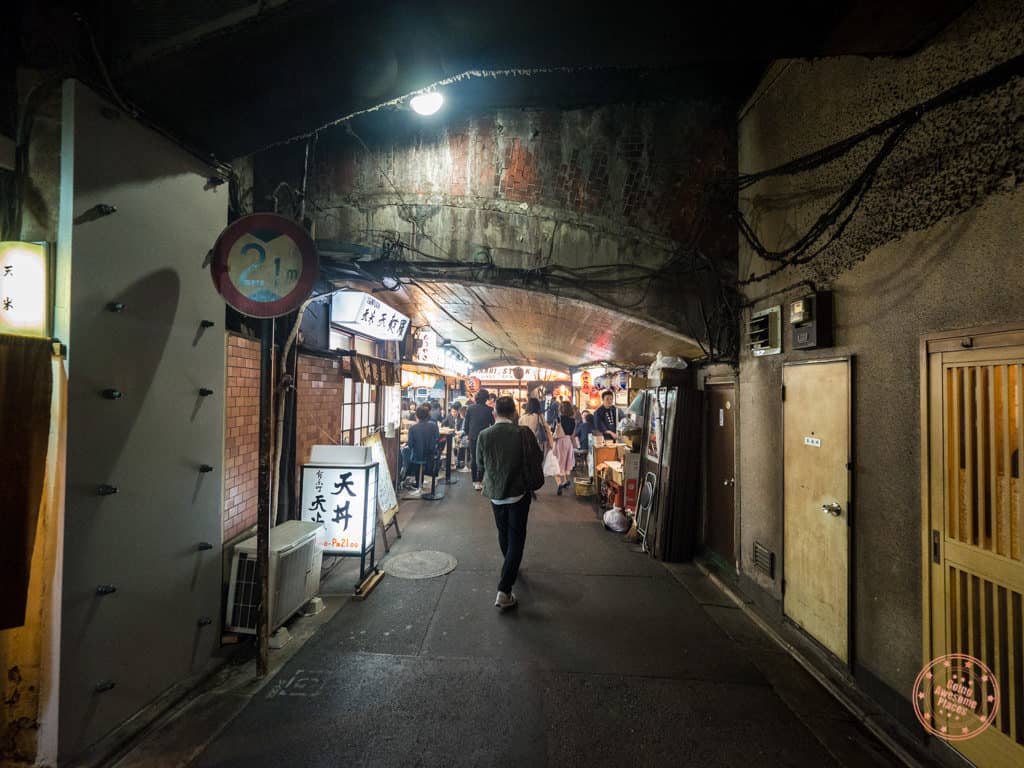
There are two identical yakitori restaurants on this throughway. Only one of them is this one. The other is a different restaurant but from what I saw, I don’t think you could go wrong with either.
Before we were seated, they made sure we understood the rules: 1) Each person must order at least one food item and one drink item 2) When it’s busy, the max seating time is 60 minutes 3) Prices do not include tax 4) It’s cash only.
Neighbourhood: Yarakucho/Shimbashi/Ginza Open hours : 1PM – 11PM M-Th, 12PM – 11PM F-Su Address : ( See map ) Price : Assortment of skewers, two servings of takowasabi, and drinks (4,276 JPY) English menu?: Yes

4. Nakaya (仲家)
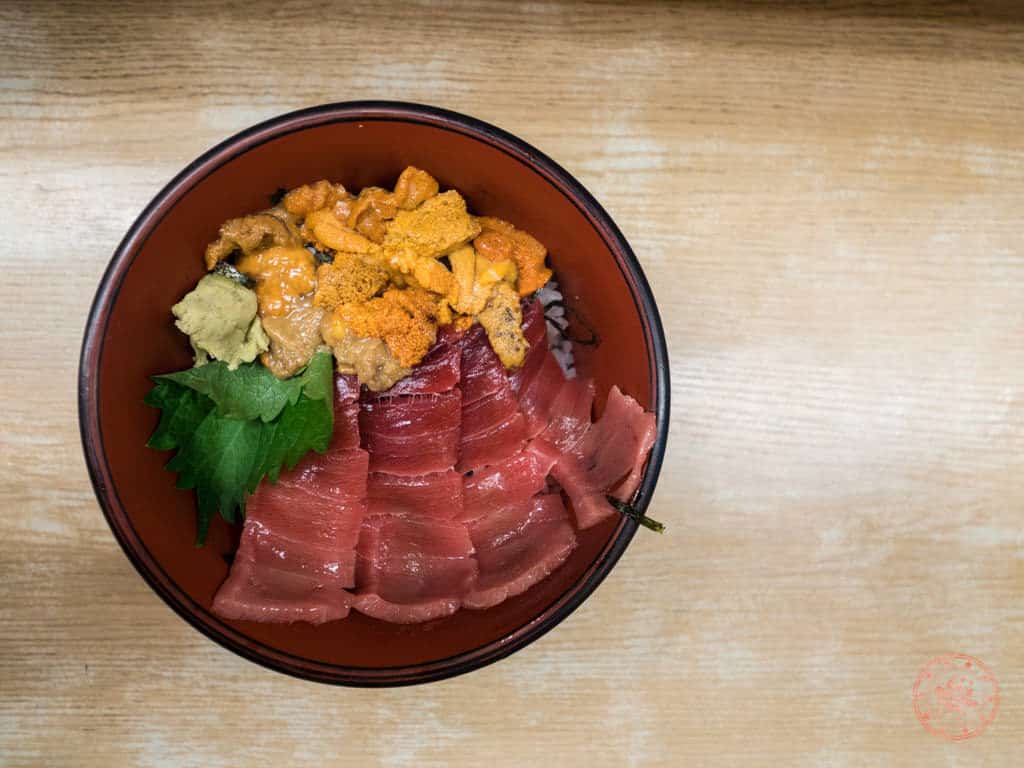
Nakaya is now at Toyosu

I can confirm that Nakaya has now moved to Toyosu Market from Tsukiji. They can be found in the Fish Intermediate Wholesale Market Building and the floor of restaurants. Saw the same chefs and assistants working there. I’ve kept my description of Nakaya the original from my experience at Tsukiji. Read more about Toyosu
You could say that Tsukiji Fish Market is a pilgrimage of sorts if you love sushi. Sure there are better and fancier Michelin rated restaurants in Tokyo but a trip wouldn’t be complete without a visit to one of the sushi restaurants here and for breakfast no less.
In a previous trip to Tokyo, we had done Daiwa Sushi which was an amazing experience. It’s one of the two sushi restaurants at the market that constantly get reviewed. This time though, we didn’t feel like getting up at 4AM to get sushi so we instead woke up at 6AM to get to this restaurant at 7AM.
The beauty of Nakaya when we arrived was that there was no line at all. In fact we showed up, gave our order to the lady in the front, and after one couple came out, we were seated inside at counter seats.
Where Daiwa Sushi was that omakase (chef’s selection) style of menu where you got each nigiri one at a time, Nakaya is all about chirashi which means sashimi on a bowl of rice.
Our bowls came out lightning fast and the fish as fresh as it gets. I personally thought the toro was better at Uoriki Kaisen Sushi but the uni was insanely good here.
The only thing I found was that the service at Nakaya wasn’t the most friendly especially for foreigners but that might’ve been because of all the photo and video I was doing there.
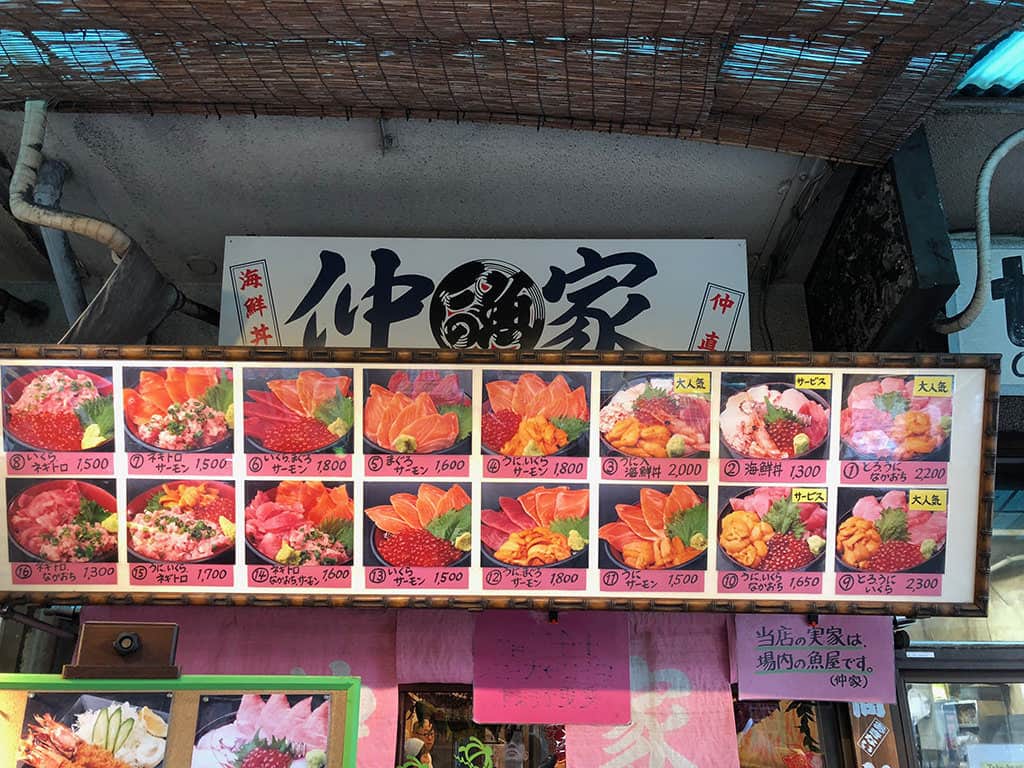
Neighbourhood: Toyosu Open hours : 5AM – 2PM M-S (closed on Sunday and holidays) (these are the old hours at Tsukiji) Address : ( See map ) Price : Mixed sashimi chirashi (2,000 JPY – $19 USD) and uni + toro chirashi (2,300 JPY – $22 USD), Cash only! English menu?: No, but there is a huge menu with pictures at the entrance so just point and order
All the details about Toyosu Fish Market
If you want to get the lottery tickets to see the tuna auction at the Observation Deck level or curious about the buildings that are spread out including where Sushi Dai and Daiwa Sushi are, make sure to head on over to a new detailed post all about how it works.
How the Toyosu Market Works
5. Sometaro Okonomiyaki (染太郎)
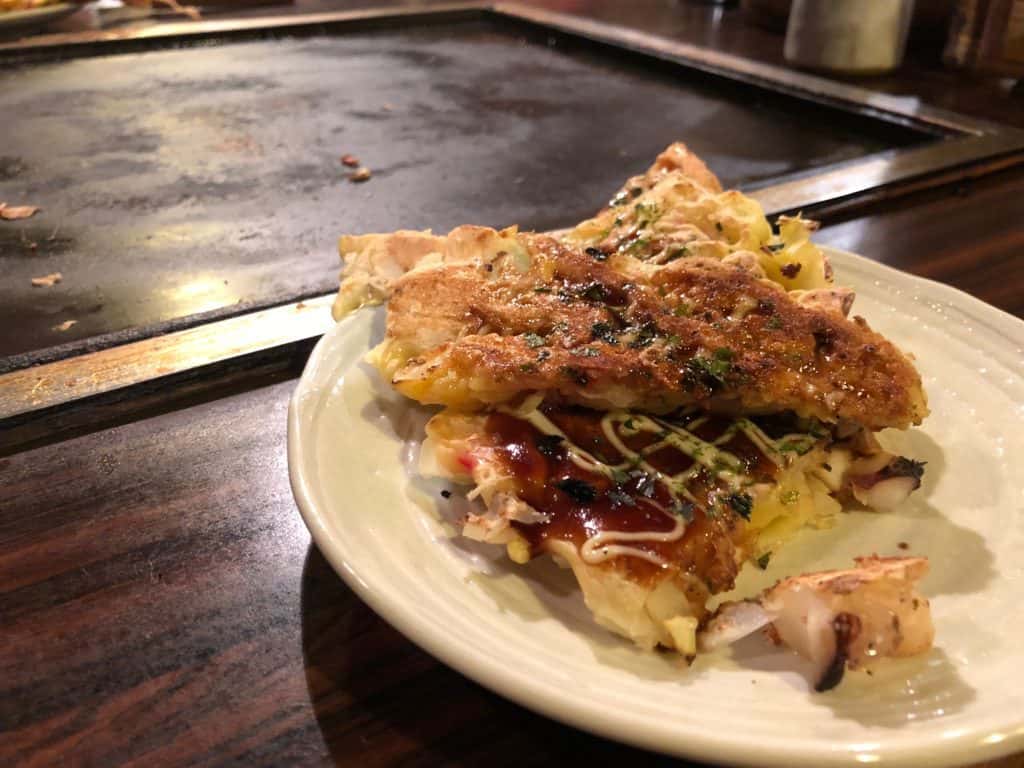
Okonomiyaki is a savoury Japanese pancake that you have to have in different parts of the country because every region has their own take on this popular dish. The Kansai region (Osaka) and Hiroshima are said to be the place or origin but if you don’t make it out there, you should definitely have it in Tokyo.
What makes the okonomiyaki experience so unique in Japan is that restaurants that specialize in it allow you to make it yourself. That’s good or bad depending on how you look at it. Do you really trust yourself to make okonomiyaki?
Regardless, it’s a really fun experience especially at a restaurant like Sometaro which is rebuilt to be in the atmosphere of the Showa period. Stepping inside is a bit like going back in time with nostalgic posters on the wall, photos everywhere, and well-loved and aging tatami flooring, and mini teppanyaki griddle.
Okonomiyaki is essentially a mixture of tempura batter with a variety of ingredients depending on what you order. They come in a bowl and the rest is up to you. Following the instructions in the menu, you melt something like butter on the hot plate before pouring the batter on in the shape of a pancake. The key is to split the batter in two, otherwise it’s too difficult to flip. Once it’s done, you decorate it with mayonnaise, teriyaki sauce, and seaweed flakes. Using the spatula you split it up like a pizza, serve, and enjoy!
The two types that we ordered were Gomokuten which is essentially the house special with seafood and minced meat and Mochiten which was pretty unique with corn, rice cake, and cheese. Both were super tasty and loved Mochiten because you know I love my mochi.
I’m not going to lie, this is a touristy area because of its popularity. In the area that we sat near the back, it was all foreigners. That said, I loved the ambiance of the place and being on a bit of a culinary adventure of trying to figure out how to make something on your own. It was funny how we totally screwed up our first okonomyaki but figured it out with our second one.
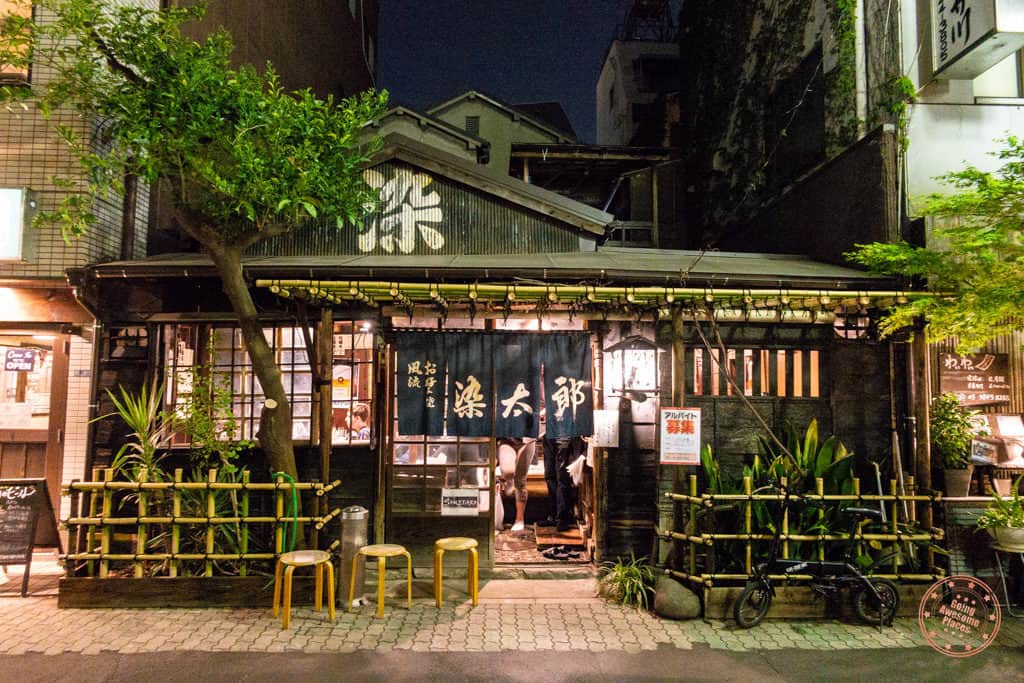
Water is free and at the back of the restaurant. On the rack you can grab a cup and fill it up yourself.
They will ask you to take off your shoes ahead of time. There are plastic bags at the front where you’ll be able to put your shoes to bring inside.
It gets hot there with all of the griddles going. They provide handheld fans just for this reason so be prepared to peel of a few layers.
Neighbourhood: Asakusa Open hours : 12PM – 10PM daily Address : ( See map ) Price : Gomokuten (870 JPY – $8 USD) and Mochiten (760 JPY – $7 USD) + Sapporo English menu?: Yes. Waiters know English as well.
6. Tempura Shinjuku Tsunahachi Ginza (天ぷら新宿つな八 銀座店)
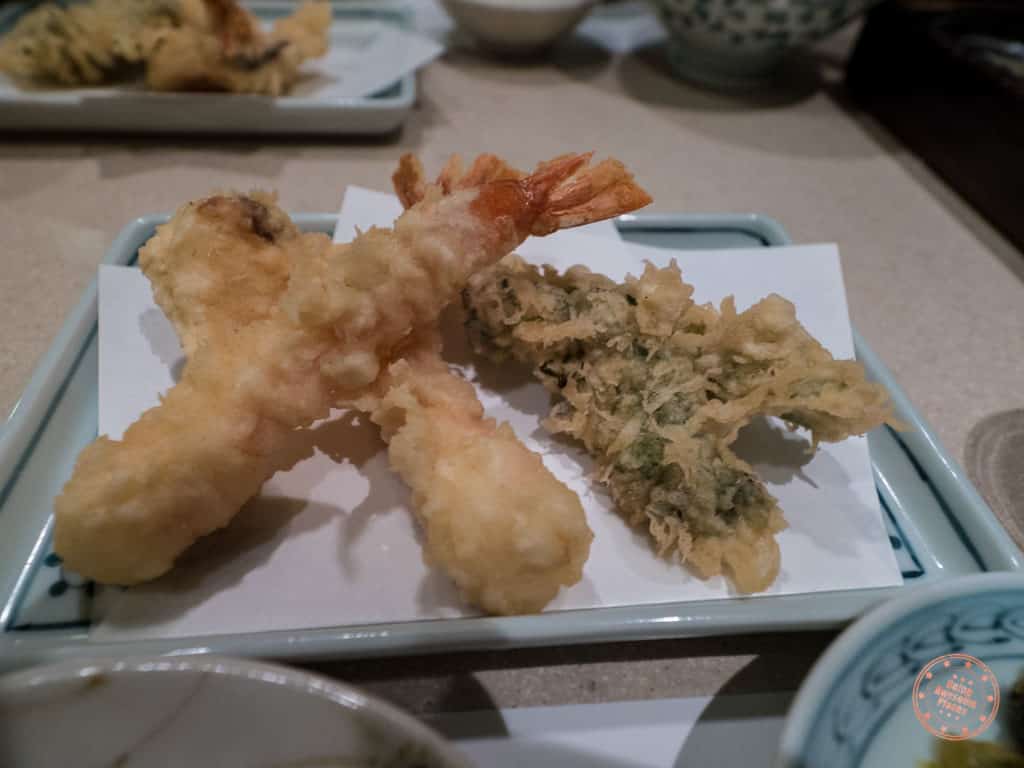
Battered and fried seafood, meats, and vegetables is a mainstay of Japanese cuisine but did you know that it was introduced by Portuguese merchants in the 16th and 17th century? Battered fried food wasn’t a thing until that point in time. Just one of the few things we learned during our walking food tour .
Just like every other type of food in Japan, there’s always the pursuit for perfection and that’s how I discovered this high-end yet affordable tempura experience. Founded in 1923, Tempura Tsunahachi built its reputation on using the freshest ingredients and highest quality tempura in Tokyo. Starting in Shinjuku, they now have a total of 7 locations around Japan. We elected to go to the newer Ginza location.
With a ton of heritage, and frequented by kabuki actors and baseball players over the past century, you’d think things would be ridiculously expensive but for lunch it really isn’t. Showing up at 3:30PM on one of the top food floors of the Matsuya department store, we were seated immediately and found ourselves to be one of the few guests there.
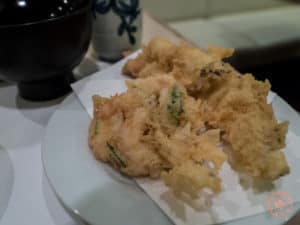
We were presented with English menus but the choices were pretty simple with their lunch set menu that all had a combination of tempura’ed fish, shrimp, vegetables, and kakiage (mixed veggies, onion, and shrimp). I’m sure there was an a-la-carte menu but they didn’t bother showing us as foreigners. We both ordered the 6 piece set, mainly because it was the cheapest option but also the fact that we had sushi only a few hours earlier. We would’ve shared but felt like it would be poor etiquette.
What makes Tsunahachi a must-try is because of how serious they are about their tempura. As each plate comes to the table, you’re amazed at how the batter is cooked just enough to be crispy but at the same time not drenched in oil. It’s a nice light mix that they’ve clearly perfected.
To top that off, we were also given a laminated English sheet on the proper way to have tempura. It’s a multi-step process and you realize you’ve been doing it wrong your entire life. I remember thinking to myself “Wow, so this is how tempura was meant to be eaten!”
This was certainly one of our more expensive meals in Tokyo but definitely the best tempura we had on our trip.

Neighbourhood: Ginza Open hours : 11AM – 10PM daily Address : ( See map ) Price : Tempura-zen set menu (2,160 JPY – $20 USD) English menu?: Yes
7. Tokyo Station Ramen Street – Rokurinsha Ramen (六厘舎)
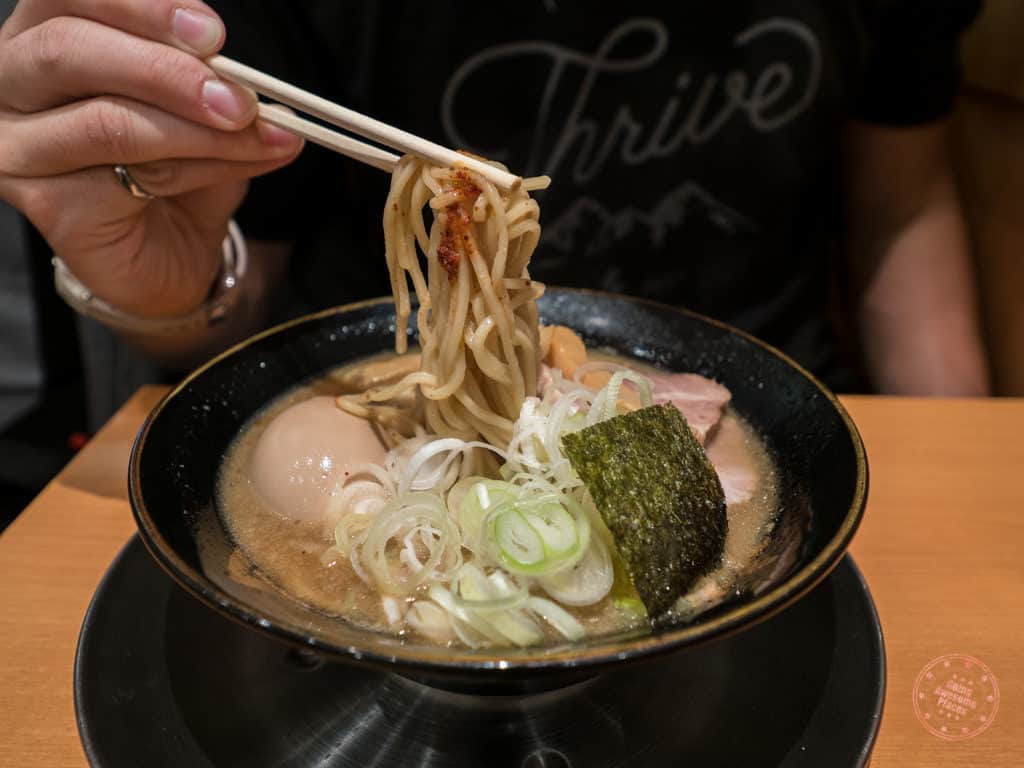
Ramen is kind of an obsession in Tokyo and everyone you talk to will probably have their own take of what is “the best”. Confused by all the choice, I figured it would be easier to go somewhere that had several options to choose from. That’s when I found out about Tokyo Station and their cluster of ramen shops on what’s affectionately called Ramen Street.
The history behind it is that when they built the basement level, they took 8 of the best and most famous Japanese ramen shops from around the country and asked them to open up shop on the street.
We went there not knowing where we’d be eating but of course we got suckered into the one that had a line. After all, Japanese queues are always means that it’s something that’s worth waiting for right? This ended up being Rokurinsha which is right at the main corner of Ramen Street.
We made it right before the off-work rush hour at 4PM and got seated after waiting in line for 20 minutes. We ordered the Special Ramen and Special Dip Noodle as we waited in line as instructed by the waiter directing traffic.
Rokurinsha is known for a type of ramen called Tsukemen style where soup and noodle are separated and the broth is much more rich and the noodles thicker. This is what they call “Special Dip Noodle” in English. Usually we’re pretty open to trying new types of food but the Tsukemen style wasn’t one for us. We found the broth too rich and a little too overpowering in fishiness. This is thanks to the addition of gyofun (dry fish powder). It almost tasted like canned tuna. Sad to say, we didn’t finish the bowl but we did notice that when you’re done your noodles they basically dilute the broth so you can drink it like a soup.
My special ramen on the other hand was fabulous and more of the traditional style of ramen that we’re used to. I found the broth to be just the right level of thickness and oiliness. The egg was done brilliantly with the golden yolk that’s on the edge of being fully cooked through. The slices of pork were generous and the scallions alongside bamboo shoots the perfect combination.
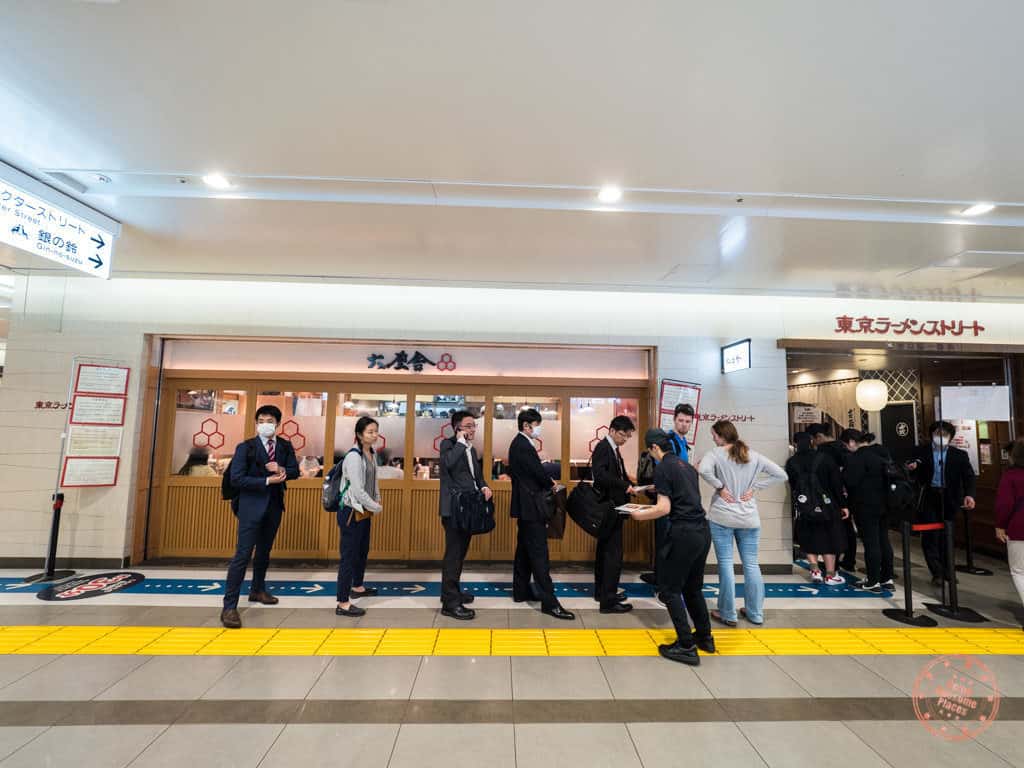
You have to use a machine to order and pay at the vending machine. What’s a little counter-intuitive is that you have to put money into the machine first before pressing the buttons for your order. The ticket that gets printed is what you hand the server when you get your seat.
Neighbourhood: Tokyo Station/Imperial Palace Open hours : 11AM – 10PM daily Address : ( See map ) Price : Special Ramen (900 JPY – $8 USD) and Special Dip Noodle (1,060 JPY – $10 USD) English menu?: Yes
8. Memory Lane – Piss Alley (Omoide Yokocho – 思い出横丁)
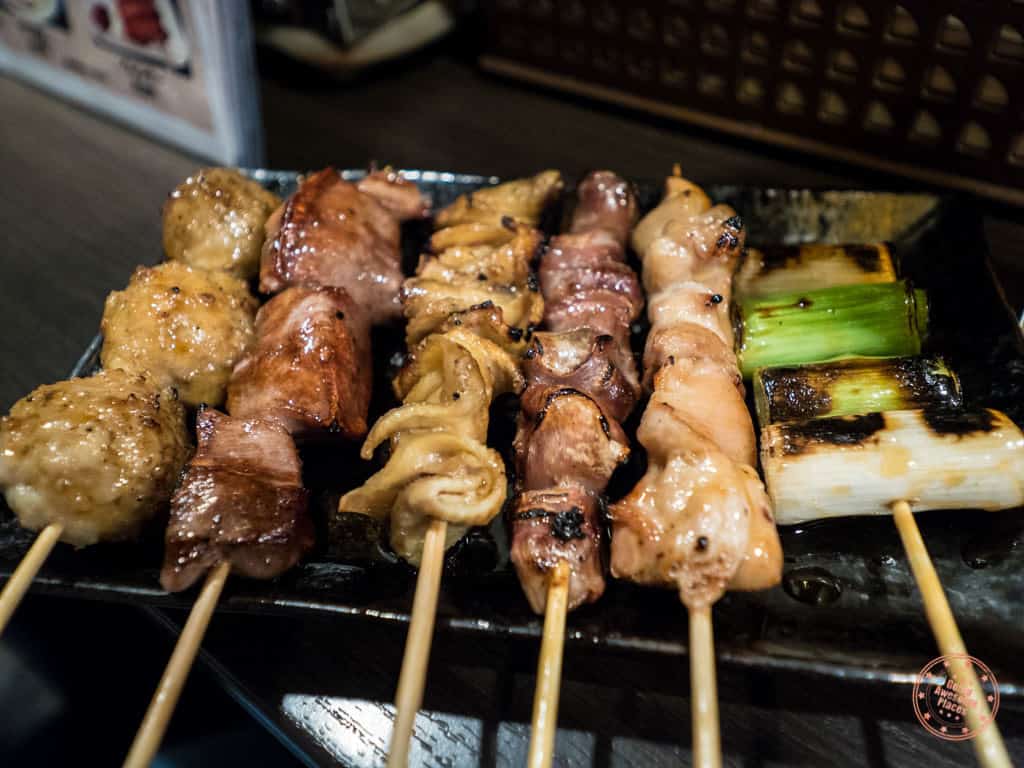
There’s a narrow alleyway next to the bustling Shinjuku station where lots of izakaya and yakitori are had and also where men often relieve themselves after having too many pints. That is how the name Piss Alley was born. Luckily, times have changed and there’s not so much of the namesake happening anymore but it is still a regular place for after work celebrations to happen.
This long alley called Memory Lane is flanked by tiny stalls on both sides where everyone huddles around the bar on tiny stools while the owners grill up skewers. As you walk from one end to the other, everything from the sounds, smells, and visuals are amplified.
There are a ton of restaurants to choose from and from my observation, you really can’t go wrong with any. All of them are as full of character as the next and equally as tight quartered. You kind of just need to pick and see which ones have seats available.
We ended up at one of the bars near the front and ordered 6 skewers and a glass of local beer to wash it down. The seats were barely big enough for my butt but luckily we weren’t shoulder to shoulder with the other people eating there. The skewers themselves were pretty good but definitely not quite as good as Yakitori Ton Ton.
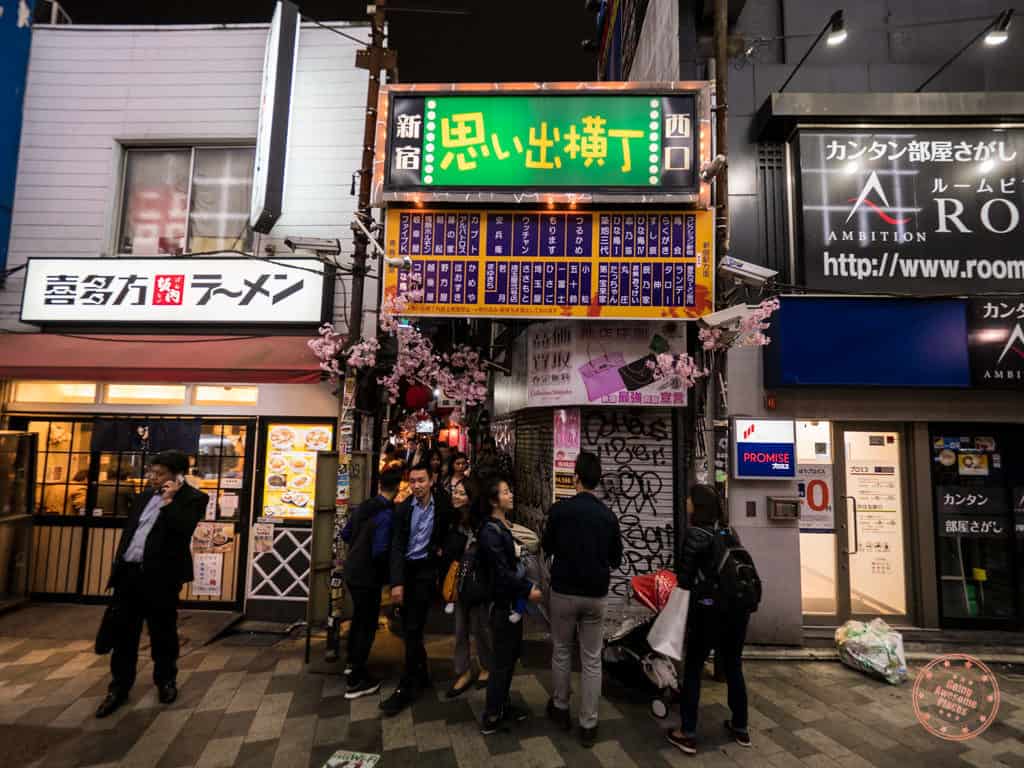
Ordering a minimum of one drink is required.
What turned us off a little was when we got the bill and it was much higher than we expected. Turns out, some of these places automatically charge a “sitting fee”. We later learned that this is to compensate for small spaces and needing to maximize each customer. What they do is sneakily offer you an appetizer which for us was this cold glass noodle similar to Korean jap chae and even if you don’t want it or eat it, it’s 300 JPY on top. That said, it’s one of the few places that we were able to “split” the food so I guess it was fair game.
Neighbourhood: Shinjuku Open hours : Late afternoon and late into the night Address : ( See map ) Price : Assortment of skewers (2,000 JPY – $19 USD) English menu?: Yes
9. Motodane (本種)
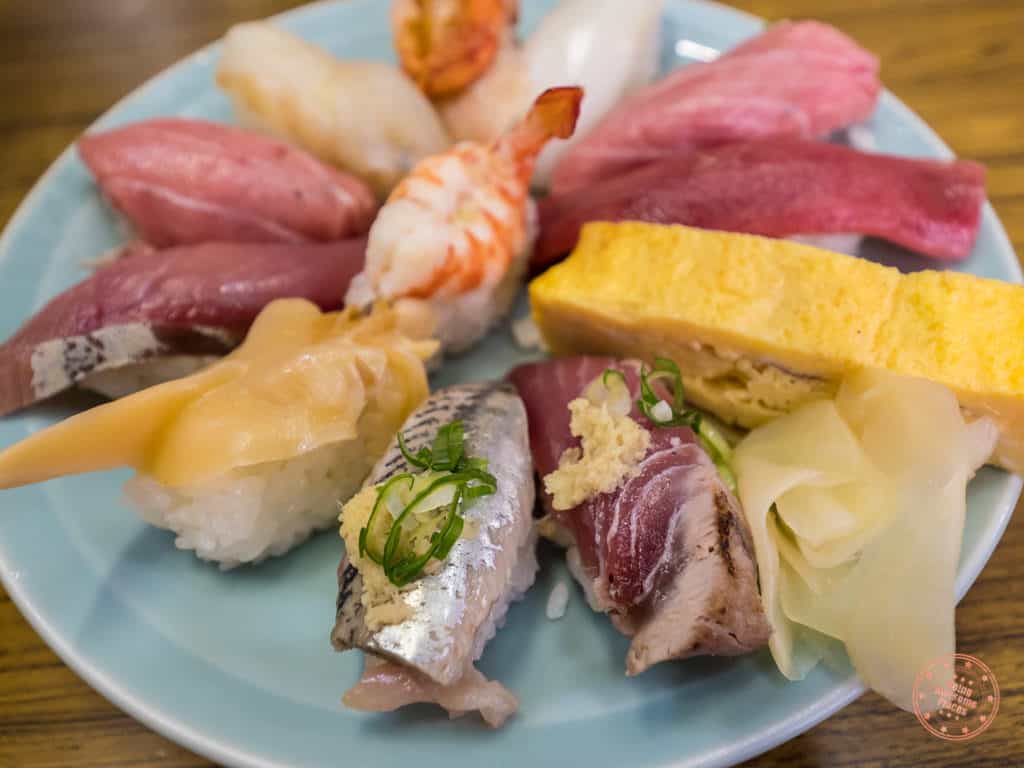
Down a quiet alley on the East end of Tsukiji Fish Market is a sushi restaurant that is so easy to miss that we must’ve walked passed it 3 or 4 times before we finally figured out where it was. The street itself looks more for wholesalers than anything but tucked away is an entrance on a side-alley to this wonderfully local sushi spot called Motodane.
For those that are wondering, yes this is still at Tsukiji !
What we loved about this place is that it is hyper local. Business men on lunch and other locals dined either at the bar or in the back where we were and there wasn’t an English character in sight. To order, they pointed to the menu pinned up on the wall and tried to explain what they were. We could pick up nigiri and sashimi so we were able to figure it out. It also helped that they were preparing meals for other tables so they could kind of point to things.
The chef’s selection of nigiri and sashimi that we ordered was mouthwateringly fresh and the perfect breakfast paired with the miso soup that came with each plate. The only thing missing was uni.
The one knock I had on the place was that the mackerel we had was laced with bones in it which we thought was a bit odd. So sure the experience could’ve been more refined in terms of better slices and selection of fish but for half the price of Nakaya, who were we to complain.
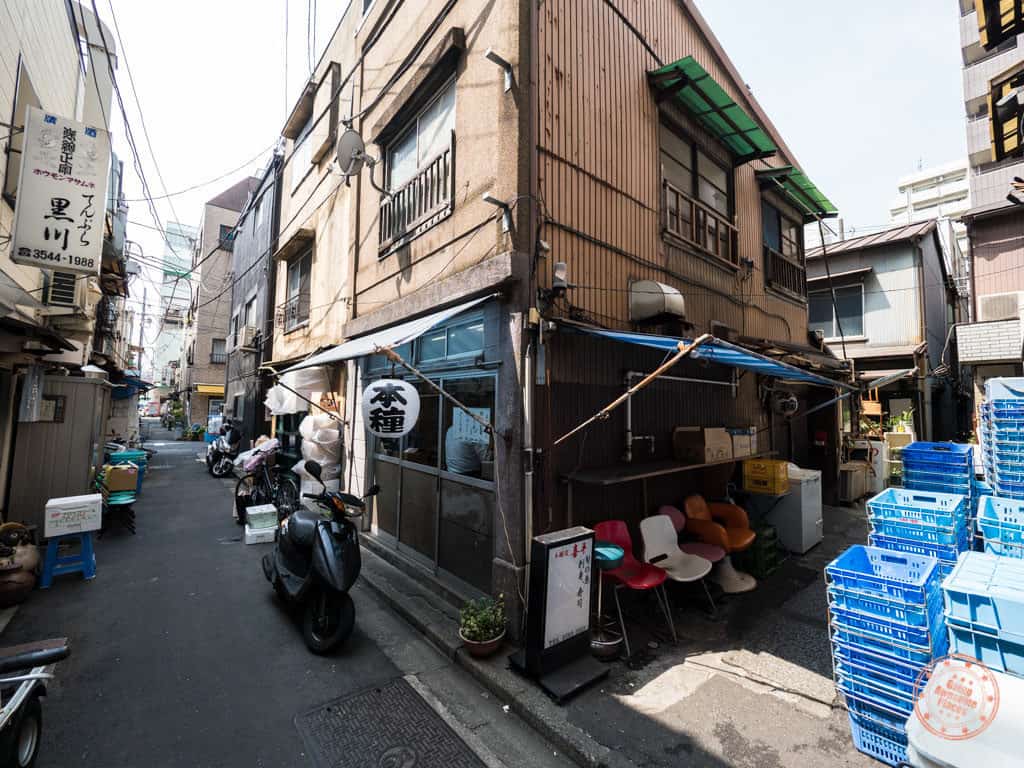
Neighbourhood: Tsukiji Open hours : Late afternoon and late into the night Address : ( See map ) Price : Sashimi plate (1,200 JPY – $11 USD) and nigiri plate (1,500 JPY – $14 USD) English menu?: No
Top 5 Dessert Spots in Tokyo
You know I love my dessert too much to not share with you a few of my favourites. It was so easy to find people’s lists of favourite Japanese restaurants in Tokyo but what about the sweet stuff?
1. Flipper’s (代官山店)
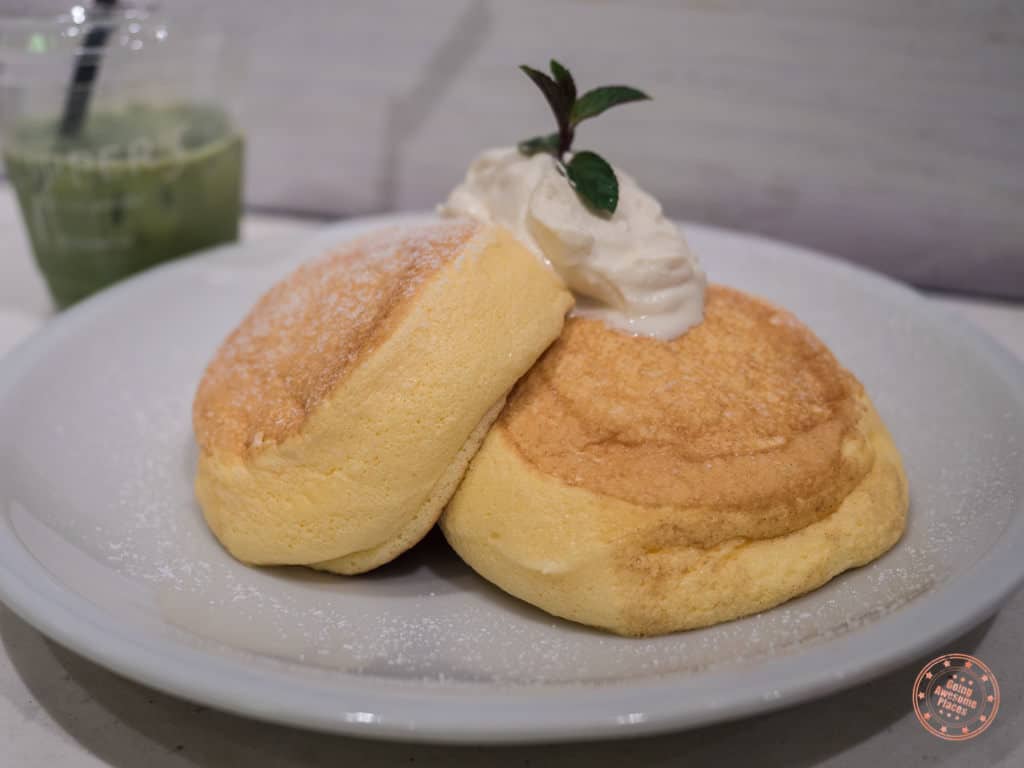
Pancakes are the champions of American Breakfast. In fact, there’s an international house of them. Soufflé is the French art of heavenly light and puffy cakes made with egg yolks and beaten egg whites. What happens when you mix them together in Japan? You get Flipper’s and an all out new sensation called soufflé pancakes.
Topped with special maple butter cream, these super fluffy and melt-in-your-mouth desserts blew my expectations for what a pancake could be. The choices are pretty simple – you can either get them with fruit toppings or without. You’re going to love these airy and delicate creations.
Lucky for us we didn’t have to deal with any mind boggling queues but did have to wait in line for roughly 20 minutes before getting into their Ebisu location. Luckily they had chairs and like all the restaurants that had a queue, they took our orders ahead of time.
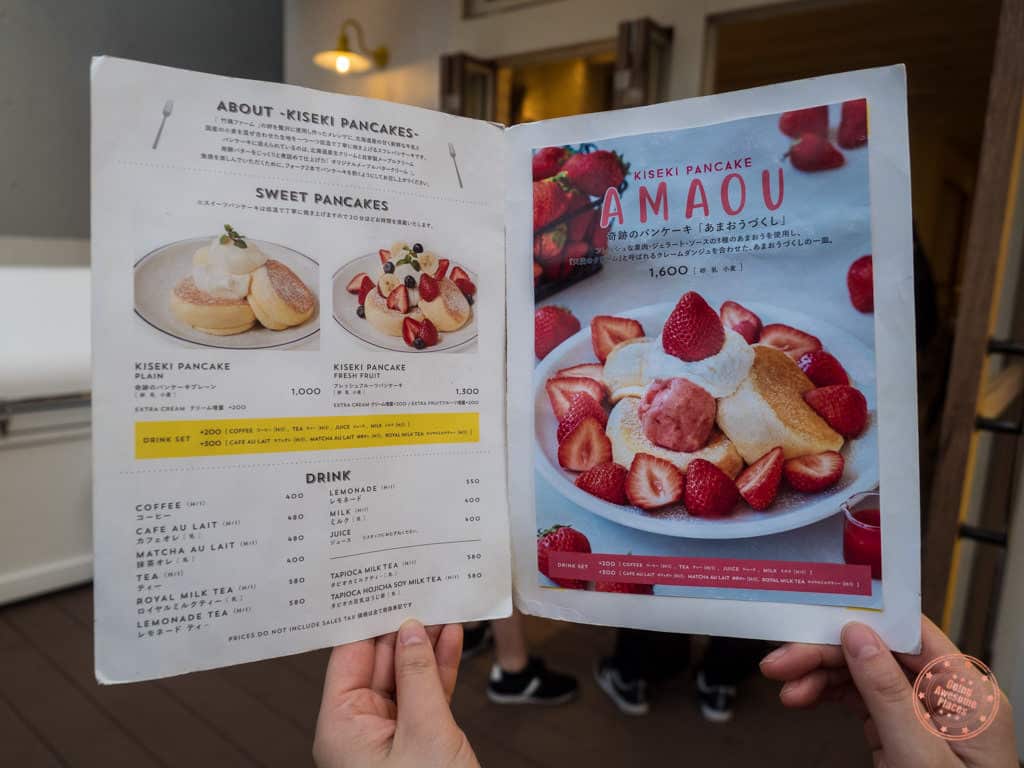
This was one of the few places where we could share a dish but they did make us order a drink.
Neighbourhood: Ebisu Open hours : 11AM – 8PM M-Su Address : ( See map ) Price : Original soufflé pancake a.k.a. kiseki pancake plain (1,000 JPY – $9 USD) + matcha au lait (400 JPY – $4 USD) English menu?: Yes
2. Zaku Zaku (ザクザク)

A trip to Tokyo wouldn’t be complete without a visit to character-filled Harajuku. Besides cosplay shops, vintage clothing stores, and colourful street art, you’ll also find a few my favourite dessert spots in the city.
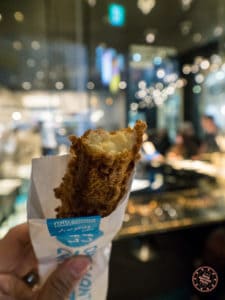
Zaku Zaku was introduced by a friend and they specialize in a unique take on the traditional cream puff that places like Beard Papa’s have been doing for a long time. What they make is something called a croquant chou which are French words for ‘crisp’ and the pastry used for cream puffs and eclairs. Zaku Zaku directly translates to crunchy.
Touting fresh ingredients from Hokkaido, this mashup of cream puffs and eclairs are made of almonds coated with sugar and egg white as well as a blend of Hokkaido-made flour with the cream centres made of milk. They’re all made in-house as they proudly display.
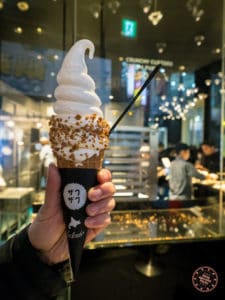
On top of the croquant chou, there’s also their soft-serve which is crowned by crunchy almond at the cone.
One thing you quickly learn in Japan that any dairy product branded as Hokkaido is instantly premium and for good reason because of the simple reason of how legendary their cows are treated which results in creamy and light milk. That said, I was surprised to see that everything was quite affordable here as I was definitely tempted to order more than one crispy cream puff.
Eating the croquant chou right away, I quite enjoyed mine. I think it’s much friendly form to eat compared to the traditional ball of a cream puff that always explodes as you eat it. The crisp is a nice element to it as it is complementary to the soft-serve which was very good. I can’t say it’s going to blow you away but definitely unique and will satisfy your sweet tooth.
There are several locations around Tokyo so make sure you to check to see if there are ones that are more convenient to you.
We showed up at 8PM on a weekday and there wasn’t much of a line. Even if there is one, it moves very swift as it’s very much a pay-and-go system.
When you’re done, think about booking a tour to learn more about the neighbourhood here with the Harajuku Kawaii Fashion & Pop-culture Tour where you’ll learn from a local guide what makes the pop culture here so unique. You’ll be able to have lunch in a crazy monster café and also walk through the nearby Meiji Shrine.
Neighbourhood: Harajuku Open hours : 10AM – 8PM M-Su Address : ( See map ) Price : Original soufflé pancake a.k.a. kiseki pancake plain (1,000 JPY – $9 USD) + matcha au lait (400 JPY – $4 USD) English menu?: Yes
3. Tsujiri (辻利)
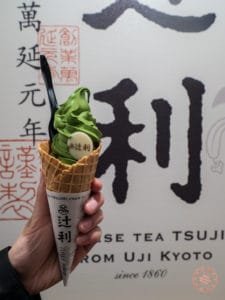
If there’s a #2 behind sushi when you think of Japanese food, I would put green tea in that spot. The most famous matcha comes from a region in Kyoto called Uji but if you’re limited to Tokyo, there are very few options for authentic and high quality tea. We were on the hunt for serious matcha ice cream and that’s when we stumbled upon Tsujiri.
Diving down to the basement floor of the newest department store in Ginza, you’ll be sounding out “ooh” and “ahh” at every turn. This is where you’ll find the highly respected tea shop. At first, we weren’t too interested as we only saw a loose leaf tea on display but we noticed a group of people intensely focused on a cone of matcha soft-serve on the benches.

On the menu is an assortment of matcha soft-serve based items but we were definitely most interested in having it in it’s purest form. They offer two types of soft-serve – the cheaper regular Matcha and the more expensive Extra Rich which is described to have “twice as much matcha as Matcha”.
Of course we went with Extra Rich and boy were we impressed. The soft-serve is smooth and creamy while packing extra strong Uji matcha flavours that is strongly but satisfyingly bitter.
The price between cone and cup are the same so why not go for the cone?
Neighbourhood: Ginza Open hours : 10:30AM – 8:30PM M-Su Address : ( See map ) Price : Extra rich matcha soft serve (584 JPY – $6 USD) English menu?: Yes
4. Angels Heart
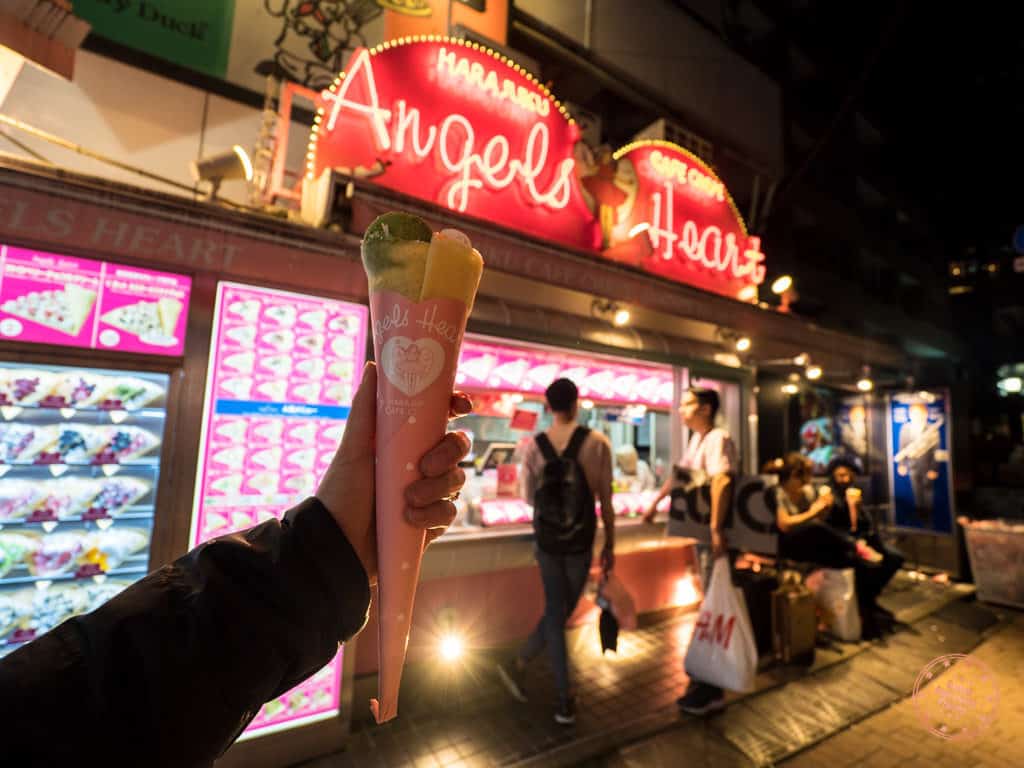
And you thought I was done with Harajuku! We discovered this on our first trip to Tokyo and it certainly wouldn’t be our last. Paired up with Zaku Zaku, we needed to make sure we had enough stomach room for one more dessert.
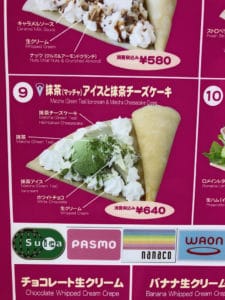
Long before croquant chou was even a thing, Harajuku was mainly known for their decadent crepes. It wasn’t enough just to just put Nutella and fruit on crepes as the French had done but they had to take it a step further and slam it with ice cream and cheesecake on top. It was so deliciously good that it’s a style of crepe in a cardboard cone holder that’s simply called the Harajuku Crepe.
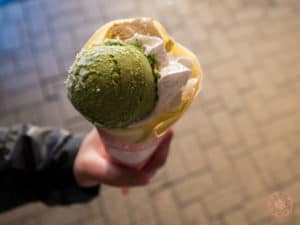
There are several stalls that serve this dessert but the one we always go back to Angel’s Heart which is in the middle of Takeshita Street. The walls are plastered with pictures of menu options and the one I highly recommend is the one with green tea ice cream and cheesecake.
Neighbourhood: Harajuku Open hours : 10AM – 9:30PM M-Su Address : ( See map ) Price : Green tea ice cream and cheesecake crepe (640 JPY – $6 USD) English menu?: Yes
5. Japanese Ice OUCA (食べログ)
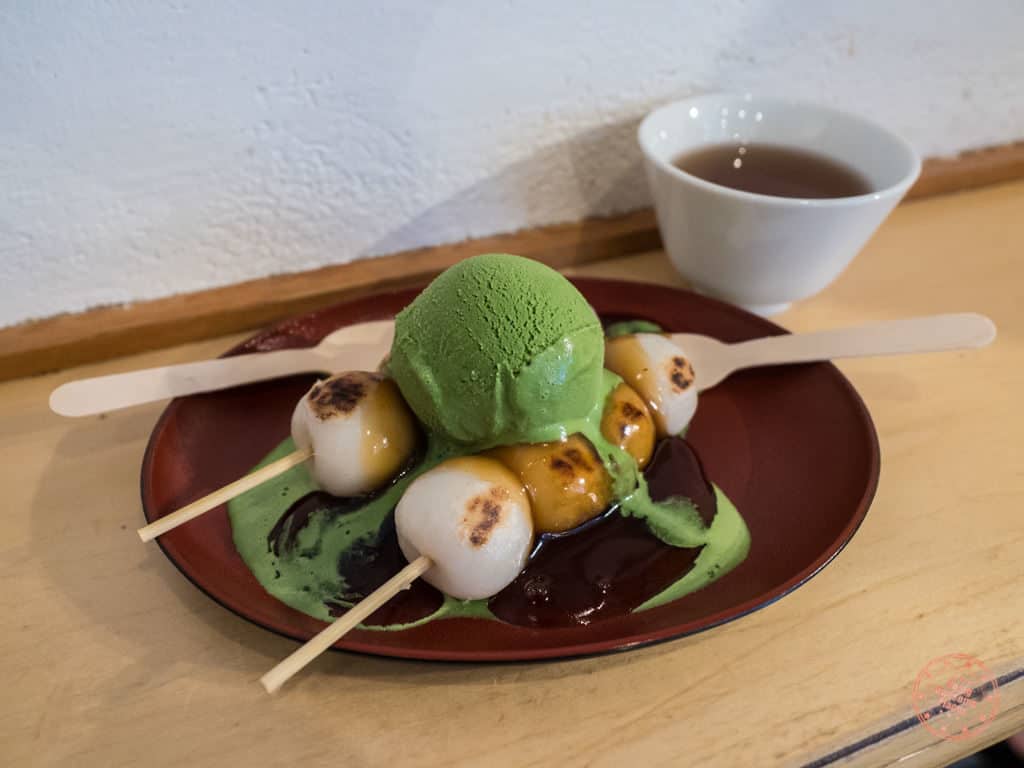
Last but not least is this ice creamery located at a busy intersection in the neighbourhood of Ebisu. In this small cafe, you’ll have your choice of ice cream and gelato – some of which are standard and others which are special based on the season. Everything is homemade.

Overloaded with choices in flavour, colour, and special options, we ended up picking the skewers of mochi (called dango) glazed in a soy syrup with their evergreen matcha gelato on top. An unorthodox combination? Yes, absolutely. I think both of us regretted the choice after as we found the salty-sweet combination of the soy glaze and the bitterness of the matcha to clash. The dango also wasn’t freshly made as we watched them just grill up pre-made ones so it didn’t have the elastic bounce I was expecting.
While the clash was strong, I thought the matcha gelato was excellent. Not as rich as Tsujiri but with a texture that could easily fool you as ice cream, it held up its own as some of the best ice cream we had in Japan.
If I were to come back, I’d stick to the basic cup of 3 selection ice cream.
Wheat green tea is complimentary if you’re eating in their limited-space cafe. Also, if you order one of their ice cream cups, it comes with kombu flakes to cleanse your palette after the sugar overdose.
Neighbourhood: Ebisu Open hours : 11AM – 11PM M-Su Address : ( See map ) Price : Dango with green tea gelato (400 JPY – $4 USD) English menu?: Yes
Places We Missed
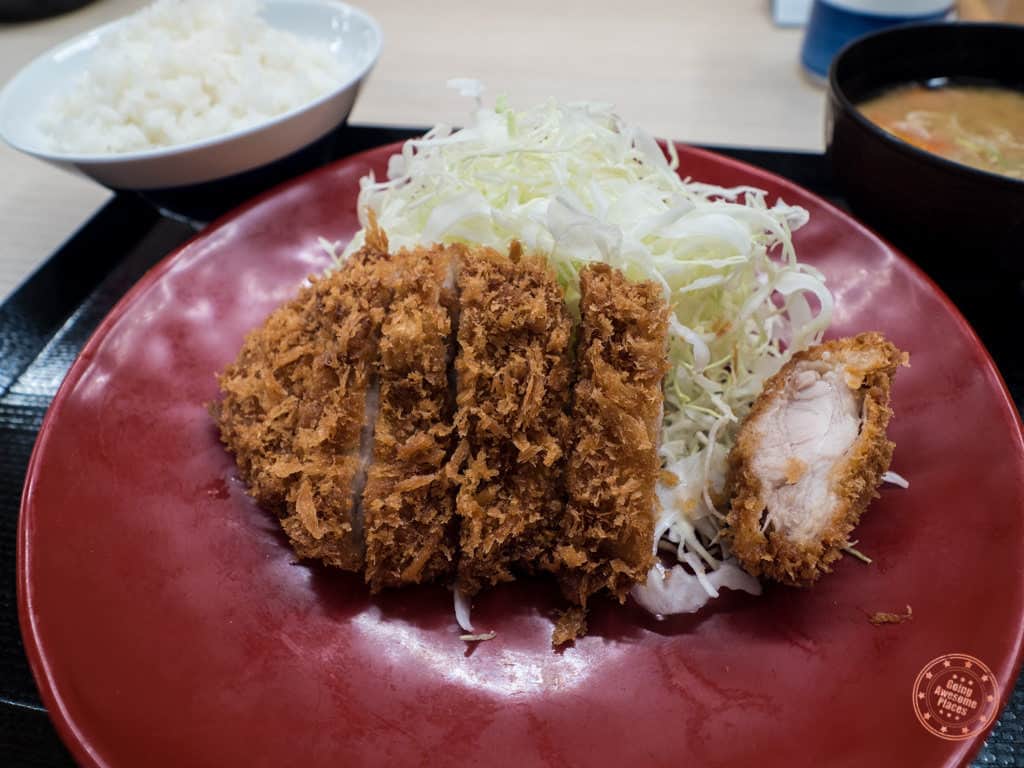
In 6 days I feel like we barely made a dent into everything Tokyo has to offer. As you plan out your foodie vacation, here are some of the other things you don’t want to miss out on.
Types of Food We Didn’t Get To
- Shabu shabu
- Japanese BBQ
- Steak (Waygu and Kobe beef)
More Places I Didn’t Feature
There are more restaurants that I wasn’t able to feature on this list but I did add them to the Tokyo Food Map . These include restaurants that we tried or ones that were in the plans but just didn’t have time or the stomach room for.
How much does 5 days in Tokyo cost?
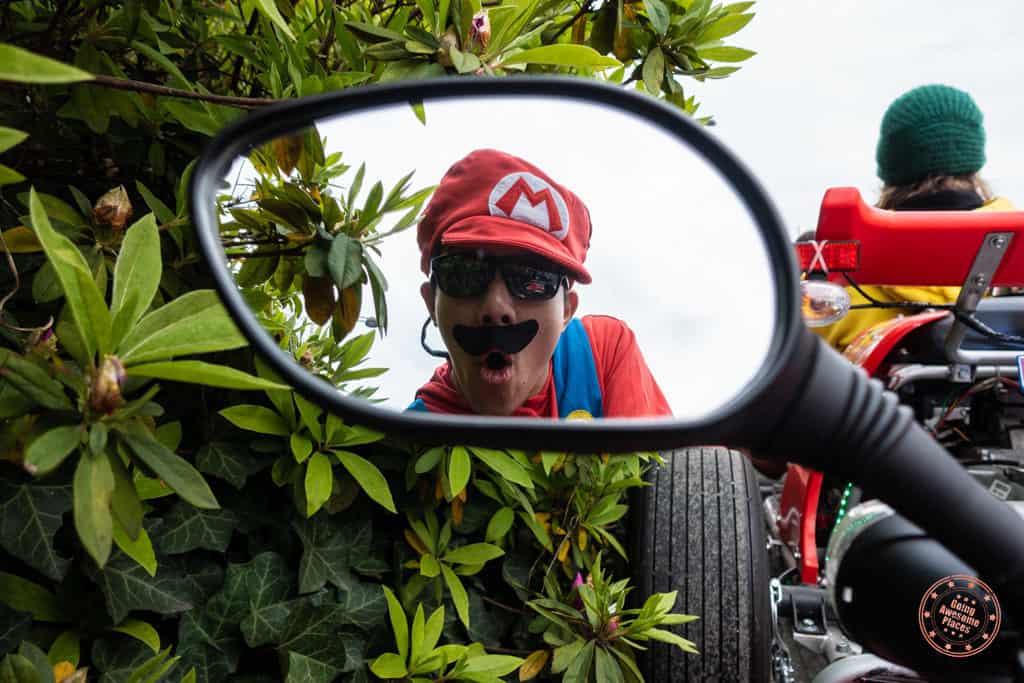
It’s no secret that Tokyo is one of the most expensive places in the world. I kept track of our expenses over the course of our 6 days in the city and here is a breakdown of how much we spent.
- Food : $437 USD
- Souvenirs : $294 USD
- Accommodation : $188 USD (6 nights at the Airbnb)
- Transportation : $99 USD (not including flights)
- Activities: $189 USD (mainly MariCAR)
- Currency: $4 USD (ATM fees)
TOTAL: $1,211 USD
This breaks down to $201 per day and furthermore $100 per day per person .
Food of course is where we spent the most money but from my list above, you’ll see we didn’t really splurge on any particular place which helped keep our cost low. We definitely ended up spending a bit more on souvenirs which can be broken down into our shopping at Daiso, Don Quijote, and the local supermarkets.
We saved a ton by going cheap on accommodations but that can easily balloon to $1,000 in Tokyo if you’re staying in the city .
There’s an endless amount of things to see, do, and eat in Tokyo. Our 6 days there was a blitz of food that resulted in intense exercise of our stomachs and our feet.
One thing is for sure, it did not disappointed. The most impressive thing is just how much care they put into every piece of food that is placed on the dish. Everything is there for a reason and it’s the combination of all the freshest ingredients and method of preparation that results in incredible dining experiences whether they’re on the street or in a fancy restaurant.
So what are you waiting for?
Looking for activity ideas in Tokyo?
Akihabara Anime & Gaming Adventure Tour – Akihabara is an awesome neighbourhood to explore that isn’t covered in this particular guide as somewhere with a specific restaurant to visit but if you’re a fan of anime, manga, maids, video games, and toys. This tour gives you a 3 hour interactive experience including going to a maid cafe, trying out a Japanese photo booth, and being shown the best spots for anime.
Read these next!
- Souvenirs you have to buy before you leave Japan
- Best ramen in Tokyo
- Must have food in Osaka
- Tips for getting around Tokyo by train
- Best ryokans in Kyoto
Thinking about a JR Pass?

If you’re looking to do any travelling around Japan, I highly recommend picking up a JRailPass . Keep in mind that you’ll need to purchase it before your trip and ship it to your home.
About William Tang
William Tang is the Chief of Awesome behind the award-winning Going Awesome Places which is focused on outdoor adventure, and experiential travel. His true passion lies in telling stories, inspiring photography and videos, and writing detailed itineraries and travel guides. He is a member of Travel Media Association of Canada (TMAC), Society of American Travel Writers (SATW), Adventure Travel Trade Association (ATTA), and Travel Massive. He has also been featured in publications such as Reader's Digest, Entrepreneur, Men's Journal, and Haute Living. Make sure to learn more about William Tang to find out his story and how Going Awesome Places started.
Find us on social media
- Skip to main content

Food Tours Japan
Eat, Drink & Cook in Japan
Discover Japan’s best gourmet travel experiences
Get free updates no charge. no spam. only love., main content.

Tokyo Food Tours: 12 Best Gourmet Travel Experiences

Kyoto Food Tours: 9 Best Gourmet Travel Experiences

15 Best Osaka Food Tours [2024 Update]
Food Tours Japan helps you discover the best gourmet experiences in Japan, the world’s number one food destination. Pack your chopsticks, and dive into elegant and harmonious cuisines developed from centuries of artistry, to deliciously addictive soul foods.
Start your journey in Tokyo, the world’s premier city for food-lovers with the most Michelin-starred restaurants. Savour the best of Japan’s cuisine and local delicacies on a Tokyo food tour .
Stroll around Shinjuku’s narrow back streets and taste sizzling yakitori in Memory Lane, or discover where the locals go out at night. Fun-seekers will love the Robot Restaurant’s sensory overload of action and lights, which is more cabaret show, than a place for serious foodies. Or, combine sightseeing with a culinary experience during the day.
Tantalise your taste buds with fresh-off-the-boat sashimi at Tsukiji Market and witness the drama of Tokyo’s famous tuna auction at its new home, Toyosu Market . After all that delicious sushi, wash it down with a sake tasting or brewery tour .
For a more hands-on culinary experience, learn how to cook ramen and gyoza, wagyu beef and more at a Tokyo cooking class .
Ranked number two in the world for the most Michelin star restaurants, Kyoto is home to some of Japan’s most refined dishes. On a Kyoto food tour , experience the finest kaiseki multi-course meal and discover restaurants and bars in Kyoto’s geisha districts, Gion and Pontocho.
But don’t leave spotting a geisha to chance! For a once-in-a-lifetime experience, enjoy the company of Kyoto’s elegant and legendary entertainers at a geisha and maiko dinner show .
Or, take a break from shrines and temples with a sake brewery and tasting excursion in Kyoto’s quaint and pretty Fushimi district.
Osaka is a foodie paradise, and its people are famous throughout Japan for their love of food. They’re so passionate about cuisine, they have a saying kuidaore which means to ‘bankrupt oneself through extravagance with food.’
Osaka’s friendly and outgoing locals makes it a perfect place to experience delicious local soul foods like takoyaki and Japanese cuisine.
Take a food tour in Osaka and wander around Dotonbori’s neon-lit streets tasting food as you go at one of the many izakaya or standing bars. Or, why not visit Kuromon Market with its seafood-laden food stalls.
Taste the beauty of Japan on a culinary adventure and get a deeper insight into the nation’s culture. A Japan food tour is a must-do travel experience and one you’ll never forget!
Image: Sushi!!! / 鮨 by Toshihiro Gamo , used under CC BY-NC 2.0 DEED / Edited from original
Tokyo Food Guide
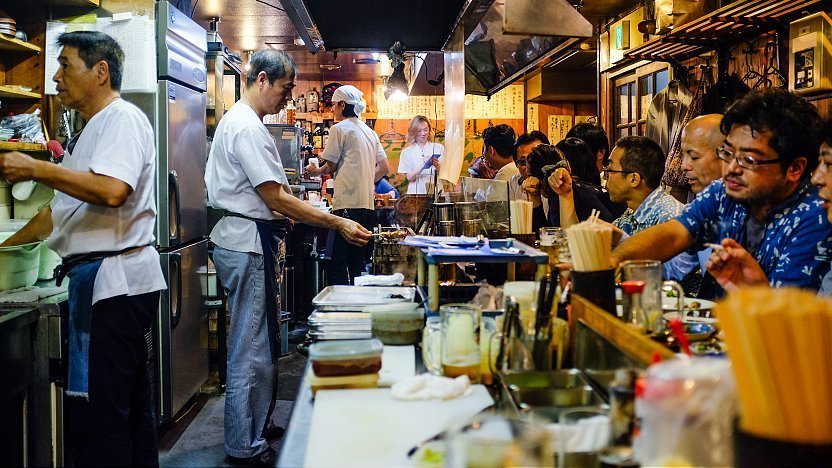
Tokyo is one of the world's most exciting dining destinations. The city features a wide range of both local and regional Japanese cuisine in addition to all types of international fare. Its top restaurants have accrued more Michelin stars than both Paris and New York combined. But good food can be found at every price range from cheap hole-in-the-wall joints to expensive high-class restaurants with every budget in between.
Tokyo specialties
As Japan's political center for over four centuries, Tokyo has naturally exerted great influence on Japanese cuisine . Consequently, some Tokyo specialties have become so popular that they are now known as the standard version of the dish rather than a local specialty. Local creations from Tokyo (formerly called Edo) are often referred to as "Edo-mae", literally meaning "in front of Edo", in reference to Edo Bay (now Tokyo Bay) which provided the city with its local seafood. The following are some popular Tokyo specialties:
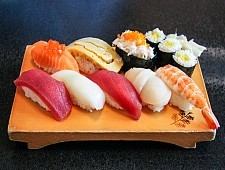
Regional specialties from across Japan
Tokyo is also a good place to enjoy regional Japanese foods from across the country, which have been available in Tokyo since the Edo Period when the regional lords (daimyo) from across Japan were forced to maintain large villas in the capital and spend alternate years there. A by-product of this policy to keep the regional lords under the shogun's control was the influx of various regional cooking styles into the capital.
These days, foods from across the country can be found at many restaurants specialized in regional cuisines. Some of the most popular regional foods that can be sampled around Tokyo come from Okinawa , Kagoshima , Fukuoka , Kyoto and Hokkaido . In addition, successful restaurants from across Japan often open outlets in Tokyo in an effort to branch out and make a name for themselves.

International dining
International food is enjoying great popularity in Tokyo, and many Japanese chefs have achieved recognition for their skills in foreign cooking, often acquired by practical training overseas. Furthermore, Tokyo is home to various international communities, which have brought a variety of different cuisines with them.
While popular foods such as Chinese, Indian, Italian, French and Korean can be found virtually anywhere in the city, there are also a few districts serving less prominent international cuisines especially around the embassies located in the Azabu, Hiroo and Roppongi districts. Below are a few of the more concentrated international districts:
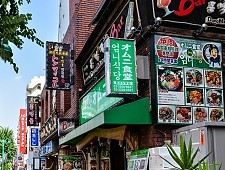
Casual dining
There are lots and lots of casual dining restaurants of all types found across Tokyo. While restaurants are easy to find just about anywhere in the city, good places to go for a large variety of them are around train stations, entertainment districts and the restaurant floors of most department stores , where there is usually a good selection of restaurants ranging from Japanese cuisine to international dining.
Izakaya are the most common type of casual dining establishments and are good places to try a variety of dishes. They can be found in droves around train stations and entertainment districts and serve popular food items such as yakitori , sashimi and of course beer . The following are a few casual dining areas around Tokyo that are well known for their atmosphere:
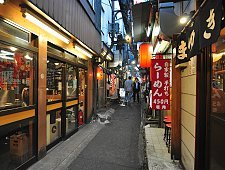
Fine dining
Tokyo is well known for its fine dining and has the highest number of Michelin-starred restaurants of any city in the world. Fine dining restaurants are often found on the top floors of skyscrapers and major hotels , and the cuisine served at these restaurants ranges from traditional Japanese to international and fusion fare. Of course, they tend to be priced accordingly, and some restaurants may require advance reservations. The following are a few districts that are known for their fine dining establishments.
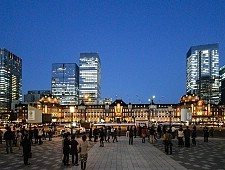
Themed dining
Themed cafes such as maid and butler cafes, as well as pet cafes are popular attractions where you can converse or play games with a maid or butler, or spend time with animals such as cats, rabbits or birds while eating light meals or enjoying a coffee or tea. Maid cafes can easily be found in Akihabara whereas butler cafes are more concentrated around Ikebukuro . Pet cafes can be found in small numbers around the city. All these types of cafes usually charge a small cover charge in addition to food and drinks.
Another type of themed dining are food theme parks which typically feature different variations of a specific food such as ramen or gyoza . Despite the name, food theme parks are usually indoors and work similarly to a food court except that all the vendors are selling variations and regional types of the same dish. Some food theme parks around Tokyo include the Namja Gyoza Stadium in Ikebukuro and a ramen theme park in Aquacity on Odaiba .
Those looking for a quirky and entertaining meal, themed restaurants like the Ninja Restaurant can be a fun and appealing attraction. Themed restaurants are decorated similarly to amusement parks, have themed menus and staff dressed in costume. The food usually follows the overall theme, and there may be some type of performance during the meal.
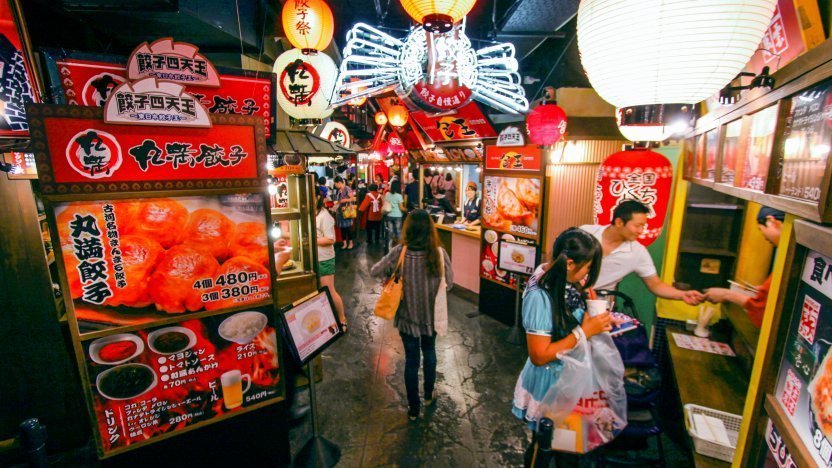
Japanese-style breakfast
The easiest place to try a Japanese-style breakfast are hotels , many of which offer Japanese breakfast set meals or buffets with both Japanese and Western dishes. Otherwise a Japanese-style breakfast is difficult to find as most restaurants and coffee shops tend to serve Western-style breakfasts or coffee and toast sets only. One option may be gyudon restaurants which often offer basic Japanese breakfast sets at cheap prices.
For the more adventurous, the sushi restaurants in the Tsukiji Outer Market and at Toyosu Market are open from early morning, offering fresh sushi for breakfast. Note that many of these restaurants close by mid-afternoon.
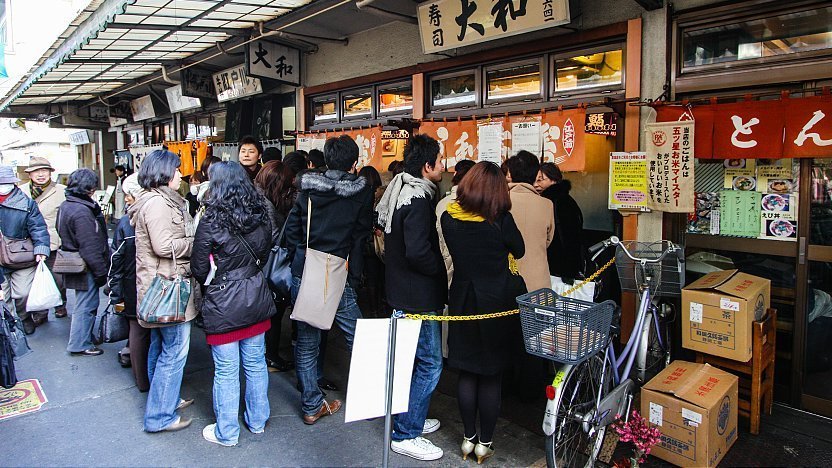
Questions? Ask in our forum .
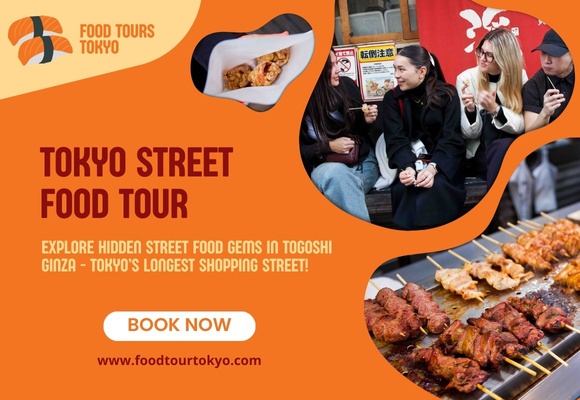
Hotels around Tokyo
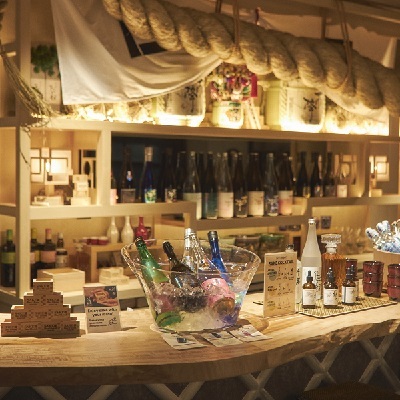
Experiences around Tokyo

More From Forbes
5 must-try tokyo desserts.
- Share to Facebook
- Share to Twitter
- Share to Linkedin
The Capitol Hotel Tokyu’s German apple pancake.
Competition on the Tokyo culinary scene is fierce. Japanese chefs strive to create the most spectacular desserts in every confectionary discipline: puddings, pies, parfaits and pastries. The sweets served in Tokyo’s finest restaurants and patisseries are remarkable in appearance and flavor, making this the ultimate city to indulge your love of the last course.
Here are the top treats from all over Tokyo, each unique to its outlet. Don’t miss the chance to embrace painstakingly prepared delicacies you won’t find anywhere else.
Origami Cafe.
German Apple Pancake, Origami Cafe
One Tokyo classic at Origami Cafe in Forbes Travel Guide Five-Star The Capitol Hotel Tokyu is the German apple pancake. Austrian chef Karl Hohmann introduced the breakfast-for-dessert as an homage to his beloved grandmother. Origami Cafe is chic with modern Japanese décor and a diverse menu, but this particular dish is a distinct part of the hotel’s history.
The large pancake is turned up at the sides to create a bowl shape with crispy edges. The bottom is filled with Japan’s finest apples, usually sourced by the chef from Aomori Prefecture. The pancake shape can accommodate plenty of melted butter and syrup.
The Layered Parfait, Whisk
Best High-Yield Savings Accounts Of 2024
Best 5% interest savings accounts of 2024.
The beautifully arranged layered parfait is a menu staple at Mesm Tokyo’s Whisk. Every season brings a new and original parfait featuring a Japanese flavor made with fresh fruit. Through late June, the Kissaten layered parfait (fresh melon with mascarpone mousse, jelly, crumble, chocolate and cherry confection topped with Chantilly cream) is available.
The refreshing Kissaten parfait contains the nostalgic flavor of the Japanese green melon soda, a favorite soft drink in the country’s traditional kissaten cafés during the spring and summer. Whisk’s parfaits are as delicious as they are Instagrammable; enjoy them with a view of the Hama-Rikyu Gardens and Tokyo Bay.
The classic lemon pie.
Lemon Pie, Orchid
Five-Star The Okura Tokyo’s all-day-dining restaurant, Orchid, is known for its treats made on the premises. The talented pastry chefs conjure up desserts each season, but the famous pies are a fixture. The fresh pies are temptingly displayed on Orchid’s glass counter, just begging to be eaten. Choose from peach, apple or the majestic lemon meringue pie, a highlight of the menu.
Known simply as the lemon pie, this citrusy delicacy has been served at The Okura since the original hotel opened in 1962. The pie is zesty yet sweet; the fresh lemon curd sits on a salty base to balance the sugary meringue topping. It is so flawless that pastry chefs have never altered its form in all these years. Enjoy a slice with ice cream and whipped cream at Orchid or the onsite delicatessen, Chef’s Garden.
The unforgettable strawberry shortcake.
Strawberry Shortcake, Sophie at Edition
The Tokyo Edition, Ginza ’s Sophie at Edition may be a newcomer to the area, but the brasserie has a rapidly growing reputation for its quality, approachable French food and made-in-house desserts like the memorable strawberry shortcake.
The executive chef offers his take on the strawberry shortcake, Japan’s most popular cake. This enormous red-and-white delight, which serves four to six people, is filled with strawberries sourced from all over Japan, according to the season. The fluffy chiffon cake with fresh cream is topped with a gigantic handmade sugared strawberry, which is a work of art. Crack open the big strawberry to find even more fresh berries inside.
Baba à l’Armagnac, Benoit Tokyo
Among Tokyo’s best French restaurants, Benoit puts a unique twist on the traditional rum baba (syrup-covered yeast cakes). The Baba à l’Armagnac is a decadent deconstructed dessert: cake, Chantilly cream and a bit of VSOP Armagnac.
Alain Ducasse decorated his traditional French restaurant with antiques and flea market finds from across France. When you walk up the stairs to the light-filled dining room with lovely wooden furniture, you’ll agree that it’s just the place for this exquisite French dessert.

- Editorial Standards
- Reprints & Permissions
Join The Conversation
One Community. Many Voices. Create a free account to share your thoughts.
Forbes Community Guidelines
Our community is about connecting people through open and thoughtful conversations. We want our readers to share their views and exchange ideas and facts in a safe space.
In order to do so, please follow the posting rules in our site's Terms of Service. We've summarized some of those key rules below. Simply put, keep it civil.
Your post will be rejected if we notice that it seems to contain:
- False or intentionally out-of-context or misleading information
- Insults, profanity, incoherent, obscene or inflammatory language or threats of any kind
- Attacks on the identity of other commenters or the article's author
- Content that otherwise violates our site's terms.
User accounts will be blocked if we notice or believe that users are engaged in:
- Continuous attempts to re-post comments that have been previously moderated/rejected
- Racist, sexist, homophobic or other discriminatory comments
- Attempts or tactics that put the site security at risk
- Actions that otherwise violate our site's terms.
So, how can you be a power user?
- Stay on topic and share your insights
- Feel free to be clear and thoughtful to get your point across
- ‘Like’ or ‘Dislike’ to show your point of view.
- Protect your community.
- Use the report tool to alert us when someone breaks the rules.
Thanks for reading our community guidelines. Please read the full list of posting rules found in our site's Terms of Service.

14 Must-Visit Unique Food Markets Around the World
Posted: June 26, 2024 | Last updated: June 26, 2024

Exploring local food markets is an adventure for your taste buds and a window into the culture of a place. Each market offers unique flavors, vibrant atmospheres, and unforgettable experiences. Here’s a look at some of the most unique food markets you should visit.
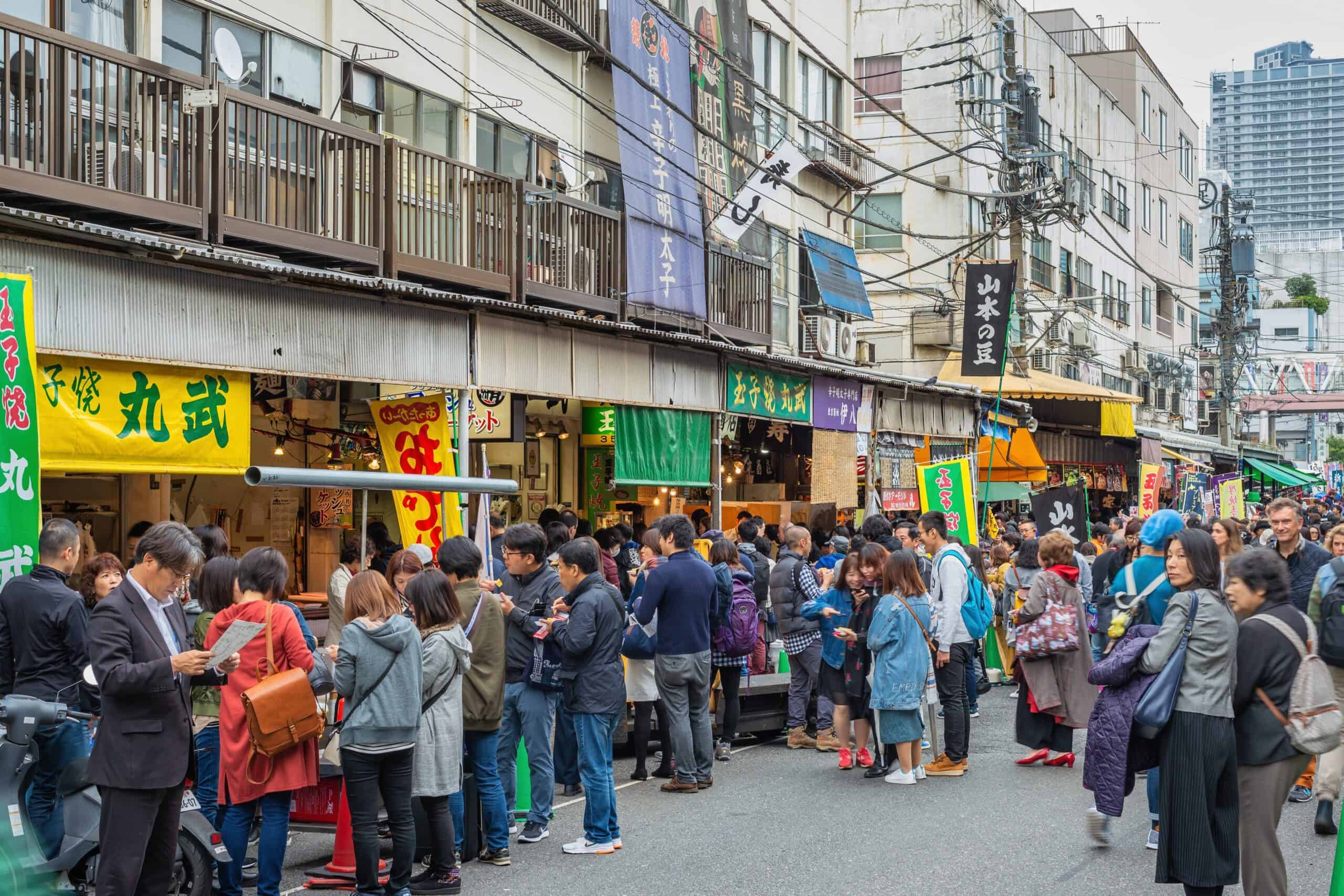
Tsukiji Fish Market, Tokyo, Japan
The Tsukiji Fish Market is world-renowned for its bustling tuna auctions held early in the morning. Fresh seafood is the highlight, offering the chance to sample sushi and sashimi prepared on-site. Arrive by 5 am to catch the lively auctions. Beyond the auctions, explore the outer market for a variety of food stalls and shops. You can find everything from kitchenware to Japanese snacks. Remember to wear comfortable shoes and bring cash, as many vendors donât accept cards.

La Boqueria, Barcelona, Spain
La Boqueria is a feast for the senses, located on La Rambla. It’s famous for its colorful displays of fruits, vegetables, meats, and seafood. Visit in the morning to avoid crowds and get the freshest produce. Enjoy tapas at the market bars or sip on freshly squeezed fruit juices. Donât miss trying traditional Spanish dishes like jamón ibérico and seafood paella. Be cautious with pickpockets in the busy market.
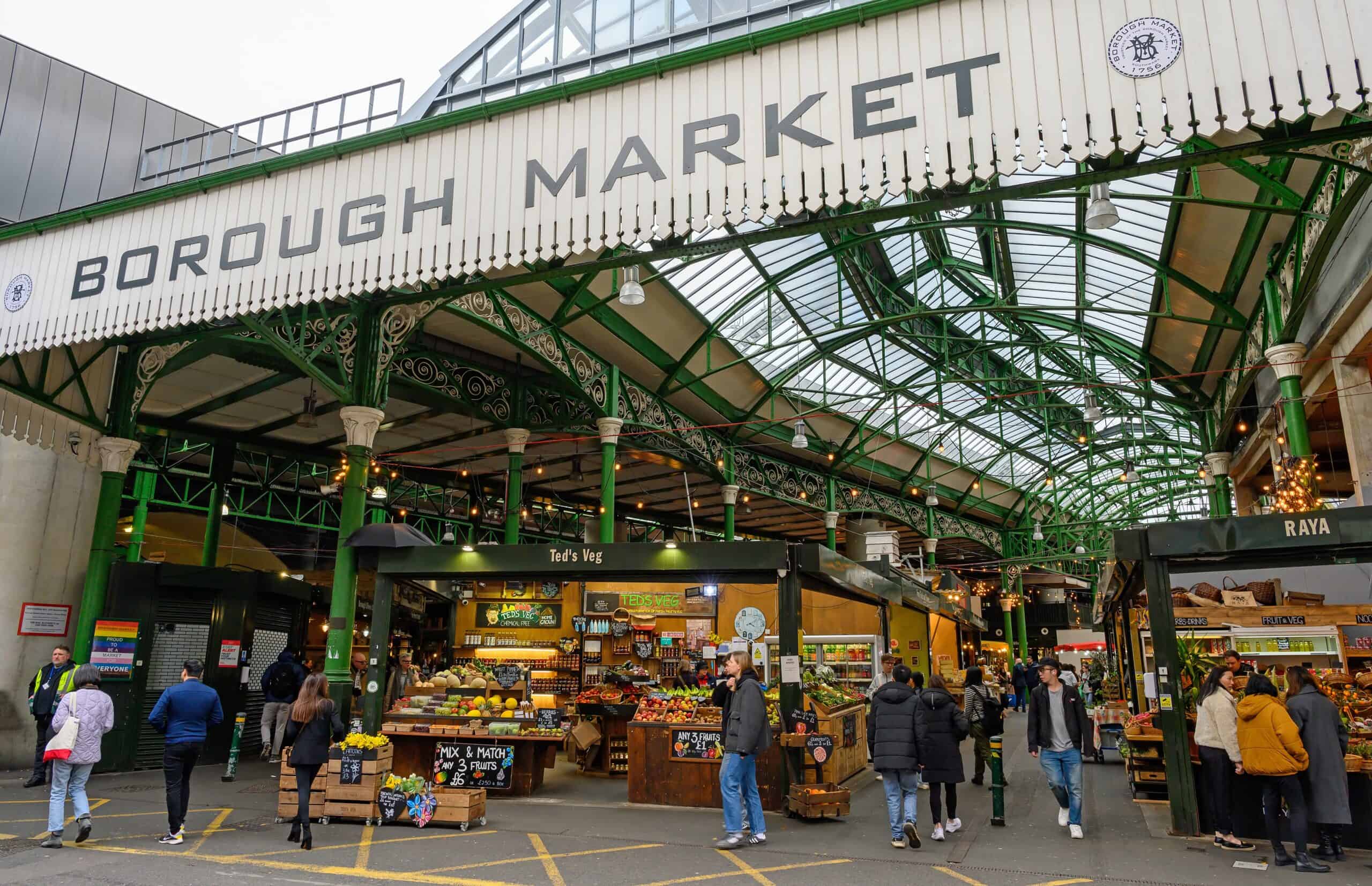
Borough Market, London, England
Borough Market is a paradise for food lovers, offering high-quality produce and artisanal products. Highlights include freshly baked bread, cheeses, and gourmet street food. Visit on a Thursday for a less crowded experience. Indulge in diverse cuisines from the marketâs food stalls, and sample treats like scotch eggs and brownies. The marketâs atmospheric Victorian architecture adds to its charm.
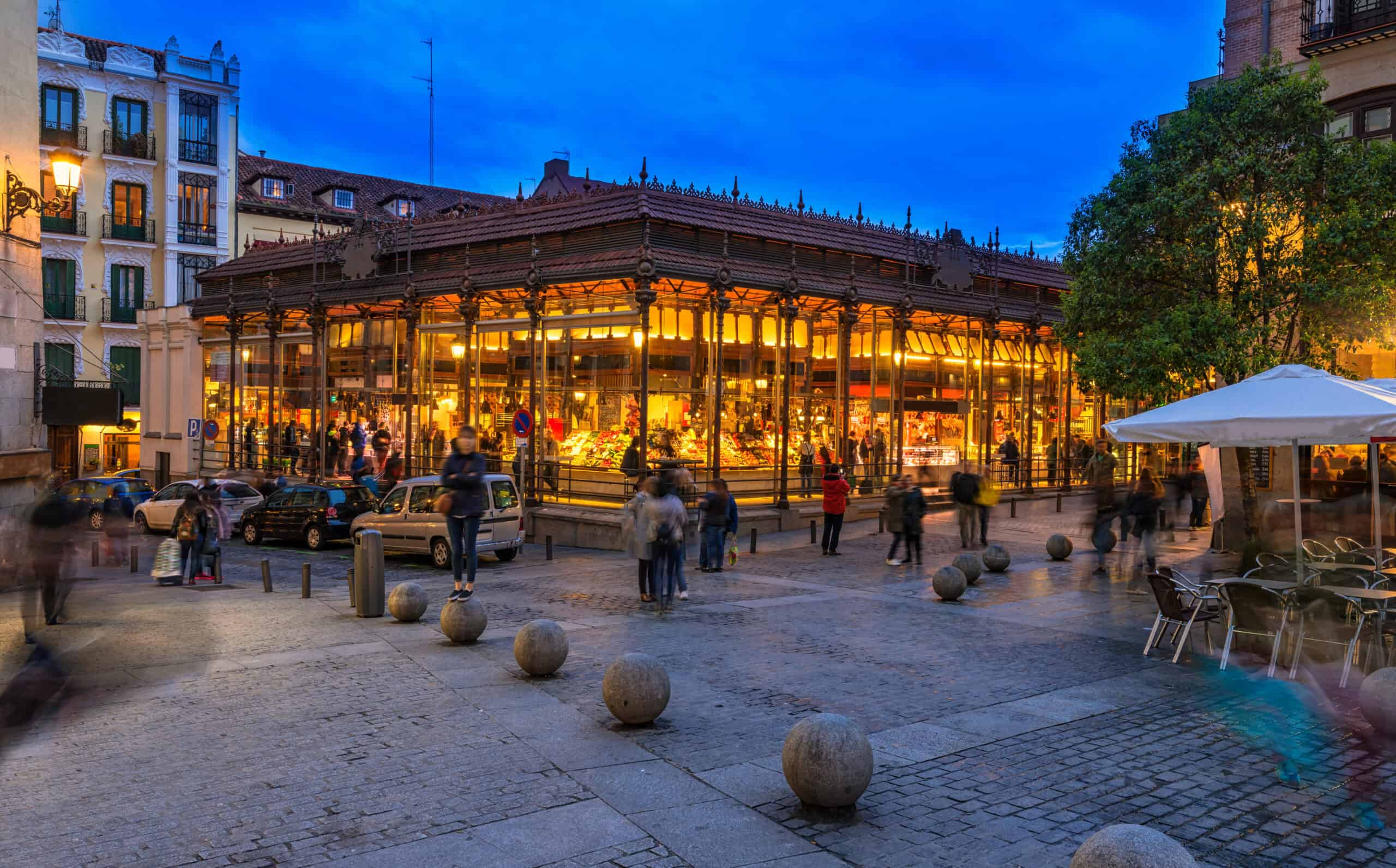
Mercado de San Miguel, Madrid, Spain
Mercado de San Miguel is a historical market turned gourmet food hall. It’s known for its tapas, fresh seafood, and fine wines. The market’s iron architecture adds to its charm. Sample the paella and Iberian ham, and visit in the evenings to avoid the crowds. Late afternoon or evening is the best time to visit. Itâs located near Plaza Mayor, easily accessible by metro (Sol Station).
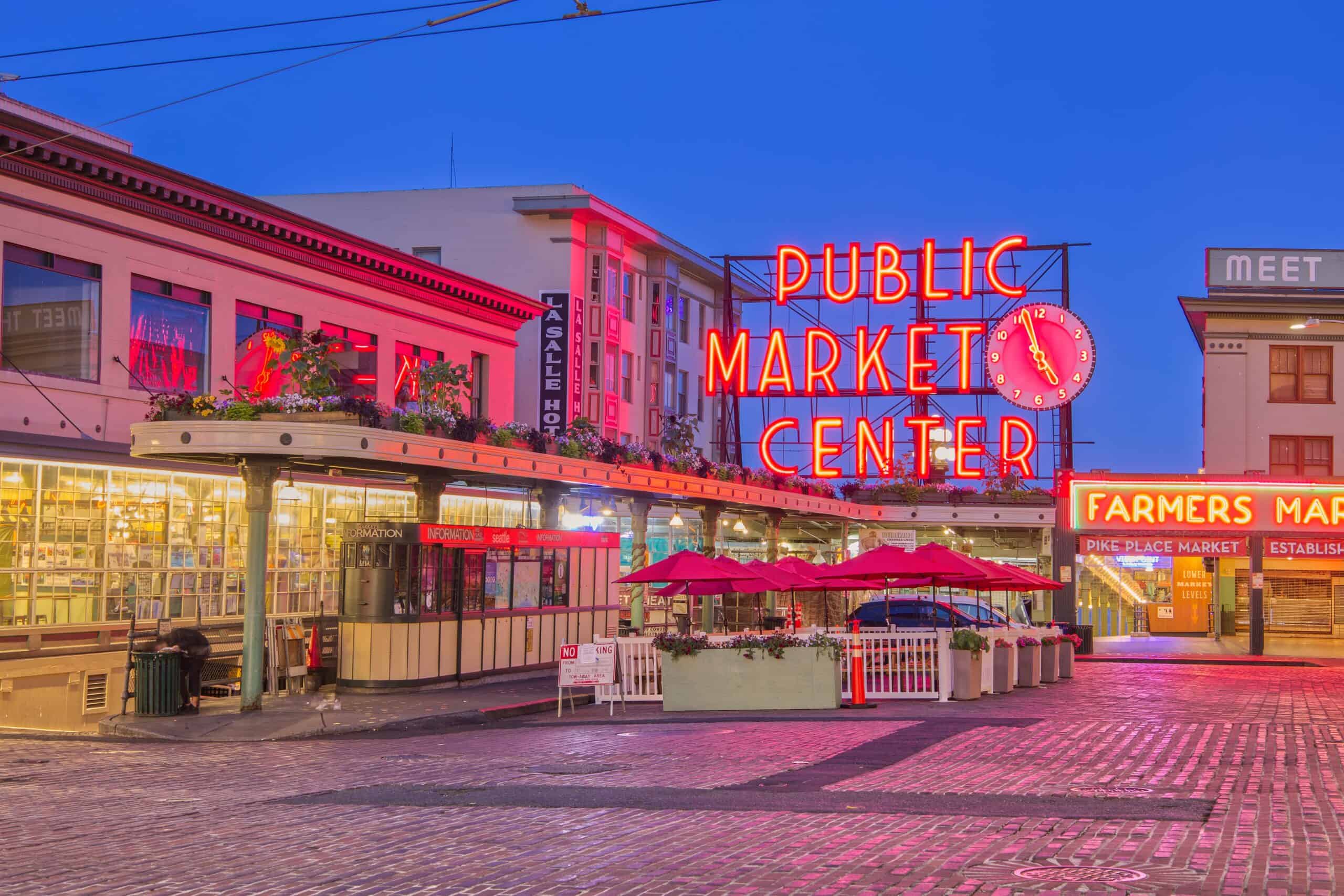
Pike Place Market, Seattle, USA
Pike Place Market is an iconic market overlooking Elliott Bay. It’s famous for its fresh seafood, vibrant flowers, and unique crafts. The market’s lively atmosphere is a major draw. Watch the fishmongers toss fish and visit the original Starbucks nearby. The best times to visit are early morning or late afternoon. Itâs centrally located in downtown Seattle, accessible by bus or car.
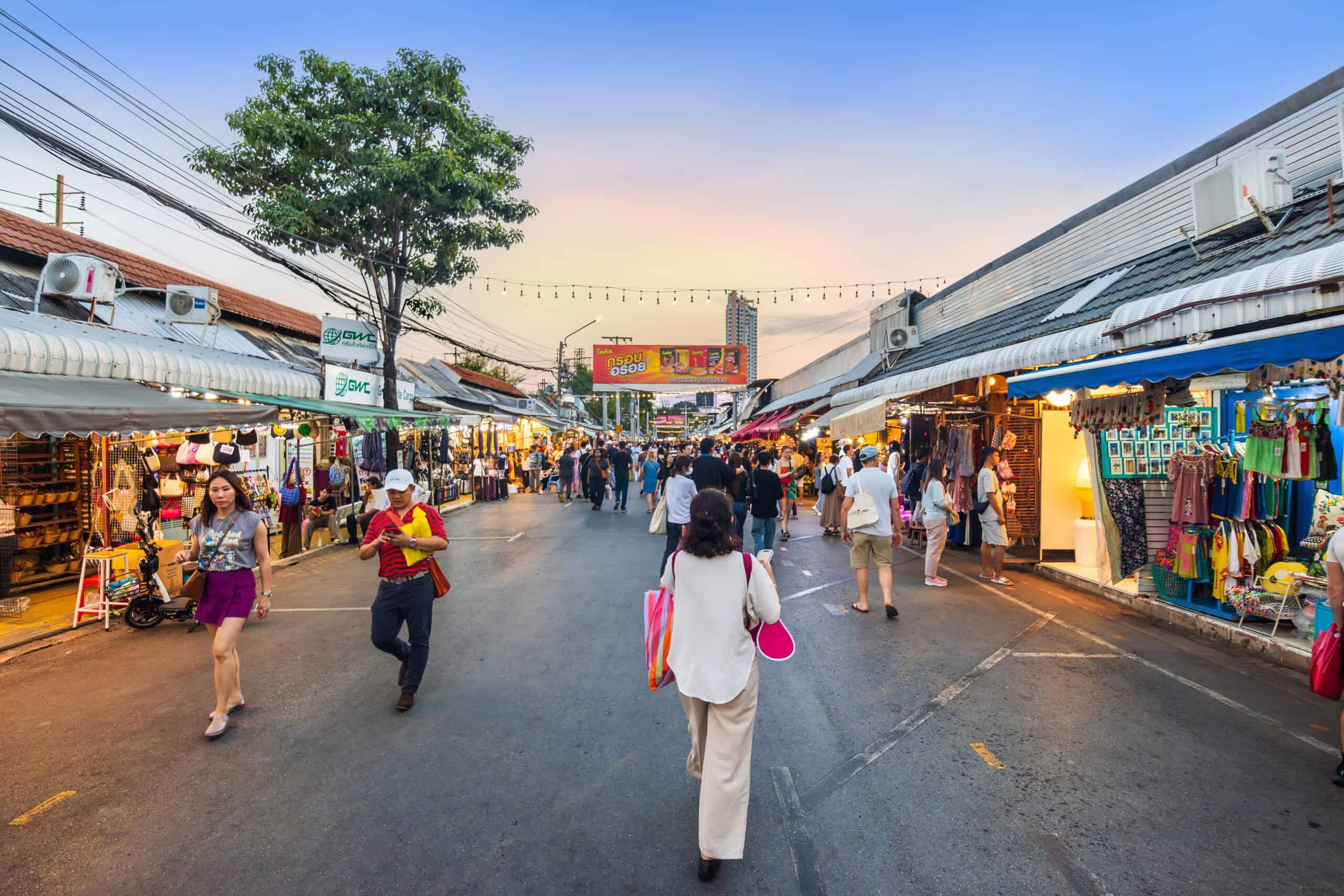
Chatuchak Weekend Market, Bangkok, Thailand
Chatuchak Weekend Market is one of the largest markets in the world. It offers everything from street food to clothing and antiques. The market is a bustling maze of over 15,000 stalls. Wear comfortable shoes and stay hydrated, and explore the food section for delicious local dishes. Early morning is the best time to visit to beat the heat and crowds. Take the BTS Skytrain to Mo Chit Station or the MRT to Chatuchak Park Station.
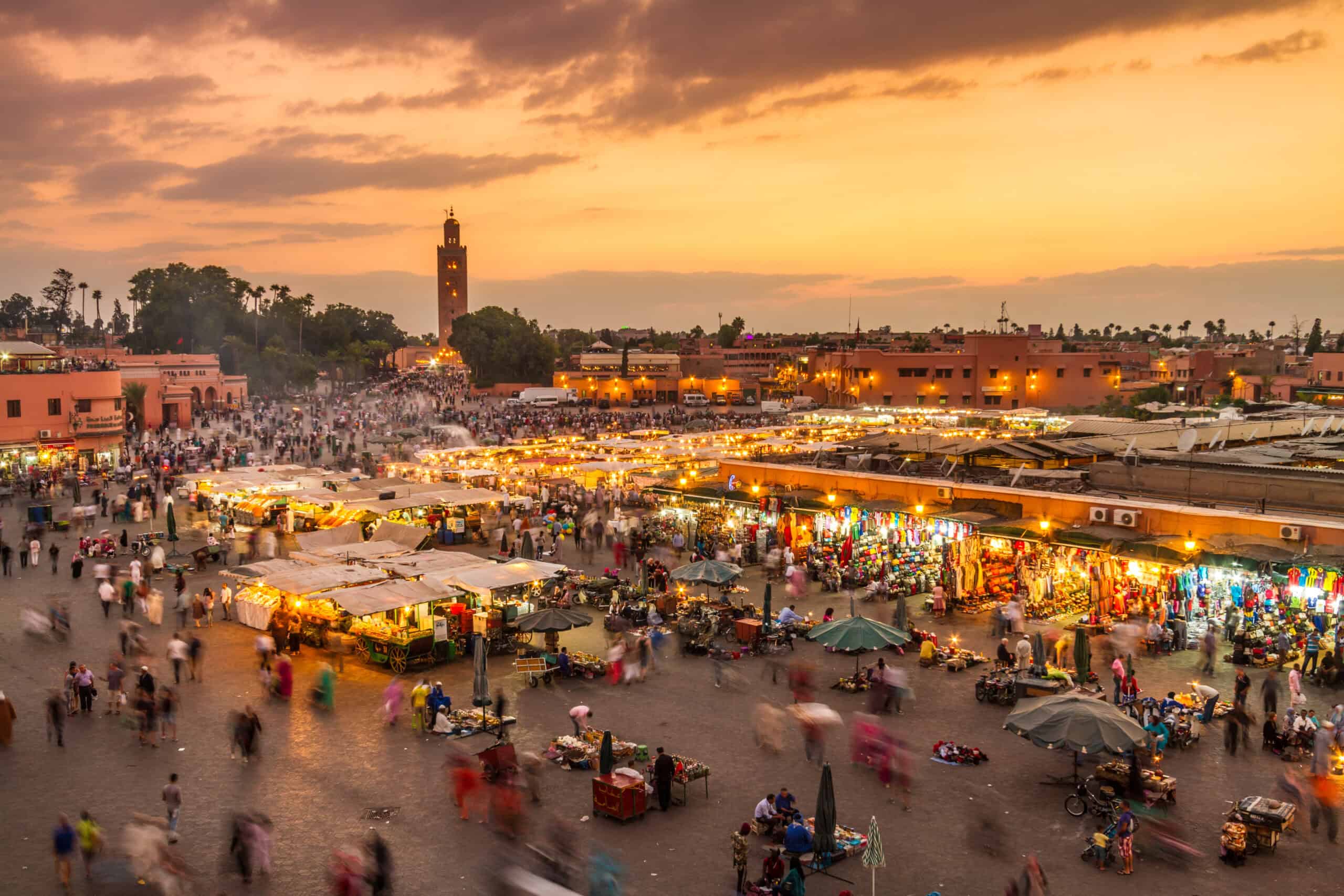
Djemaa el-Fna, Marrakech, Morocco
Djemaa el-Fna is a vibrant market square in the heart of Marrakech. It transforms from a bustling souk by day to a lively street food market by night. The market is known for its exotic spices, traditional dishes, and street performances. Try the fresh orange juice and traditional Moroccan dishes like tagine. Evening is the best time to visit when the market comes alive with food stalls and entertainment. Itâs located in the Medina, accessible by walking or taxi from anywhere in central Marrakech.
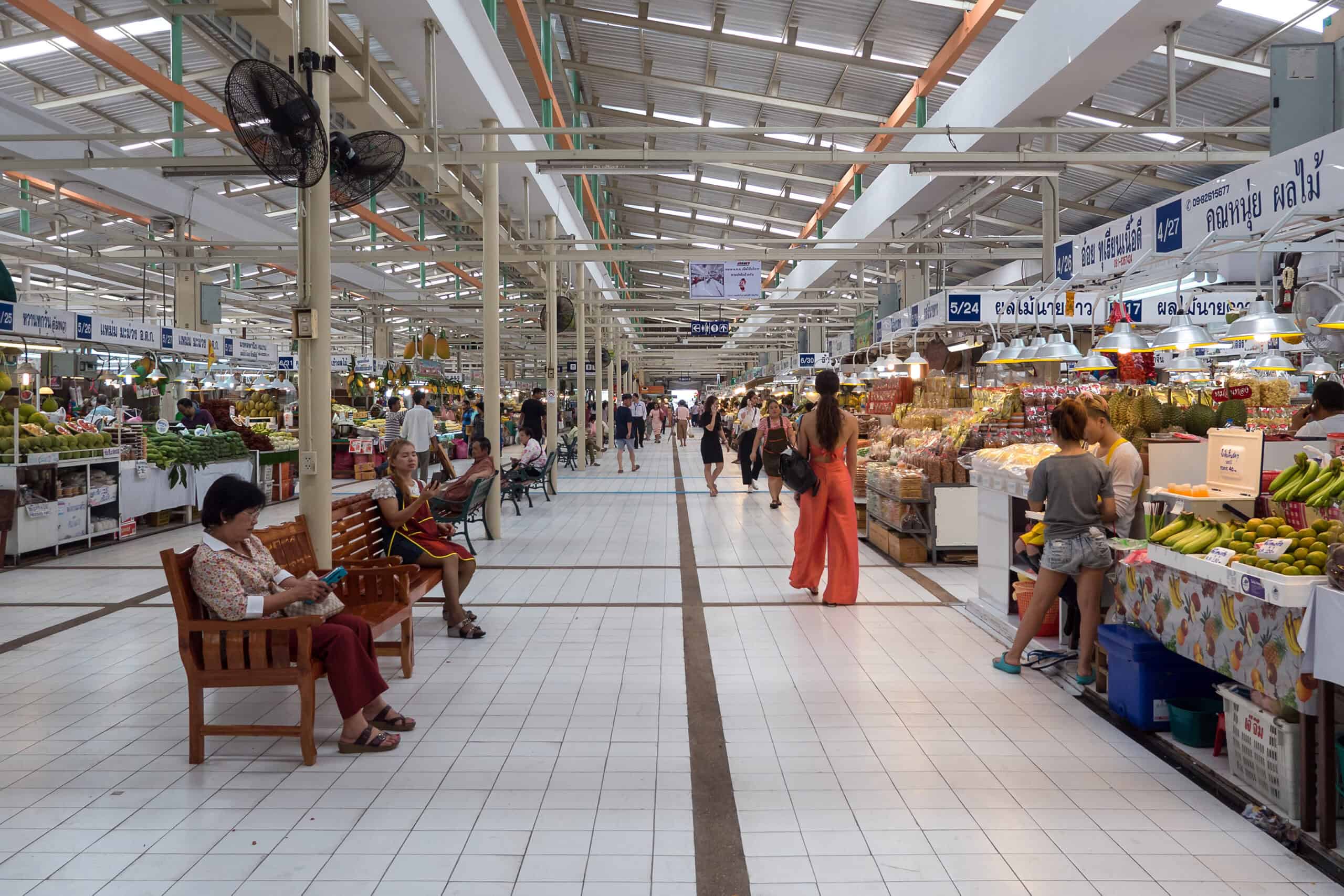
Or Tor Kor Market, Bangkok, Thailand
Or Tor Kor Market is known for its high-quality produce, fresh seafood, and exotic fruits. The market is clean, organized, and less crowded than other Bangkok markets. You can find a variety of ready-to-eat Thai delicacies and unique ingredients here. Visit the food court for delicious local dishes and make sure to go in the morning or late afternoon to avoid the heat. To get there, take the MRT to Kamphaeng Phet Station; it’s right next to the Chatuchak Weekend Market.
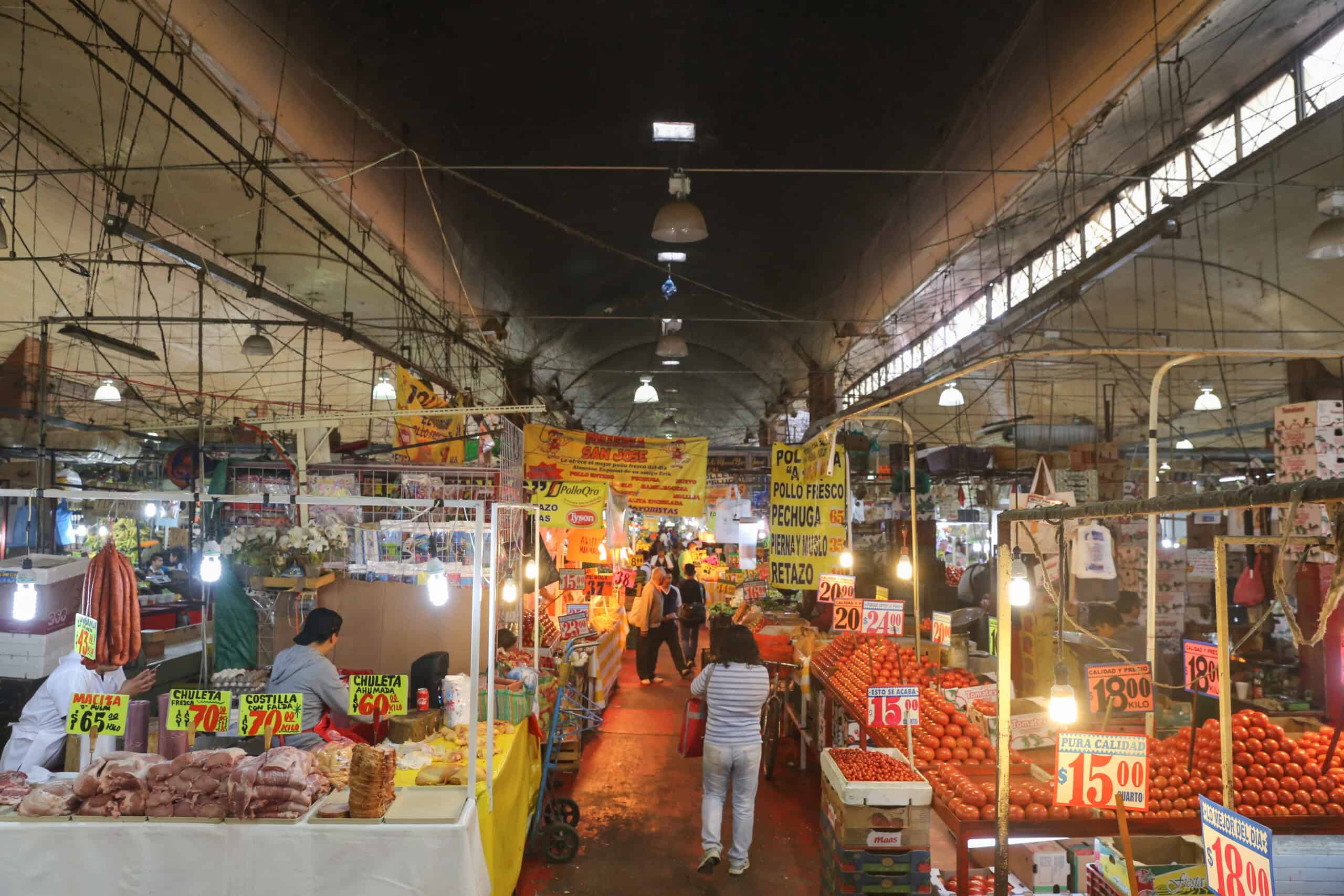
La Merced Market, Mexico City, Mexico
La Merced Market is one of the largest traditional markets in Mexico City, offering a vast array of fresh produce, meats, spices, and Mexican street food. The vibrant atmosphere and colorful stalls make it a sensory delight. Try the tacos and fresh fruit juices while youâre there. It’s best to visit early in the morning for the freshest goods. You can reach it by taking the Metro to Merced Station, with the market just a short walk away.

Rialto Market, Venice, Italy
Rialto Market, located near the iconic Rialto Bridge, is famous for its fresh seafood and produce. The market has been a staple in Venetian life for centuries and offers a variety of fruits, vegetables, and local specialties. Visit the seafood section for the freshest catch and come in the morning when the market is most lively. To get there, take the Vaporetto to Rialto Mercato and itâs a short walk from there.
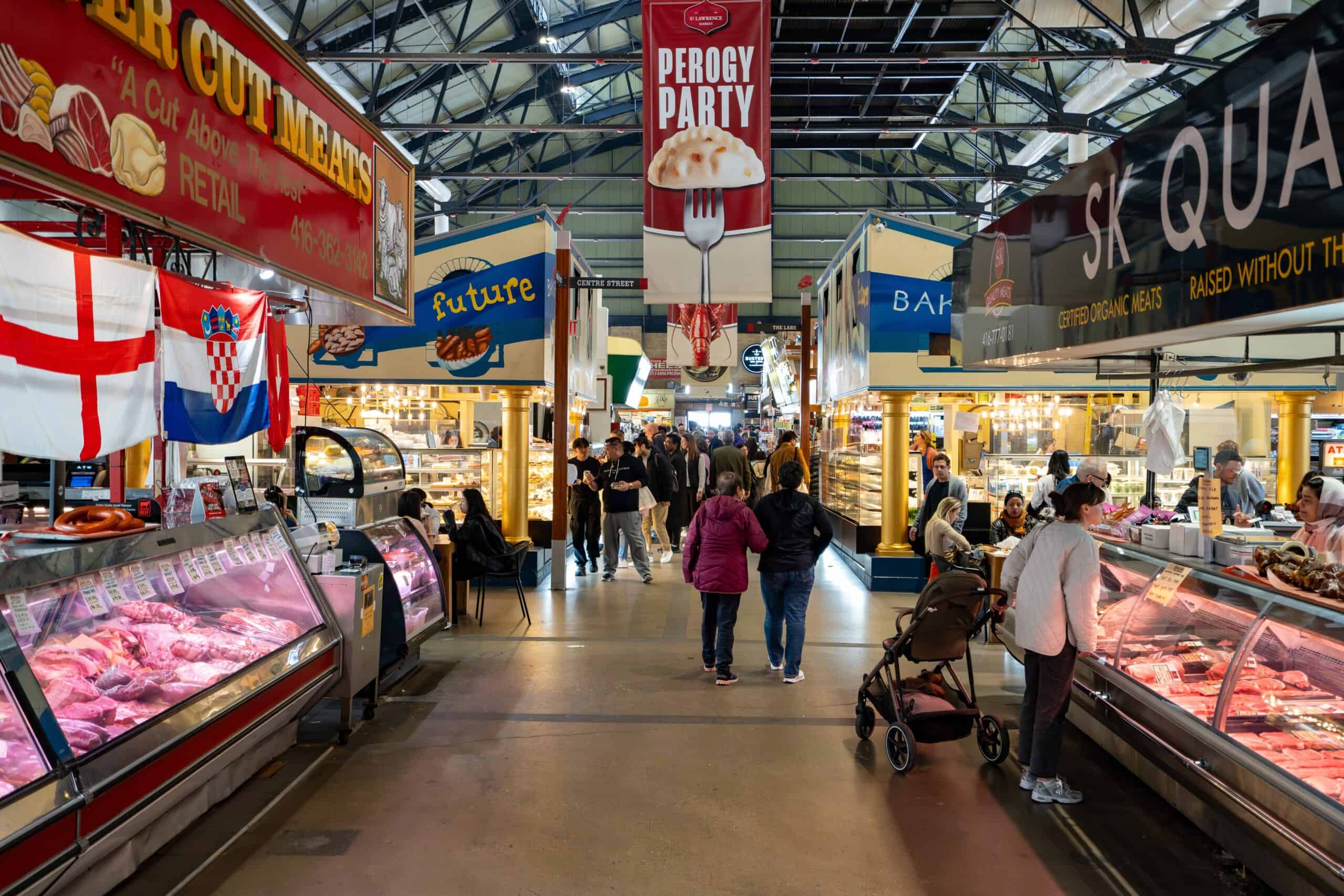
St. Lawrence Market, Toronto, Canada
St. Lawrence Market is a historic market in Toronto, known for its wide range of local and international foods. The market features over 120 vendors selling everything from fresh produce to artisanal goods, making it a must-visit for food enthusiasts. Donât miss the peameal bacon sandwich. The best times to visit are morning or early afternoon. Located in downtown Toronto, it’s accessible by public transit or car.

Mercato Centrale, Florence, Italy
Mercato Centrale is a bustling market in the heart of Florence, offering a wide range of Italian delicacies, fresh produce, and gourmet products. The market’s food court features various stalls serving traditional Tuscan dishes. Try the truffle pasta and local cheeses while youâre there. The best times to visit are morning or early evening. Located near the San Lorenzo Church, it’s easily accessible by walking from central Florence.
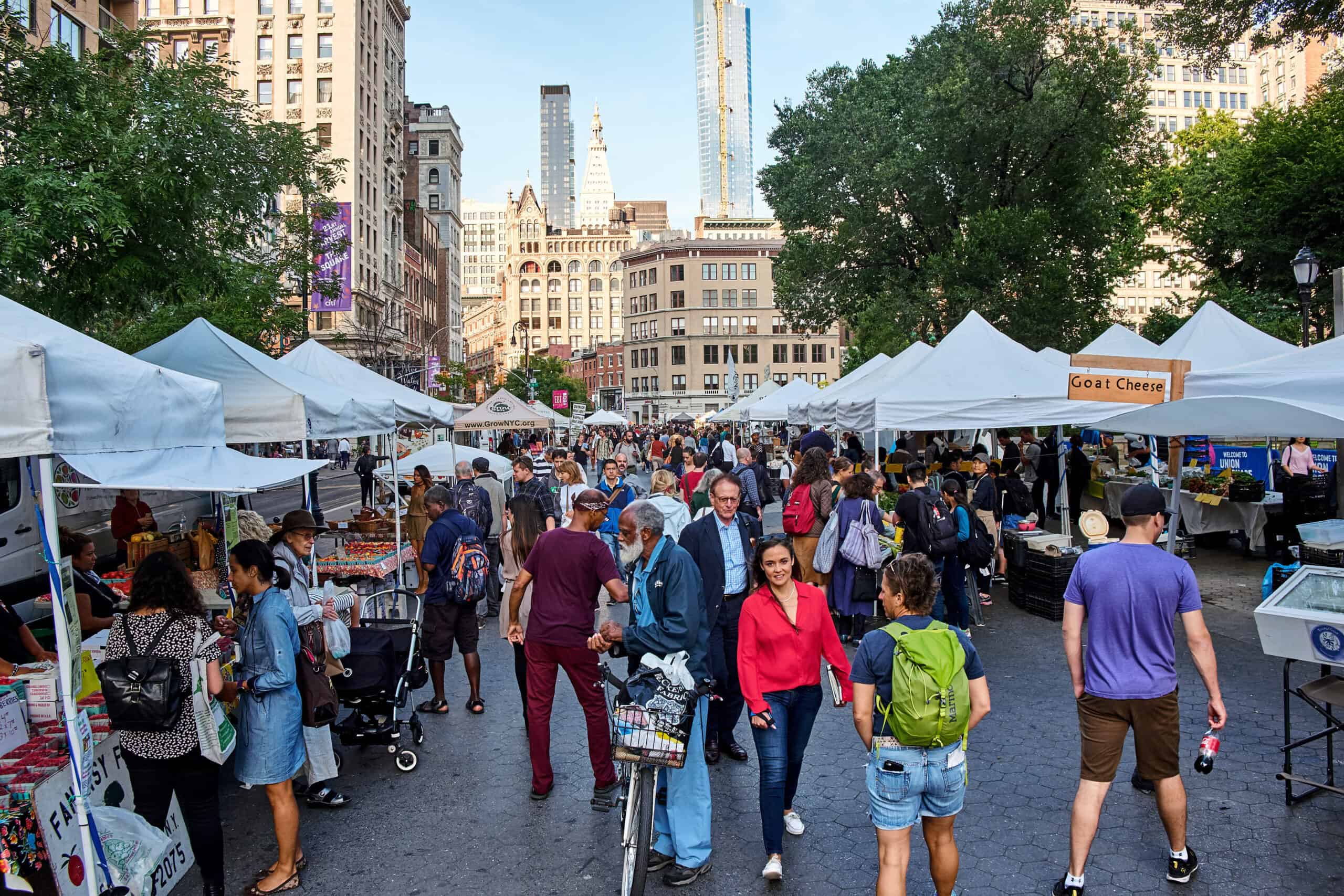
Union Square Greenmarket, New York, USA
Union Square Greenmarket is a popular farmers’ market in Manhattan, featuring a variety of fresh produce, meats, cheeses, and baked goods. The market supports local farmers and offers seasonal products. Visit on a weekday for fewer crowds and come in the morning for the best selection. To get there, take the subway to Union Square Station; the market is in Union Square Park.
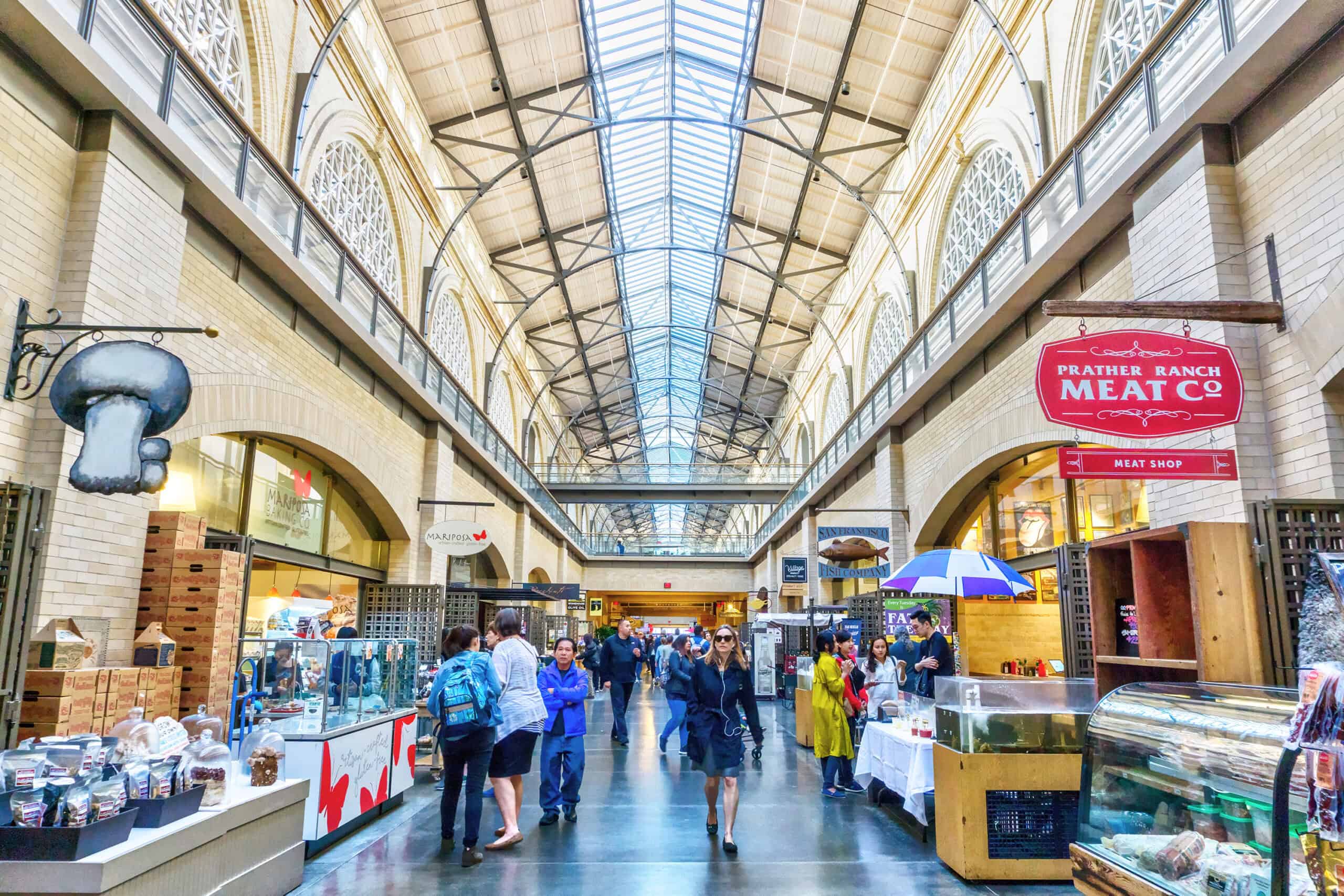
Ferry Building Marketplace, San Francisco, USA
Ferry Building Marketplace is a food lover’s haven located on the waterfront, featuring artisanal products, fresh produce, and gourmet food stalls. The market also offers stunning views of the Bay Bridge. Try the fresh oysters and artisan cheeses, and visit in the morning or early afternoon for the best experience. Itâs located at the Embarcadero, accessible by BART, Muni, or ferry.
This article originally appeared on Rarest.org .
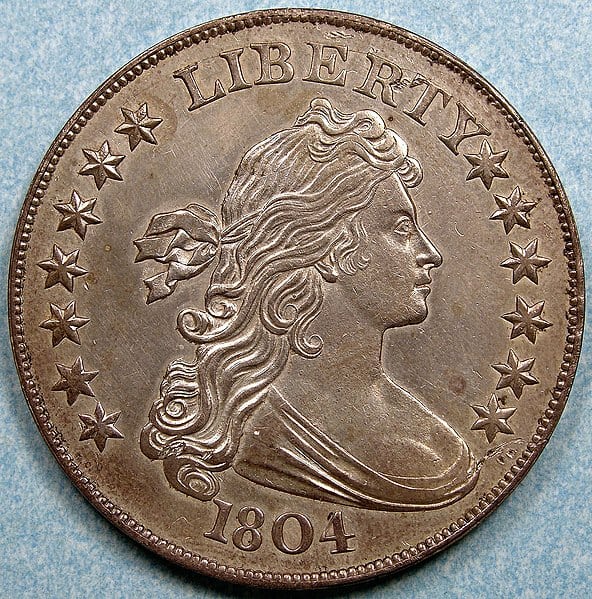
More from Rarest.org
Collecting antique coins is a captivating hobby that offers a glimpse into the past, blending history, artistry, and rarity. Among the vast array of coins, some stand out for their extreme scarcity and fascinating stories. Read More .

20 Unique Natural Marvels Around the World
Nature is full of surprises, presenting us with extraordinary phenomena that challenge our understanding and ignite our sense of wonder. Read More .
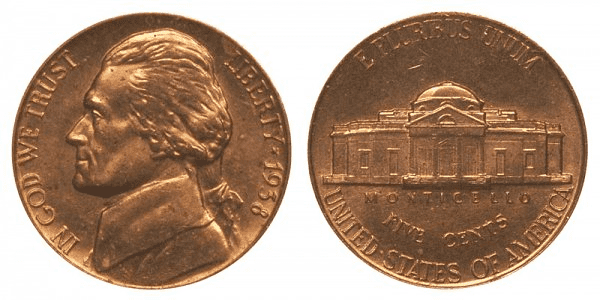
1938 Jefferson Nickel Value Guide
1938 marked the first year for the new design of the 5-cent piece in the US. This year, the Jefferson nickel was born. Read More .
More for You
Coffee recalled nationwide due to risk of fatal food poisoning
The Best Reason to Take Social Security Long Before Age 70
Fact Check: Rare Photo Depicts Country Music Icon Dolly Parton Without Signature Full Face of Makeup?
I tried the cheapest cheeseburgers at McDonald's, Wendy's, and Burger King and the least expensive was my favorite
5 Car Brands You Probably Didn't Realize Ford Owned
World's Largest Cruise Ship Catches Fire
Clarence Thomas just confirmed the dangers of his favorite judicial philosophy
The FDA has issued a nationwide recall of over 60 ice cream brands
How to get rid of eye bags, according to dermatologists
I’m a Bank Teller: 7 Reasons You Shouldn’t Keep More Than $3,000 in a Checking Account
16 Popular Pizza Chains, Ranked Worst to Best
Buc-ee’s celebrates grand opening of largest travel center location
'Make This a Federal Offense': EV Owner Exposes Troubling Nationwide Trend at Charging Stations

Deutsche Bank Article Among Trump's Classified Documents Raises Eyebrows
How to revive hair that thins, grays or gets out of control as you age
Raiders Coach Involved in $28 Million Bankruptcy Case
Don’t Buy a House in These 10 US Cities: Growing Populations and Overcrowding
Can I collect my dead spouse’s Social Security and my own at the same time? Here are 5 secrets of ‘survivors benefits’ you need to know
Can 3D-printed homes could help solve America's housing crisis
37 Silly, Absurd, And Super Freaking Creative Signs That'll Make You Snort With Laughter
Immerse Yourself in Art and History: Unveiling Tokyo's Museum at the Imperial Palace - Treasures of the Imperial Family at Sannomaru Shozokan
We use cookies to improve our contents. Check the detail and update your settings here .
We use cookies to improve our services.
For more details, please click here .

- Food & Drink
- Accommodation
- Things To Do
- All the categories
Transportation
- Weather & Seasons
- Long-Term Stay
- Travel Tips
- Event Tickets
- About MATCHA
- Company Profile
- Things To Do in Kanagawa
- Food & Drink in Kanagawa
- MATCHA Special Features
Near Tokyo! Atsugi Ayu Festival 2024: Schedule, Food Stalls, and Fireworks

Atsugi Ayu Festival is held every year in early August in Atsugi, near Tokyo. The fireworks display on the first night is extra crowded with more than 500,000 attendees each year. There’s also a dance contest, parades, fish-grabbing, and food stalls!
Atsugi Ayu Festival: Atsugi’s Biggest Summer Festival and Fireworks
Atsugi Ayu Festival is held every year in early August in Atsugi, a city neighboring Tokyo to the southwest. The area, known for its thriving ayu (sweetfish) fishing, is believed to have begun launching fireworks with the lifting of the sweetfish fishing ban during the Taisho period.
The festival is scheduled to be held on a grand scale over two days in 2024. It is filled with events and festivities for residents to participate in, including a dance contest, parade, a fireworks display featuring 10,000 fireworks lighting up the night sky, and sweetfish-grabbing.

Atsugi Ayu Festival’s Grand Fireworks Display. Picture courtesy of PR Times The Atsugi Ayu Festival’s Grand Fireworks Display, which takes place on the first night of the festival, is an incredibly popular event that attracts over 500,000 people each year. Our writer, who lives in Kanagawa Prefecture, has heard from her acquaintances that “you should attend at least once!” and “I go every year with my family!”
This article covers in detail the 2024 Atsugi Ayu Festival’s date and schedule, highlights, the fireworks display, food stalls, and more so keep reading!
Atsugi Ayu Festival Highlights and Tips

7 Annual Summer Festivals and Events in Japan 2024: From July to August
Enjoyable for All Ages! 4 Atsugi Ayu Festival Highlights
Many festivities and events are held at the Atsugi Ayu Festival. In this section, we introduce four highlights you’ll definitely want to keep your eye on.
1. The Atsugi Dance Legend Dance Contest
2. Children’s Sweetfish-Grabbing

Photo by Pixta This event for children takes place on the riverbanks of Sagami River. The challenge is to see if you can catch sweetfish placed in the shallow waters of the river with your bare hands! Any sweetfish caught by you and your children can be taken home. The 2023 festival required pre-registration (via lottery with no participation fees) and was held on the morning of the second day. The event is divided into two sessions based on age group.
3. Parade, Mikoshi Show, and Traditional Folk Dance

Atsugi Nakacho Street. Photo by Pixta You can enjoy the parade as it livens up the festive mood around Atsugi Nakacho Street, and watch as the mikoshi (portable shrines) parade through the streets.
4. Atsugi Ayu Festival’s Grand Fireworks Display
Atsugi Ayu Festival’s biggest attraction is the spectacular fireworks display. The fireworks are launched from a spot where Sagami River along with two other rivers converge about 15 minutes on foot from Hon-Atsugi Station.
Without further ado, let’s check out the highlights of the fireworks display, date and time, and how to get tickets!
10,000 Fireworks! Highlights of the Grand Fireworks Display
Atsugi Ayu Festival’s Grand Fireworks Display, held on the first night of the festival, is an incredibly popular event known for impressive fireworks that can be enjoyed from viewing areas near the launch site.
Approximately 10,000 fireworks are launched, one of the largest displays in the prefecture, with a dazzling finale inspired by Niagara Falls that is a must-see. In 2024, the event’s astounding scale and beauty are sure to captivate a large audience.
Viewing Areas and Ticket Information
There are typically four viewing areas each year: the riverbanks of Sagami River in Atsugi and Ebina, the Kaneda Second Youth Plaza, and the Asahimachi Sports Plaza .
Paid viewing seats are provided along the riverbanks, with four types of seats available on the Atsugi and Ebina sides. Prices range from 6,000 yen to around 20,000 yen. For the 2023 festival, tickets went on sale on July 1 and were available for purchase at 7-Eleven stores or through 7-Ticket .
The 2024 festival is anticipated to follow the same sales method, so we recommend purchasing tickets early.
Atsugi Ayu Festival Dates, Schedule, and Venue
Atsugi ayu festival 2024 festival dates.
This year, 2024, will be the 78th Atsugi Ayu Festival. The festival will take place over two days on August 3rd (Sat) and 4th (Sun). The Grand Fireworks Display will be held on the night of the 3rd.
2024 Festival Dates Dates: August 3 (Sat) and 4 (Sun), 2024 * The Grand Fireworks Display will be on August 3rd (Sat) * Check the official website (Japanese) for the latest information.
2023 Schedule
The schedule for this year’s festival has yet to be announced, but the following was the 2023 schedule (an excerpt of the main events schedule).
Day 1 10:00 ~ Citizens’ Food Stall Village, Atsugi Dance Legend (Atsugi Central Park) 12:30 ~ Opening Ceremonies, Opening Parade (Chuo Street ~ Atsugi Nakacho Street) 19:00 ~ Grand Fireworks Display begins (the banks of Sagami River)
Day 2 9:15 ~ Children’s Sweetfish-Grabbing (the banks of Sagami River) 10:00 ~ Citizens’ Food Stall Village, Atsugi Dance Legend (Atsugi Central Park) 12:00 ~ Atsugi Ayu Festival’s Dream Festival (Atsugi Park) 12:15 ~ Mikoshi Show (Atsugi Nakacho Street)
The main venues are Atsugi Nakacho Street, Atsugi Ichibangai Shopping Street, Atsugi Central Park, and the banks of the Sagami River. The nearest station is Hon-Atsugi Station on the Odakyu Odawara Line, which is located about 10 minutes on foot from each venue.
Try Atsugi’s Local Specialties at Food Stalls!

Photo by Pixta When it comes to festivals, it’s all about the food stalls, right? At the Atsugi Ayu Festival, numerous food vendors and experience booths are planned to set up stalls in various locations including Atsugi Central Park and Atsugi Ichibangai Shopping Street .
At the food stalls, you can enjoy staple festival foods like shaved ice and chicken karaage. You should definitely give Atsugi’s unique local specialties a try. Some of the foods that will be available include ayu shioyaki (grilled sweetfish with salt), Atsugi shirokoro horumon (grilled stuffed offal), and tonzuke (grilled miso pork) . Moreover, food trucks and local restaurants will also set up stalls, so how about challenging yourself to try various types of foods?
For those with children or who want to relax and sit down, we recommend using the dining areas set up in places like Atsugi Central Park.
Precautions: Traffic Regulations and Heat Safety

Photo by Pixta During the Atsugi Ayu Festival, traffic regulations will be put into place on roads near Hon-Atsugi Station, so we recommend taking public transportation when possible . If you are traveling to the festival by car, then make sure to head out only once you have checked the route and parking lots beforehand.
The roads and station, even as a pedestrian, will be extremely crowded once the Grand Fireworks Display is over. Follow the signs or instructions from guides and allow yourself extra time to get home.
Additionally, the annual heat wave is expected in early August. Please take precautions when going out, such as using a parasol or hat, staying hydrated, and avoiding overexertion by taking breaks.
Enjoy Fireworks and Food at the 2024 Atsugi Ayu Festival

Ueno / Asakusa / Akihabara

Japanese Festivals and Fireworks Displays in 2024

Fireworks in Japan: The Best Festivals, History, and Tips

Japan's Summer Festivals - How To Enjoy The Famous Matsuri

12 Must-See Japanese Festivals Held Throughout The Year

Born in Yamagata Prefecture. I have experience working in community development at the foot of Mt. Fuji and PR for local products across the country, and am currently working in Tokyo to disseminate information about Yamanashi Prefecture. A mother of one who loves local gourmet food and alcohol.
Related topics
Top articles.

Yokohama: Top 25 Things to Do in the Famous Port City Near Tokyo

How to Reach Kamakura From Tokyo: Recommended Train Lines
Start planning your trip
Special Features

Popular Searches
Latest news.

Tanabata Sky Lantern Festival 2024: See a Sky of Lights This Summer!

Visit in June! Minamisawa Hydrangea Mountain: Tokyo's Flower Paradise

Mishima Skywalk Hydrangea Festival 2024: Mt. Fuji Views and Vibrant Blooms

Floral Desserts in Kyoto! Itoh Kyuemon's Uji Matcha and Hydrangea Festival

Discover Kyoto's Elegant Geisha Culture at the Gion Kagai Art Museum

Japan's Public Holidays and Long Weekends in 2024

Aeon Mall Okinawa Rycom: A Shopping Mall Featuring a Resort Aura

Suica and Pasmo IC Cards: Prepaid Transportation Passes in Japan

Riding Taxis in Japan: The 6 Best Apps to Grab a Cab

How to Travel to Kyoto From Osaka: The Fastest and Cheapest Ways
New articles.

Travel Back to the Edo Period! Exploring Kusatsu City’s Historical Charms by Walk

Mt. Fuji & Kawaguchiko: Top 8 Fireworks and Summer Festivals

Let's spread the word about Kobe's new local gourmet food, "Kobe Cheese Toast"! Check out our past events!

Nagoya: 30 Things to Do in 2024, Ghibli Park, Food, and Travel Tips
- - K-town Now
- Asia-Pacific
- - Storm Tracker
- Middle East
- Map of Memorials
- Entertainment
- - Video Games
- Europe Travel
- - Quick Trips
- - After Hours
- Pacific Travel
- The Meat and Potatoes of Life
- U.S. Travel
- Storm Tracker
- Rewards for readers
- Get Stripes
- Stripes Lite
- Archives/Library
- Special Publications
- Mobile Apps
- Email Newsletters
- Digital Access
- Home Delivery
- Marine Corps
- Coast Guard
- Space Force
- Archive photo of the day
- - Schedules Europe
- - Scoreboards Europe
- - Schedules Pacific
- - Scoreboards Pacific
- - Pacific Sports Blog
- - WW II Podcast
- - Military Matters
- - Force for Hire
- Out of Uniform
- - WW II Videos
- Communities
- Stripes Europe
- Stripes Guam
- Stripes Japan
- Stripes Korea
- Stripes Okinawa
- Our Other Websites
- In Memoriam
- Month of the Military Child
- Best of Germany
- Best of the Pacific
- Letters to Santa
After Hours
Vegan japanese curry and chocolate dessert to die for at tokyo eatery.
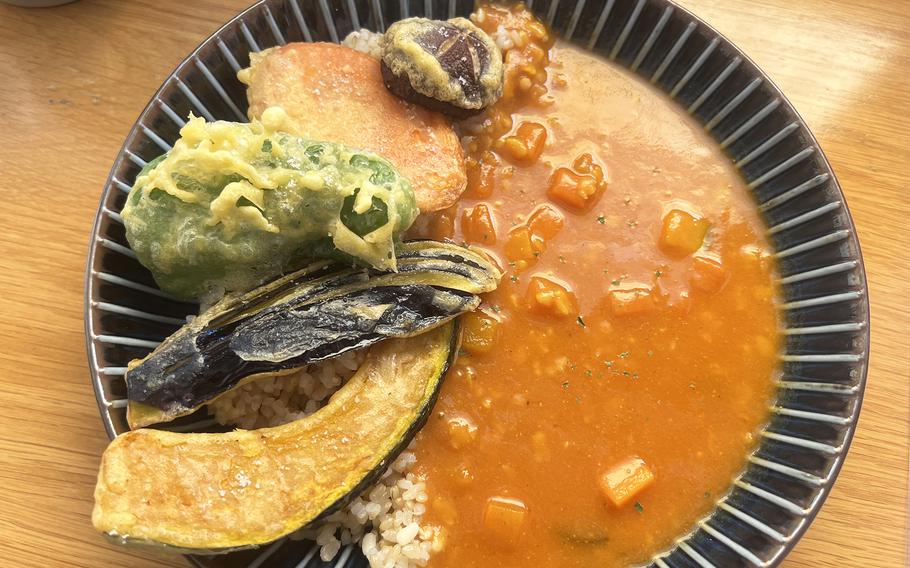
Tempura topping curry, a curry of fresh vegetables topped with vegetable tempura with multigrain rice at Marugoto Vegan Dining Asakusa in Tokyo. (Kelly Agee/Stars and Stripes)
Vegan food, especially Japanese curry, can be hard to find in Japan, but at Marugoto Vegan Dining Asakusa, vegan diners can enjoy the Japanese culinary classic.
The restaurant is in the Asakusa district in Tokyo, near the Sumida River, and has a perfect view of the Tokyo Skytree across the street.
The owner and all the staff are vegan and may assist customers who are interested in veganism, according to the restaurant website. In addition to being vegan-friendly, all the dishes in the restaurant are gluten-free, so they offer choices for a variety of dietary restrictions.
Marugoto Vegan Dining Asakusa can seat 14 inside and six outdoors, and dogs are allowed in the restaurant.
I opted for their most popular dish, the tempura topping curry for 1,749 yen, or $11.11, with an organic rooibos tea for 550 yen and a chocolate special for dessert for 800 yen.
It was a delicious curry made of fresh toasted vegetables topped with vegetable tempura with multigrain rice on the side.
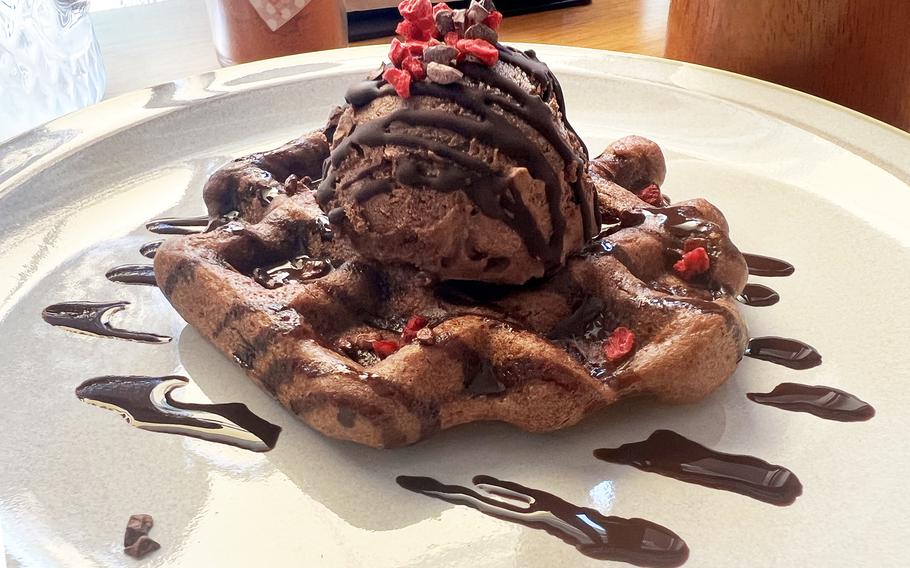
The chocolate special, a chocolate rice waffle topped with chocolate vegan ice cream, chocolate sauce, organic cacao nibs and freeze-dried raspberries at Marugoto Vegan Dining Asakusa in Tokyo. (Kelly Agee/Stars and Stripes)
The chocolate special is a chocolate rice waffle topped with chocolate vegan ice cream, chocolate sauce, organic cacao nibs and freeze-dried raspberries. It was to die for, and I couldn’t tell that it was gluten-free and vegan.
Other food items are tempeh topping curry, a traditional Indonesian food made from fermented soybeans; fried soybean meat topping curry, an organic soybean meat topped with their special seasoning made with tahini sauce; and avocado topping curry, which is topped with half an avocado. All those curries are 1,584 yen for a regular potion and 2,035 yen for a large portion.
Drink options are hot or cold organic coffee or tea for 550 yen; apple juice or organic almond and coconut milk for 600 yen; and craft cola for 660 yen, which can be upgraded to a craft cola ice cream float for another 164 yen.
Other dessert options include a sweet potato donut for 300 yen; rice flour waffles in plain or chocolate for 330 yen; and homemade vegan ice cream, a vanilla ice cream made from coconut milk and topped with cashew nuts, maple syrup and cocoa, for 539 yen.
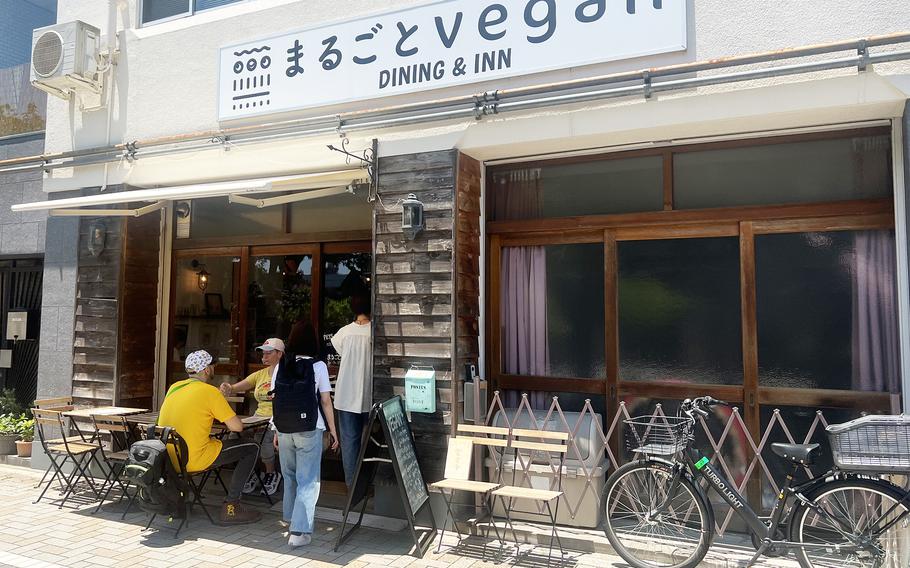
Marugoto Vegan Dining Asakusa in Tokyo, Wednesday, June 5, 2024. (Kelly Agee/Stars and Stripes)
Marugoto Vegan Dining Asakusa
Location: 1 Chome-3-13 Hanakawado Taito City, Tokyo 111-0033
Hours: Open 11:30 a.m. to 3 p.m. Tuesday through Friday; 10 a.m. to 5 p.m. Saturday and Sunday; closed Mondays
Prices: Items range from 300 yen to 2,035 yen.
Dress: Casual
Directions: Four-minute walk from Kanda Station, Tokyo
Online: dining.marugotovegan.com/menu

Sign Up for Daily Headlines
Sign up to receive a daily email of today's top military news stories from Stars and Stripes and top news outlets from around the world.
Sign Up Now
You are using an outdated browser. Please upgrade your browser to improve your experience.
- Restaurants
- Best-of Guides
- MICHELIN Guide Ceremony
- My Favorites
- Subscribe to newsletter
- Booking partnership with OpenTable
- Booking partnership with Resy
- USA - English - USD
- Best Day Trips from Tokyo
Our top picks for day trip destinations easily reached from the capital
Travel Things to do in Tokyo Editor's Pick Japan

Tokyo by The MICHELIN Guide
See the Tokyo guide

Not only is Tokyo an exciting destination in its own right, it also serves as a great base for exploring further afield. And should you want to savor them at a more leisurely space with an overnight stay, check out our suggestions for MICHELIN Guide hotels in each location.

Experience the modern side of the city at Minato Mirai 21, a waterside shopping and entertainment hub with gleaming high rises, museums and the Cosmo World Amusement Park. Another popular shopping spot in this area is the Red Brick Warehouse, a historic port facility which has been transformed into an atmospheric setting for restaurants and bars.
For panoramic city views, head up to the observatory on the 69th floor of the Landmark Tower, or take a trip on the Yokohama Air Cabin cable car that connects JR Sakuragicho Station and Unga Park Station. Yokohama is one of Japan’s most photogenic cities at any time, but the evening views are truly magical.

Getting there: Central Yokohama can be reached in 20 to 30 minutes on various express trains from Shinjuku, Shibuya, Tokyo or Shinagawa Stations.
If you’d like to spend the night in Yokohama, check out:
Hotel Edit Yokohama
The Knot Yokohama
InterContinental Yokohama Pier 8
Catch a bus from Hakone-Yumoto Station, the gateway to Hakone, to reach beautiful Hakone Shrine and Lake Ashi. After exploring the shrine, walk down to the edge of the lake to see another of Hakone’s most famous sights—the vermillion torii gate ‘floating’ on the lake with Mt. Fuji behind. While they seem an incongruous match for such a traditional setting, colorful boats decked out like pirate ships are a popular option for cruising on the lake. Indulge your inner child and enjoy the photo ops during a relaxing excursion. Take the boat from Motohakone and get off on the other end of the lake at Tongendai. From there it’s a short walk to the Hakone Ropeway, which will take you up to the steaming geothermal area of Owakudani and, with luck, more views of Mt. Fuji. Try some of Hakone’s signature black eggs (chicken eggs boiled in hot spring waters) while you’re there.
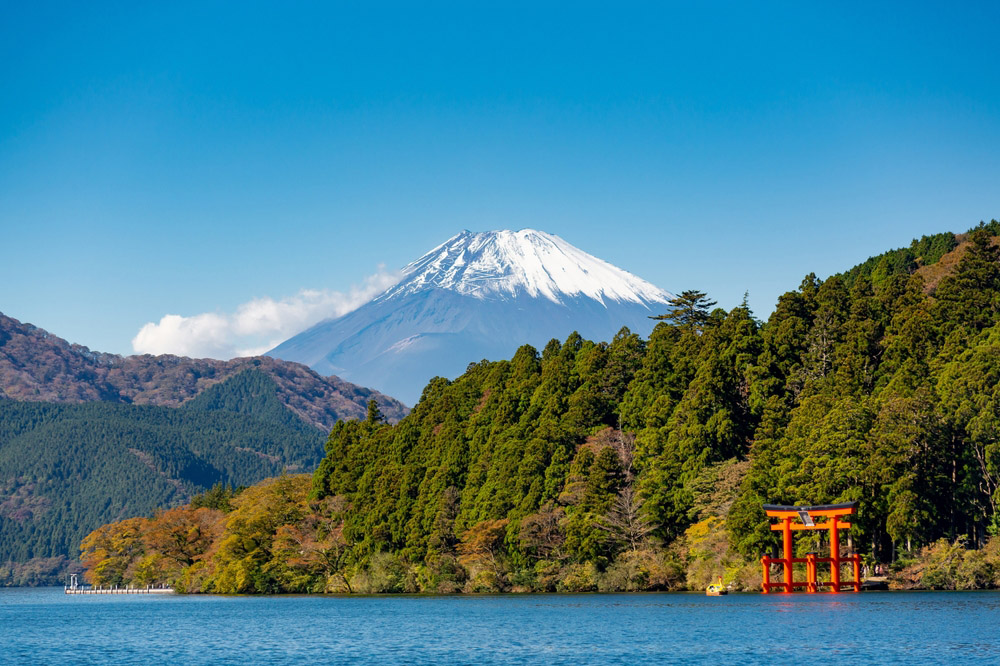
Gora Park boasts an attractive French-style garden with various flowers and is situated between two very different art museums. The Hakone Museum of Art features an extensive collection of Japanese earthenware and sits next to the park, while a 15-minute walk brings you to the Hakone Open-Air Museum, with a wide range of modern sculpture plus dynamic playscapes to delight the youngest members of the family. Access all three attractions directly by taking a train from Hakone-Yumoto to Gora, or take the Hakone Ropeway from Togendai/Owakudani and change to the Hakone Tozan Cablecar at Sounzan. Getting there: The easiest way to reach Hakone from Tokyo is to board the Odakyu Romance Car at Shinjuku Station, and travel directly to Hakone-Yumoto Station. The journey takes about 90 minutes and advance reservations are required. If you’d like to spend the night in Hakone, check out:
Hyatt Regency Hakone Resort and Spa
Hotel Indigo Hakone Gora
Fufu Hakone
Visitors staying overnight may wish to check out the Hakone Freepass, a discount ticket which comes in two or three-day versions and covers eight different transportation systems in the area, including the round trip from Tokyo.

Izu Peninsula

Shimoda and Kawazu
Shimoda sits at the tip of the Izu Peninsula and is widely considered to have some of Japan’s best beaches. During his second voyage to Japan in 1854, American Commodore Matthew Perry spent time in Shimoda with his fleet of “black ships” (kurofune)—the Japanese name for the western vessels—and the first US Consulate in Japan was subsequently established here in 1856. Learn more about these events at the Shimoda Museum of History and the nearby Ryosenji Temple, where Perry conducted negotiations with the ruling Tokugawa shogunate. Other activities within easy reach of the central area around Izukyu-Shimoda Station include strolling Perry Road, an attractive tree-lined street with restaurants, cafes and shops, or taking a short cruise of the port aboard a replica of a black ship. Shirahama, one of the area’s most popular beaches, is a 15-minute bus ride from the city center. If time allows, take the train to the neighboring town of Kawazu and then change to a bus to reach the Kawazu Nanadaru, a series of seven lovely waterfalls along a wooded 1-km trail.
Shuzenji Onsen
If you’d like to spend the night in Izu, check out:

Top Image: Ⓒ593_AdobeStock

Originally from New Zealand, Louise George Kittaka is a Japan-based freelance writer and cross-cultural specialist, with a passion for exploring the country she has called home for more than two decades. When she isn’t at her computer, Louise loves visiting waterfalls, going to afternoon tea, and collecting anything related to the Aliens movie franchise.

2 Days in Mexico City
A first-time visitor's guide to the city's top spots to drink, dine, shop, and stay.

New York's Most Famous Hotel Rises Again
The Chelsea Hotel is back. The New York landmark and one-time home to dozens of the city’s most famous residents has been reinvented — and boasts a new MICHELIN Key.

The Best MICHELIN Guide Hotels with Pools in New York City
Get the laps in with a picturesque view.

Inspector Visits: Terra Dominicata, Three Key Hotel Outside Barcelona
Notes and recollections from one Inspector’s visit to a carefully restored monastic estate & winery — just a couple hours from Barcelona.
Keep Exploring - Stories we think you will enjoy reading

11 Tips for Cooking with Spices
Master the art of mixing and introducing new flavors to amplify a meal.

5 MICHELIN Guide Chefs on Pride and Being Themselves
These buzzy LGBTQIA+ chefs, sommeliers, and front-of-house staffers prove the power of individuality.

Jeff Leatham and Genesis Make Florals Groundbreaking Anytime
Summer is in full bloom on and off the menu at Genesis House.

Inside Pharrell’s Louis Vuitton Afterparty with Nami Nori’s Jihan Lee
The sushi chef and owner brings his haute spin to late night bites.

Eight Frozen Drinks to Sip This Summer in New York City
Beat the heat and chill.

2 days in Milan for Design Lovers
A Fashionable Itinerary in the Style Capital.

Diary of a Dish: The Unicorn at Miami’s Pao by Paul Qui

The Inspectors Reveal All on Daigo, One MICHELIN Star Restaurant Specializing in Shojin Ryori
From the journal of a MICHELIN Guide Inspector . Experience Japanese culture through Shojin ryori vegetarian cuisine.

Kiko Mizuhara's Tokyo Favorites: A Guide to Experiencing the Fun and Stylish Side of the City
As you explore the city, let Kiko Mizuhara’s favorite spots guide you to some of the best-kept secrets and must-visit locations.

All You Need to Know About Toyosu and Tsukiji Markets
Top-quality ingredients, traditional snacks, tuna auctions—there’s something for everyone at these markets.
MICHELIN Guide

Use the app to find the best restaurants and hotels everywhere
Be the first to get news and update about the michelin guide.
MICHELIN Guide selections
The michelin group.
- Terms of Use
- Privacy Policy
- Legal Notice
Display settings
Customize your experience by easily adjusting display settings for territory, and currency to suit your preferences!
Member privileges
The Plus program provides upgrades and amenities at participating hotels. For this hotel, Plus members will receive:
Non-members can add the privileges at checkout through our 30 day free trial, cancellable at anytime.
STARS AND STRIPES
- Middle East
- Asia-Pacific
- Map Of Memorials
- Entertainment
- - Video Games
- Europe Travel
- - Quick Trips
- - After Hours
- Pacific Travel
- The Meat and Potatoes of Life
- U.S. Travel
- Storm Tracker
- Rewards for readers
- Get Stripes
- Stripes Lite
- Archives/Library
- Special Publications
- Mobile Apps
- Email Newsletters
- Digital Access
- Home Delivery
- Marine Corps
- Coast Guard
- Space Force
- Archive Photo Of The Day
- - Military Matters
- - Force For Hire
- Out of Uniform
- Communities
- Stripes Europe
- Stripes Guam
- Stripes Japan
- Stripes Korea
- Stripes Okinawa
- Our Other Websites
- In Memoriam
- Month of the Military Child
- Best of Germany
- Best of the Pacific
- Letters to Santa
Food & Drink
Fonda mexicana new york opens in ginza, tokyo.
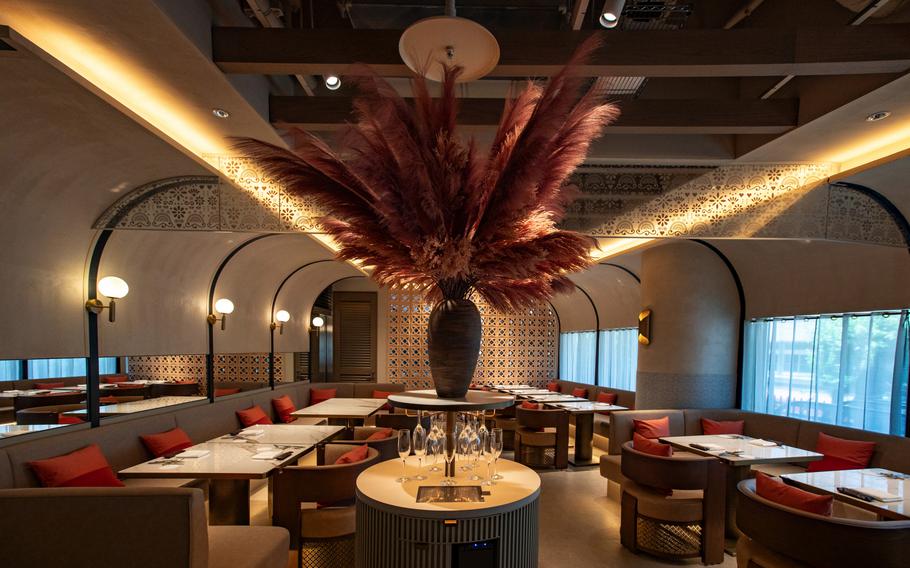
(FONDA MEXICANA New York)
On June 14, 2024, Tokyo welcomed the first Japanese branch of FONDA MEXICANA New York at Ginza’s Granbell Square. A fine dining restaurant renowned for its modern Mexican cuisine, the establishment is a long cherished gem of in-the-know sophisticated New Yorkers. The trendy Ginza location marks its first expansion into Japan, promising the same level of excellence as its American counterparts. Led by the award-winning chef and culinary director, Roberto Santibañez, the restaurant spices up the New-York dining experience with an authentic taste of Mexico.

Meet the chef

Chef Roberto Santibañez (FONDA MEXICANA New York)
Chef Santibañez is from Mexico City and is a graduate of the prestigious Le Cordon Bleu in Paris. His distinguished career includes opening three restaurants in Mexico City, serving as the culinary director at “Fonda San Miguel” in Austin, Texas and at “Rosa Mexicano.” His modern yet tradition-respecting approach to Mexican cuisine has made him a beloved figure in the culinary world, appearing on shows like “Good Morning America”, and expanding locations to Las Vegas, Boston and even at Disney World.
Exclusive menu
FONDA MEXICANA New York in Tokyo offers course options as well as a la carte. The former is designed to offer guests a chance to try several different dishes. The Introduction course includes traditional Mexican dishes like Guacamole Chicharrón, Tuna Tostada and Mixote Grilled Chicken. The FONDA Medley course features a more diverse selection, including Mexican Crab Cake and US Skirt Steak Sizzling Fajitas. For a more comprehensive course, the Especial course includes Spicy Grilled Jumbo Shrimp and Miyazaki Beef Steak, showcasing the best of FONDA’s menu.
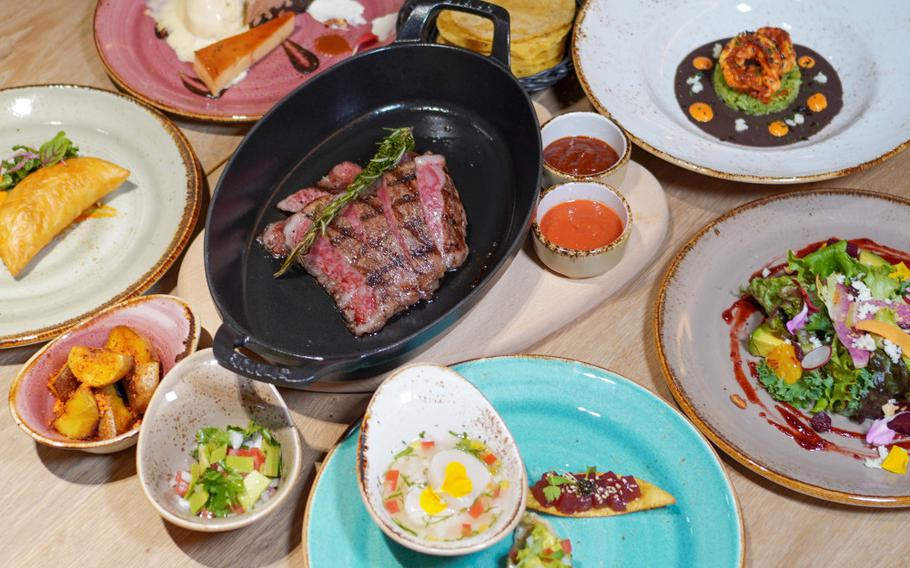
The lunch menu includes lighter options such as the Three-Taco set, Birria Burrito set and regular specials. The Gusto lunch course and Primera course include a main dish choice of Mixote Grilled Chicken or Sizzling Fajitas along with Guacamole Chicharrón, a green salad, and a seasonal soup. These courses provide a perfect introduction to the flavors of FONDA MEXICANA New York.
NYC-Inspired interior design
The restaurant’s interior, designed by Junpei Yamagiwa, has worked on iconic establishments such as “Peter Luger Steak House” and “Lawry’s The Prime Rib” in Ebisu. Yamagiwa visited the original FONDA locations in New York to capture its essence and collaborated closely with Chef Santibañez to ensure the design reflects the authentic spirit of FONDA. The result is a space that encompasses sleek, stylish New York vibes. Made warm and inviting not only through the food but also through accessories such as the rosy cushion decor, FONDA MEXICANA is a must-visit for Tokyo’s finest diners.
Check out FONDA MEXICANA’s official website for more information.
IG: @fonda.ginza
metropolisjapan.com
related stories
- A guide to Tokyo’s best rooftop bars
- Taste of Tokyo: Celebrate SpongeBob at CAFE Secret Recipe in Shibuya June 14 - Nov. 4
- The Roof and Lobby Bar: A cozy panorama bar and an artistic cafe in Ginza, Tokyo
The best stories from the Pacific, in your inbox
Sign up for our weekly newsletter of articles from Japan, Korea, Guam, and Okinawa with travel tips, restaurant reviews, recipes, community and event news, and more.
Sign Up Now

IMAGES
VIDEO
COMMENTS
Taking a food tour in Tokyo is essential for any trip to Japan. With more Michelin-starred restaurants than anywhere else in the world, Tokyo is the world's number one cuisine city. For alternative Tokyo gourmet travel experiences, check out: Tsukiji Outer Market Tours - experience Tokyo's atmospheric old fish market district
Japan is known for its fresh seafood, and this small-group tour explores the outer Tsukiji Fish Market, where Tokyo's top…. Recommended by 97% of travelers. $100. 2. Shinjuku Izakaya Food Tour. 403. Food & Drink. 3-4 hours. Enjoy classic Japanese experience at our selected restaurants.
Eat your way around an old Post Town on the Tokaido Trail during a Fabulous Fuji City Local Food Tour →. Gotemba. Learn how to find your zen, more about local culture and delicious local food on a Gotemba Local Hidden Gems Tour →. Kamakura. Make your way south to coastal Kamakura, one of Japan's ancient capitals.
Pick 4: Tokyo Street Food Tour - 7 Japanese Foods. Our Review: In the bustling streets of Tokyo, a tantalizing journey awaits foodies, offering a sensory experience like no other. Set out on a Tokyo Street Food Tour and learn about the vibrant flavors and rich cultural history of Japan.
7. Shibuya Food Tour. Go on an ultimate local food tour and taste Tokyo. This tour brings you to the glittering district of Shibuya, the center of culture, fashion, and food in Tokyo. The place is known for Shibuya Crossing but it's also filled with various tasty food.
Table of contents. Day 1: Traditional Snacks in Asakusa and Kitchen Utensils in Kappabashi. Day 2: Tsukiji Fish Market & Craft Beer in Yanaka. Day 3: Sushi Making Experience & Michelin-Starred Ramen. Day 4: Fancy Lunch in Ginza & Izakaya Hopping in Shinjuku. Day 5: Street Food in Sunamachi. Japan Wonder Travel Tours in Tokyo.
A Tokyo Travel Guide. Tokyo Itineraries; Tokyo Hotels; Tokyo Ryokan; Tokyo Restaurants; Tokyo Districts; Best Time To Go To Tokyo ... cross the road and enter Mitsukoshi Ginza, which opens at 10:30am. Head down to B2 for the food hall. Any food purchased can be consumed on the 9th floor, home to a lovely open rooftop patio and field for ...
Mochi and Traditional Sweets Making with Tea Ceremony. 7. Asakusa Family-Friendly Tour: Sensoji, Nakamise and Food. 8. Sumo Tournament, Chanko Nabe and Culture in Ryogoku. 9. Tokyo Ninja Food Experience. 10. Make Your Own Ramen and Gyoza in Asakusa.
Shinjuku Golden Gai Night Tour. This is up there with the best food tours in Japan. Those looking for a wilder ride can take a night walk with an established guide in two of Tokyo's most notorious areas - Kabukicho and Shinjuku Golden Gai. For those looking for a beer and a bit of a party, this is the one for you.
Eat where the locals eat. Review of: Shibuya Bar Hopping Night Food Walking Tour in Tokyo. Written 8 March 2024. Naidong W. 1 contribution. More than a food tour - such a rich Japanese culture and history learning from the tour. Review of: Tsukiji Fish Market Walking Food Tour. Written 9 March 2024. Samuel W.
Embark on a flavorful journey through Tokyo's culinary past, present, and future! Explore three geographical districts of Tokyo and enjoy 11+ foodie tastings. Starting in the past you will discover historical flavors in Nihonbashi, then moving to the present day you will dine like Japan's famed Salarymen at an Izakaya and noodle stall.
Tokyo Food Tour. Our Secret Food Tour: Tokyo will introduce you to the best of Japanese cuisine. You'll learn from our guides about all the delicate nuances of flavor as they change with the seasons and how our appreciation for Japanese customs and traditions plays into the preparation and enjoyment of our local food. Most Popular.
Quick Answer: The 7 Best Tokyo Food Tours For 2024. Best of Shibuya Food Tour. Izakaya Food Tour in Shinjuku. Shibuya Bar Hopping Night Food Walking Tour in Tokyo. Shibuya All You Can Eat Food Tour Best Experience By Local Guide. Shinjuku Omoide Yokocho, Kabukicho and Golden Gai Food Tour. Tsukiji Fish Market Food and Culture Walking Tour.
Tsukiji Fish Market Tour with Breakfast. Immerse yourself in the sights, sounds, and smells of one of Tokyo's most famous markets: Tsukiji Market. From a variety of seafood vendors and street food stands, your guide will take you to four can't-miss spots for the freshest seafood! from ¥24,300. (6) Learn etiquette.
Torikizoku (Shinjuku, Shibuya, Tokyo, etc) Torishiki (Shinagawa) Kushiwakamaru (Nakameguro) 5. Japanese Curry. Brought to Japan in the late 1800 by the British, Japanese curry (カレー) is considered one of the nation's most popular convenience and comfort foods.
6 Stylish Cafés In Tokyo For Instagram! 1. Walking Food Tour of Shibuya at Night (from USD 233.0) Shibuya is one of Tokyo's most colorful and busiest districts, with multiple shopping, dining, and nightclub venues. It is also Tokyo's off-the-beaten-path food scene that is a favorite of Tokyo residents.
Foodie Heaven. Review of: Small Group Tokyo Food Tour - A Journey Through Time Through Food. Written June 20, 2024. This review is the subjective opinion of a Tripadvisor member and not of Tripadvisor LLC. Tripadvisor performs checks on reviews. Rachel W. 13 contributions. Great night out in Shibuya.
Here is our carefully curated list of Tokyo's 10 best food tours: Tsukiji Fish Market Tour. Shibuya Food Tour. Ramen Tour. Sensoji and Asakusa Food Tour. Eating and Drinking Tour in Shinbashi. Shinjuku Food Tour. Japanese Sake Brewery Tour. Bar Hopping Tour.
In this travel guide of Tokyo for food lovers, find out where are the best places to eat in the city whether it's sushi, udon, ramen, yakitori, dessert, and more. This comprehensive list will make your trip planning that much easier with restaurant details, access to a map, and of course lots of photos.
Tokyo. Start your journey in Tokyo, the world's premier city for food-lovers with the most Michelin-starred restaurants. Savour the best of Japan's cuisine and local delicacies on a Tokyo food tour. Stroll around Shinjuku's narrow back streets and taste sizzling yakitori in Memory Lane, or discover where the locals go out at night.
The following are some popular Tokyo specialties: Nigiri- zushi. The most popular type of sushi today, nigiri-zushi originated as a fast-food dish in Tokyo. Consisting of a piece of seafood put onto a small ball of rice, it takes much less time and effort to prepare than more traditional sushi dishes.
According to our food tour guide, Golden Gai is a favorite hangout among Tokyo's creatives like artists, photographers, film directors, and writers. Like Omoide Yokocho, it's teeming with character and a great place to get a drink. Check out Get Your Guide for a list of tours that take you to Golden Gai. 2.
Staying in Tokyo for 2 or 3 days will give us a chance to enjoy Japanese food and sights. To take in the max for 2 or 3 days, please advice as to hotel with a good view (mt Fuji?). We are both insomniacs, so really want to take it easy. We planned the same trip Feb 2020, and had to cancel within a day of departure due to pandemic.
To see just how vast (and surprisingly green) Tokyo is, head to one of the city's observation platforms; on a clear day, you may even glimpse Mount Fuji.One good option is Tokyo Skytree, Japan's tallest building, which is 2,080 feet (634 meters) and has two observation decks.The 1,092-foot (333-meter) Eiffel Tower-inspired Tokyo Tower also has two observation decks.
The classic lemon pie. The Okura Tokyo . Lemon Pie, Orchid. Five-Star The Okura Tokyo's all-day-dining restaurant, Orchid, is known for its treats made on the premises. The talented pastry chefs ...
The market's food court features various stalls serving traditional Tuscan dishes. Try the truffle pasta and local cheeses while youâ re there. The best times to visit are morning or early evening.
Atsugi Ayu Festival is held every year in early August in Atsugi, near Tokyo. The fireworks display on the first night is extra crowded with more than 500,000 attendees each year. There's also a dance contest, parades, fish-grabbing, and food stalls!
Marugoto Vegan Dining Asakusa can seat 14 inside and six outdoors, and dogs are allowed in the restaurant. I opted for their most popular dish, the tempura topping curry for 1,749 yen, or $11.11 ...
Best Day Trips from Tokyo. Our top picks for day trip destinations easily reached from the capital. Travel Things to do in Tokyo Editor's Pick Japan Tokyo by The MICHELIN Guide See the Tokyo guide ... The Cup Noodles Museum is dedicated to Japan's most famous convenience food and their inventor, Momofuku Ando, while the Shin-Yokohama Ramen ...
The result is a space that encompasses sleek, stylish New York vibes. Made warm and inviting not only through the food but also through accessories such as the rosy cushion decor, FONDA MEXICANA is a must-visit for Tokyo's finest diners. Check out FONDA MEXICANA's official website for more information. IG: @fonda.ginza